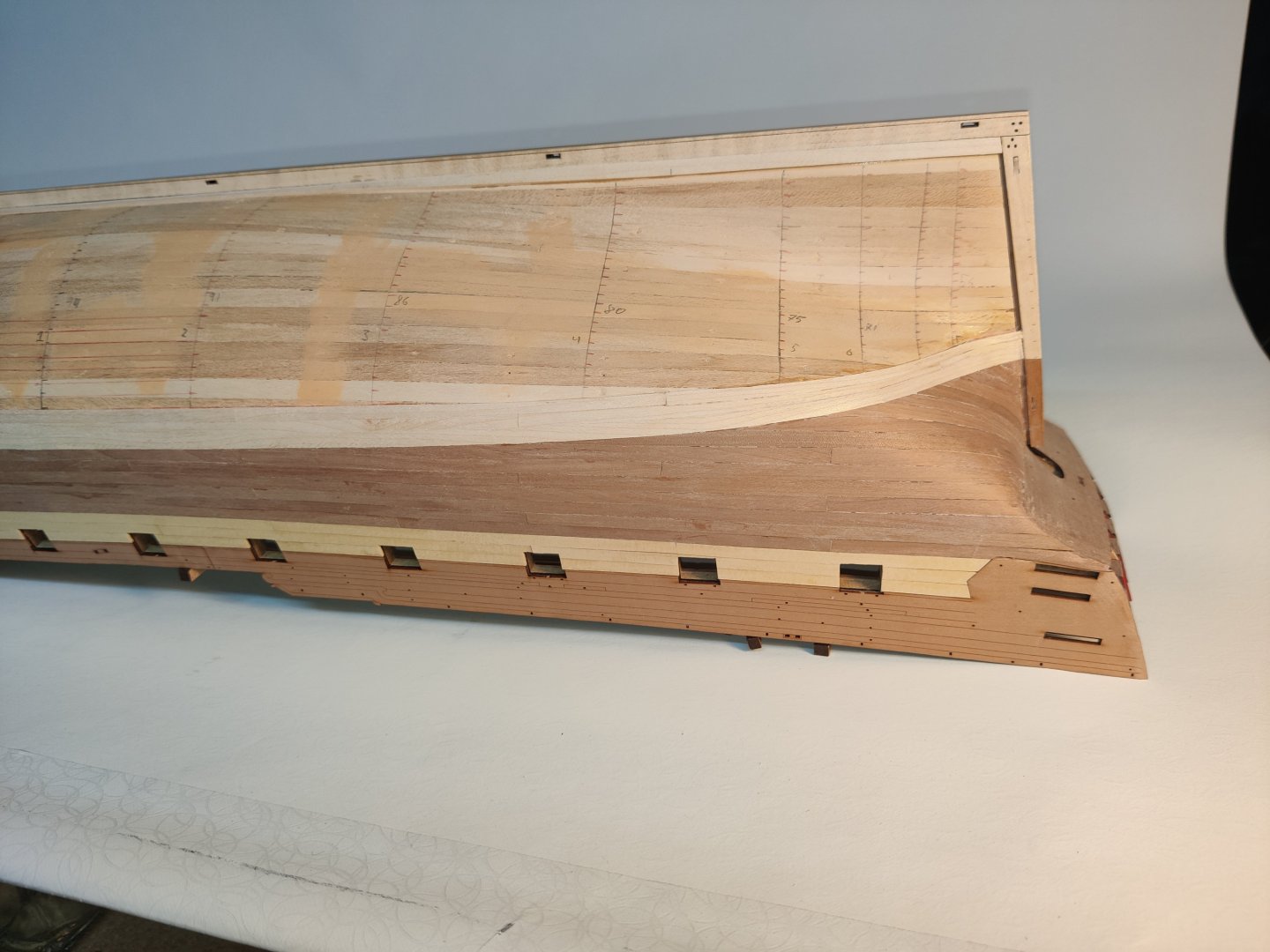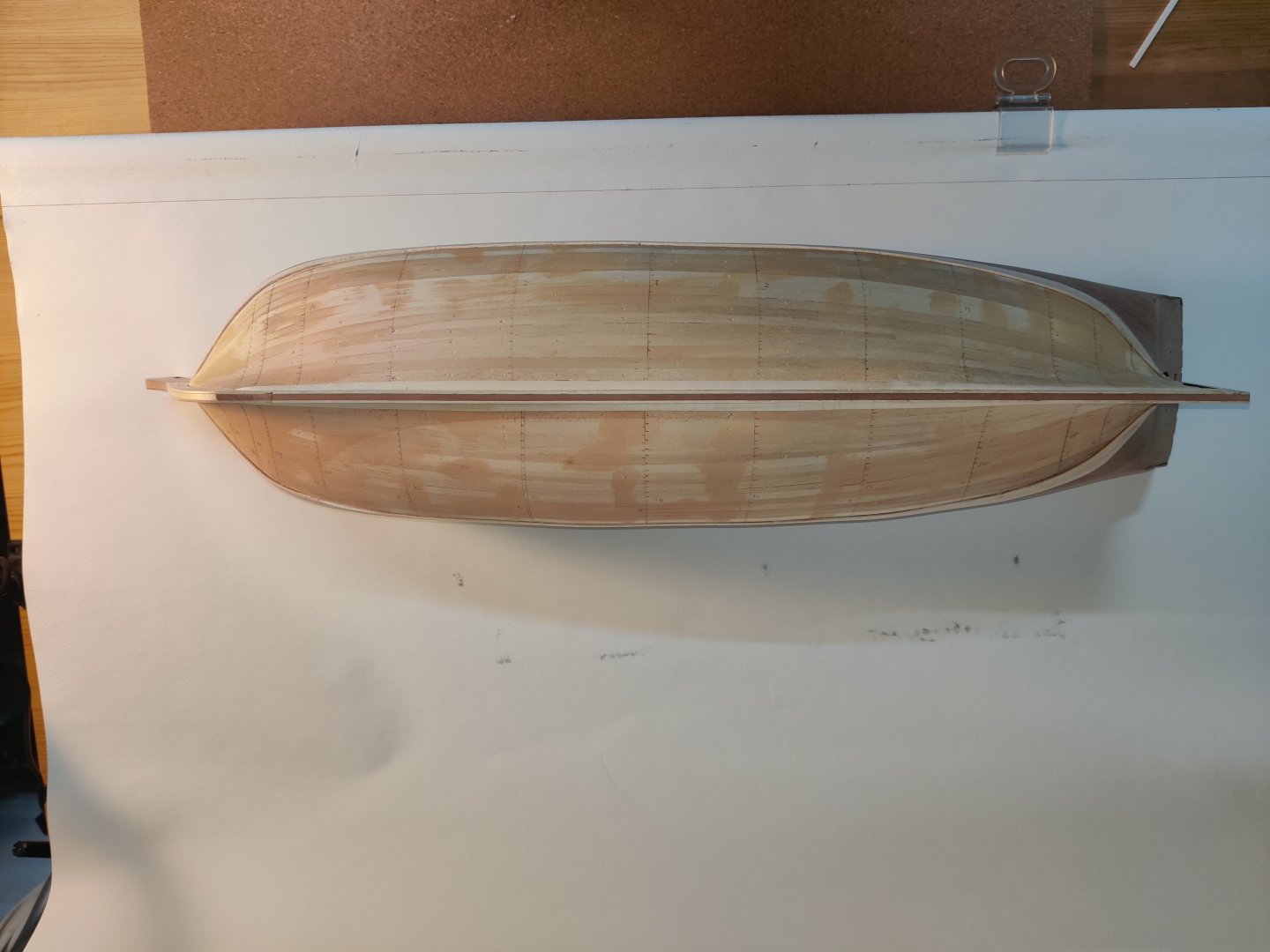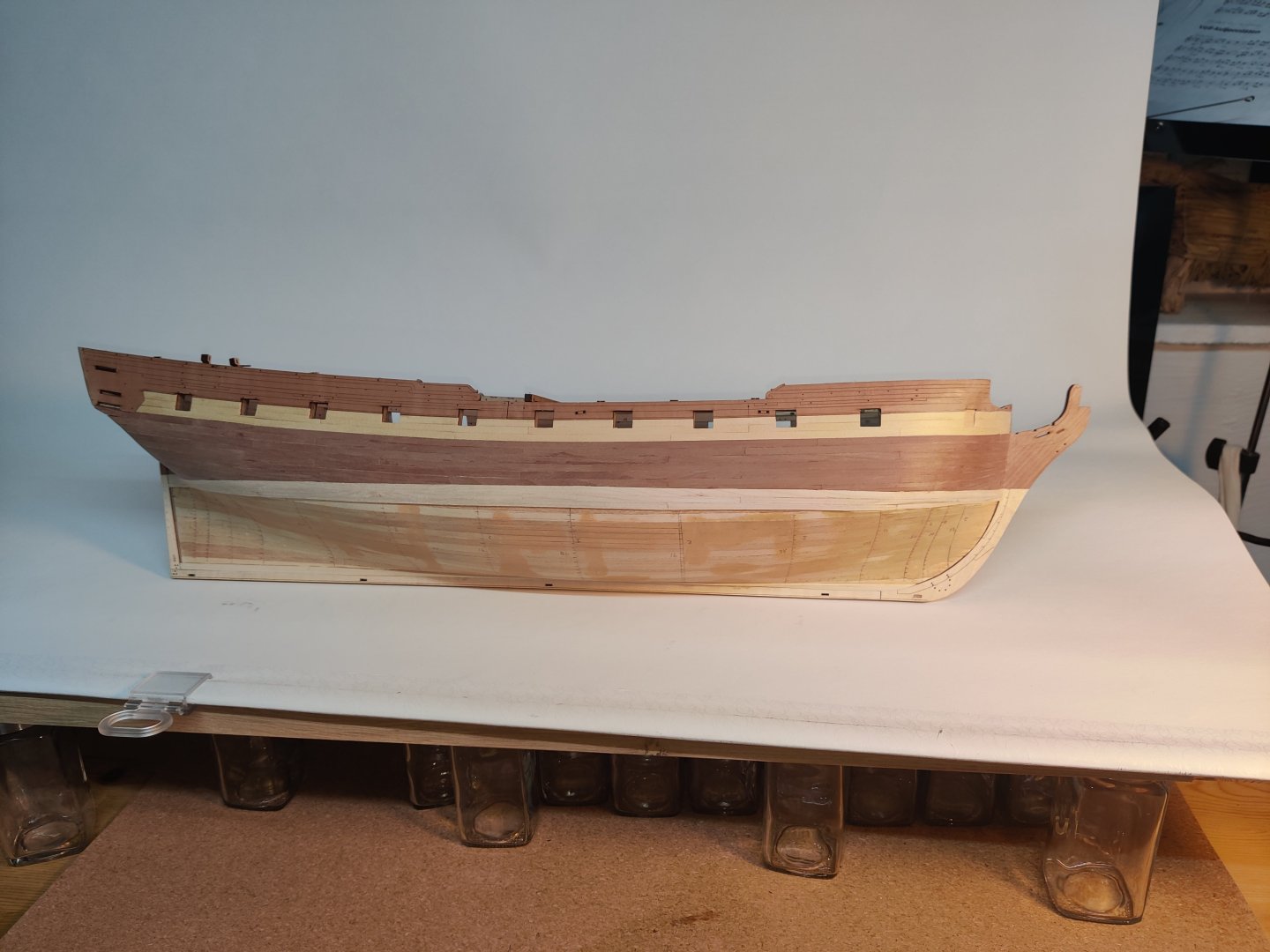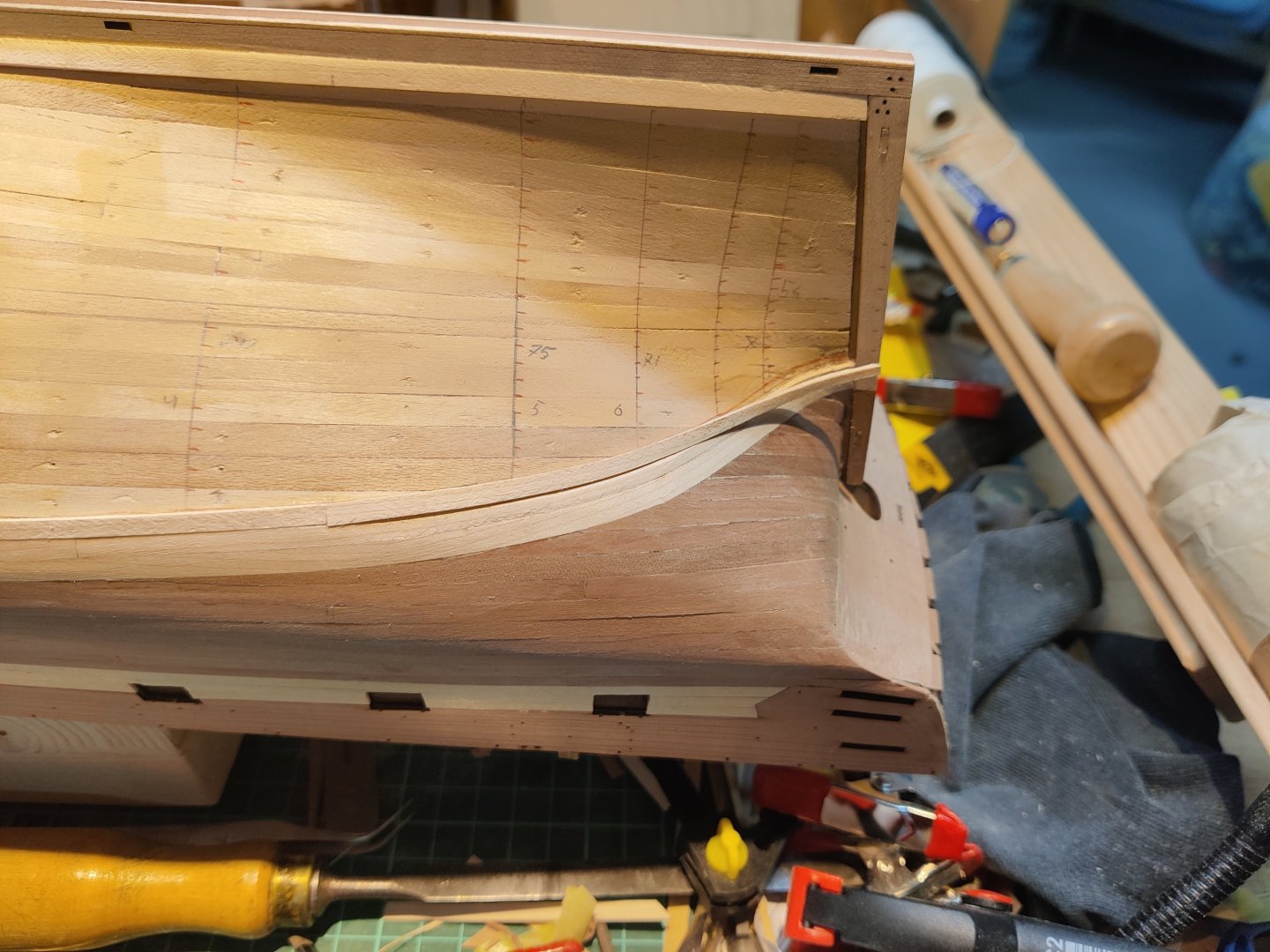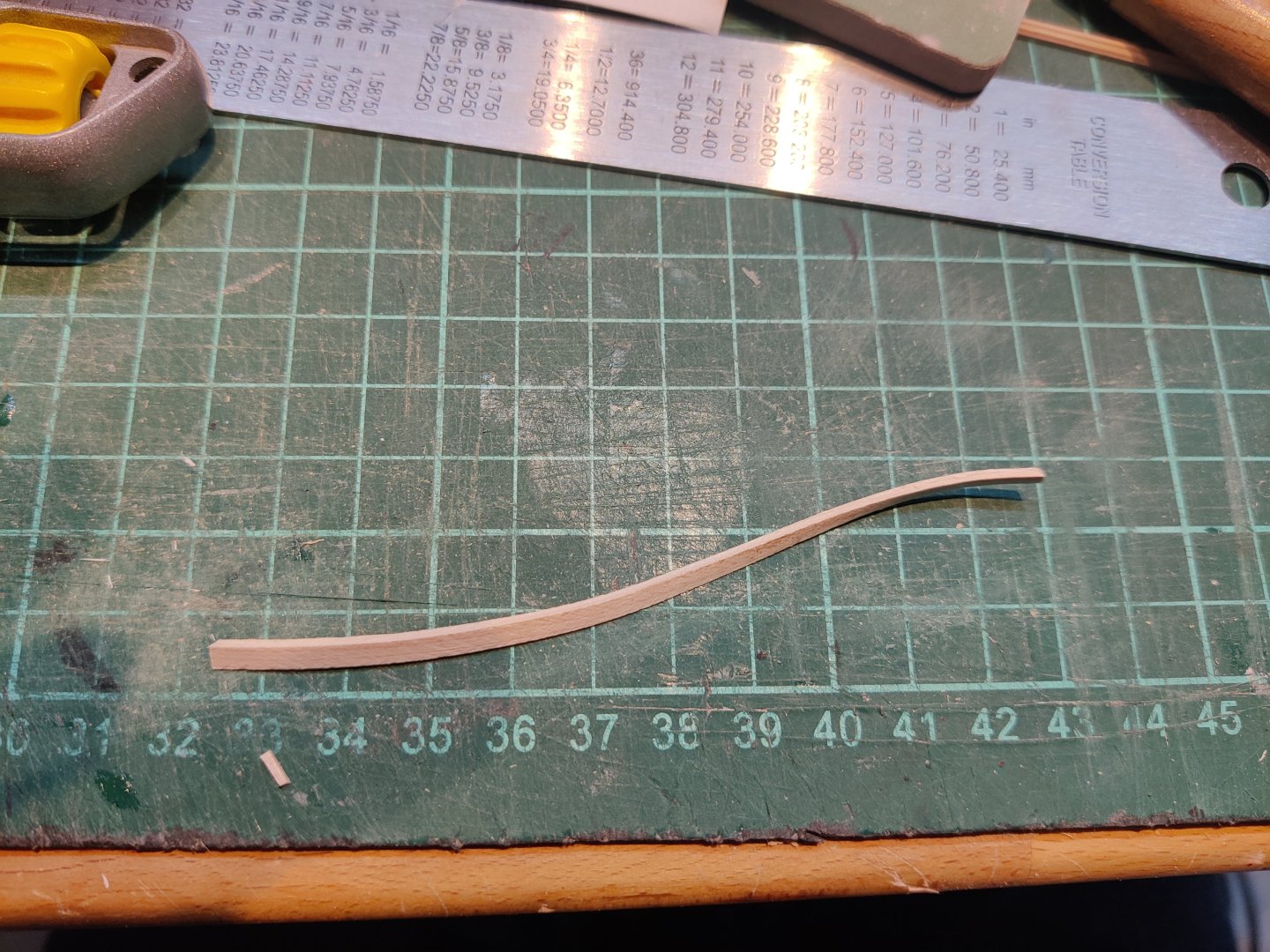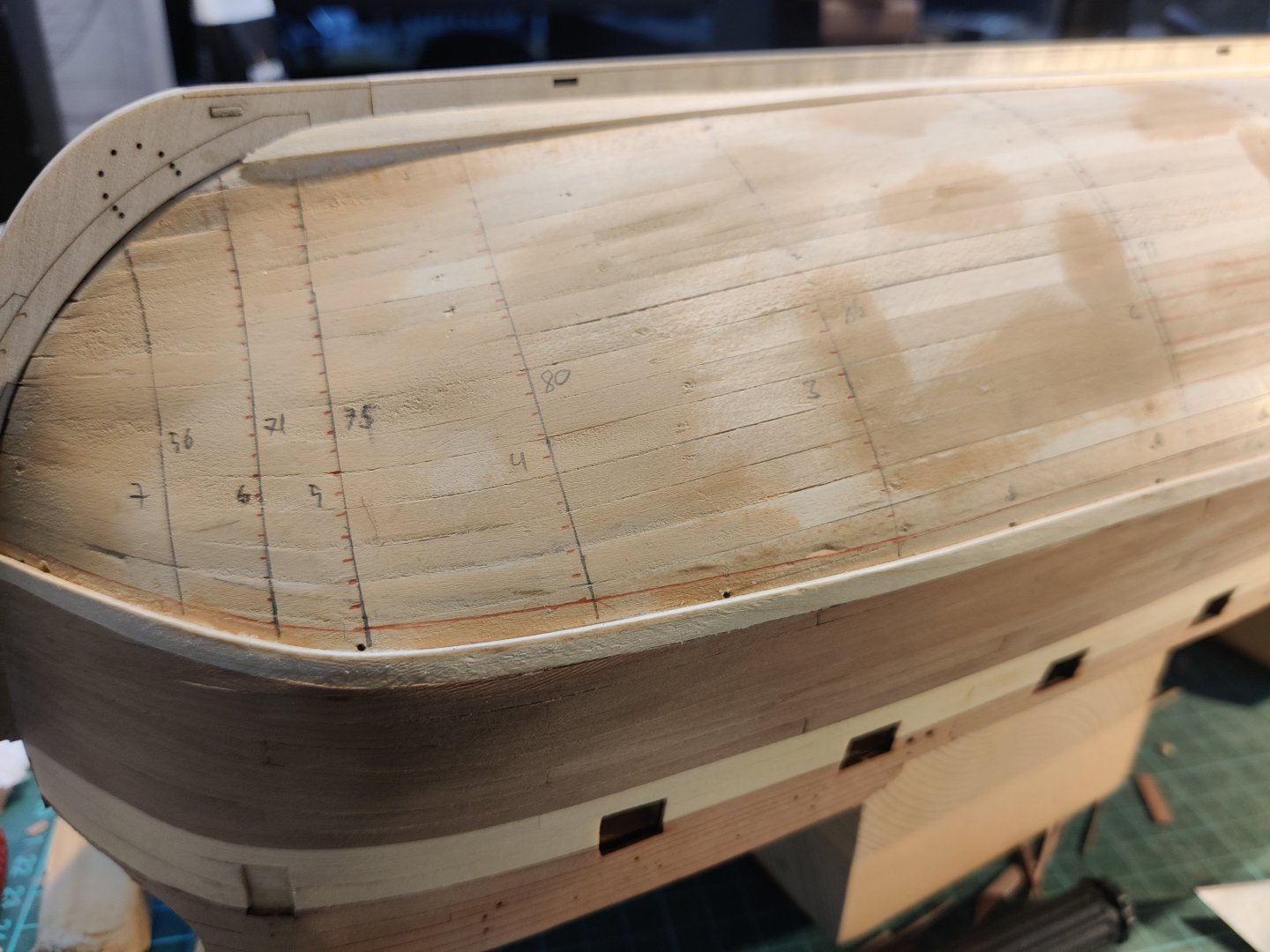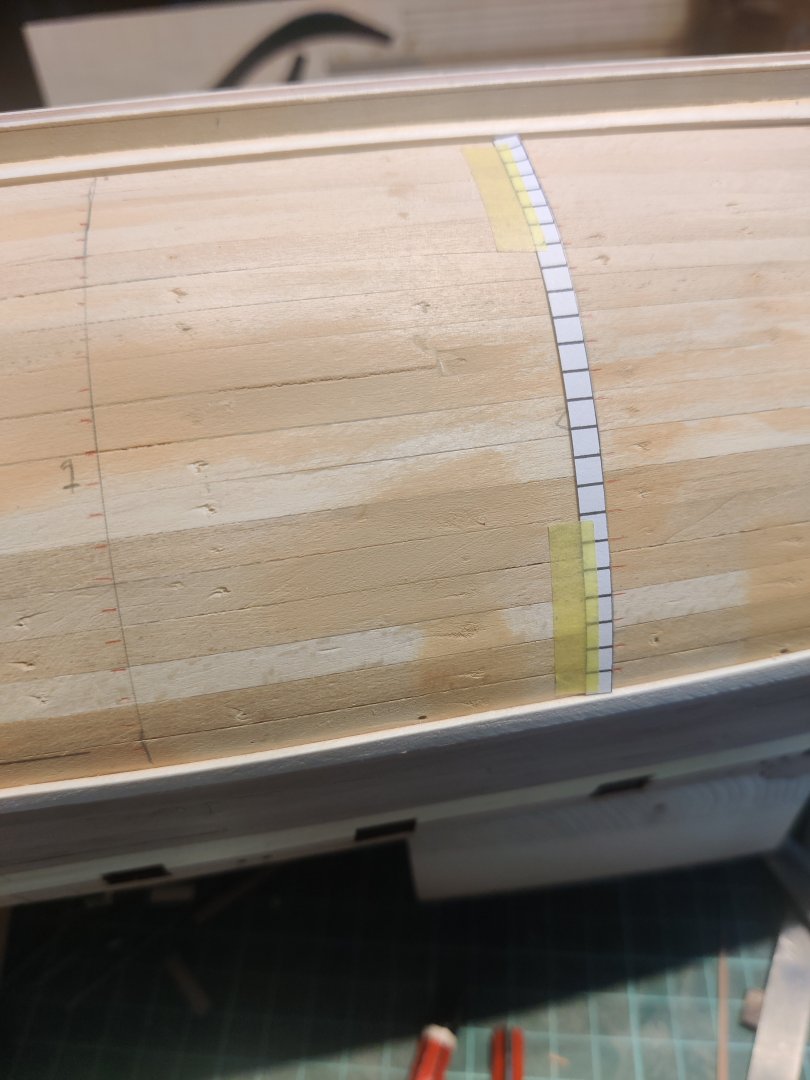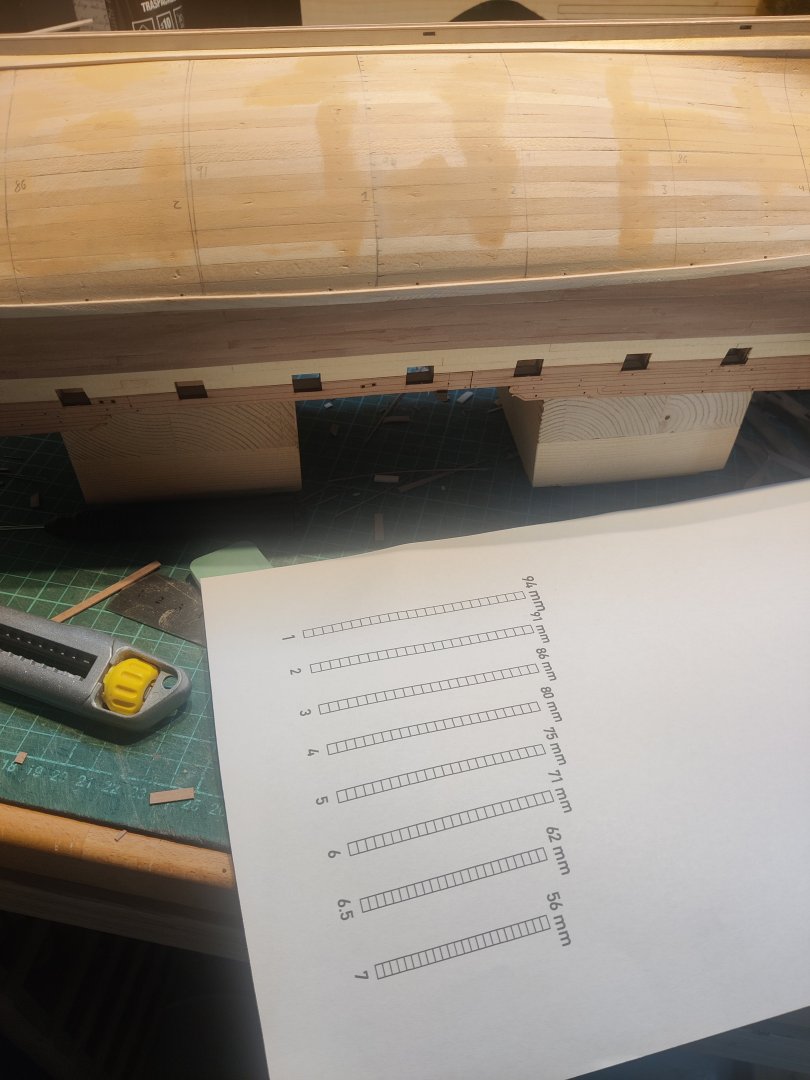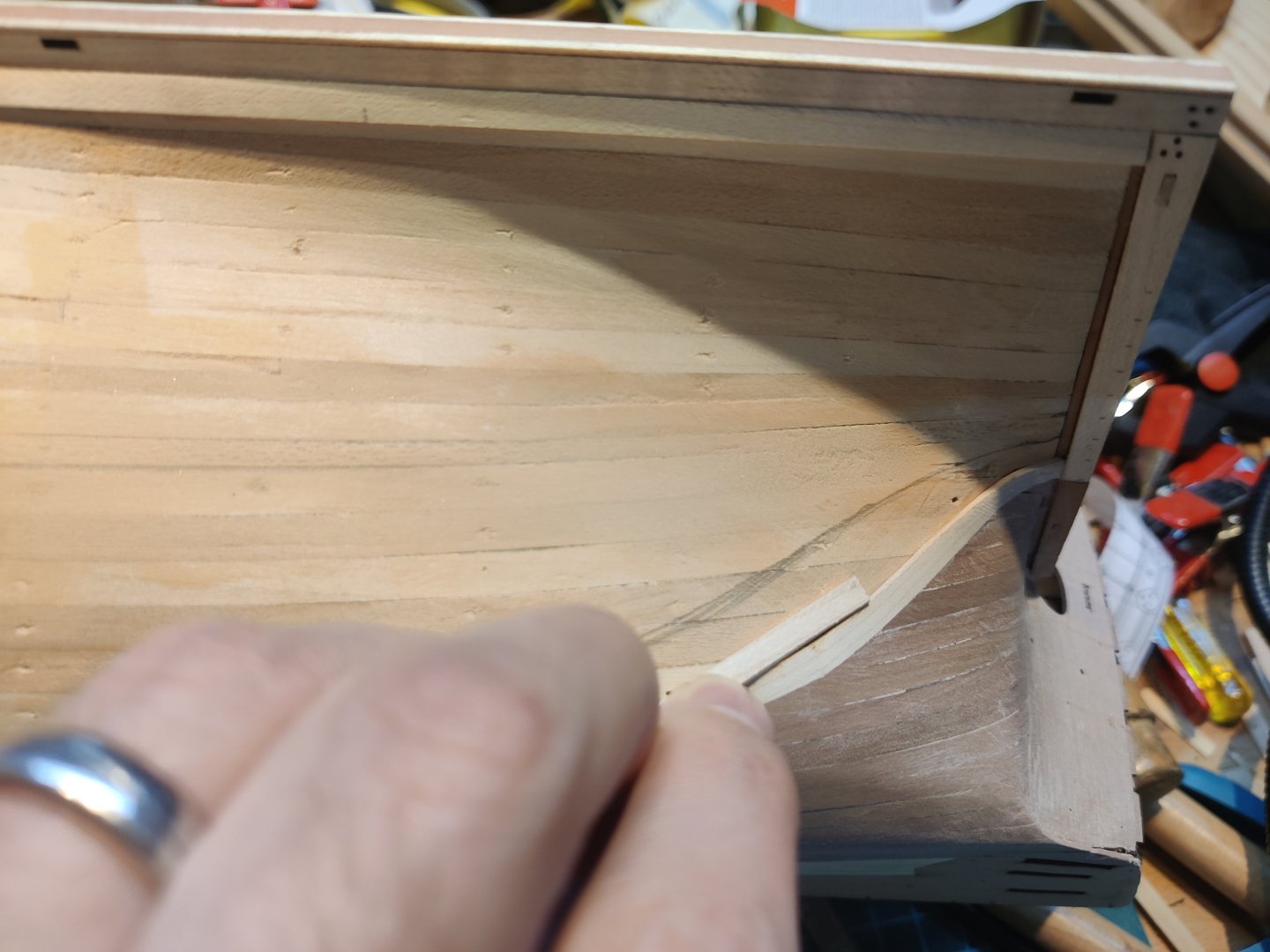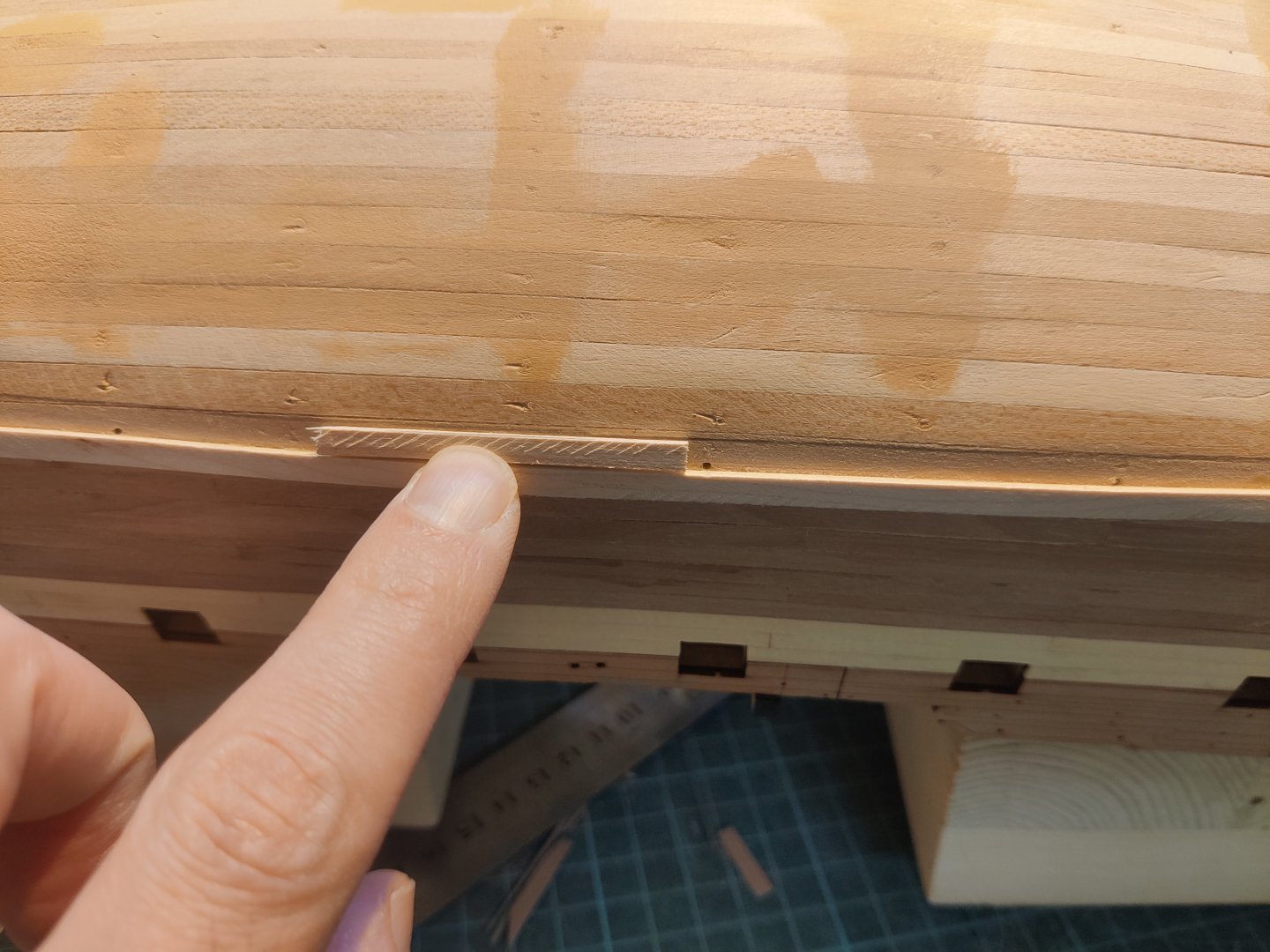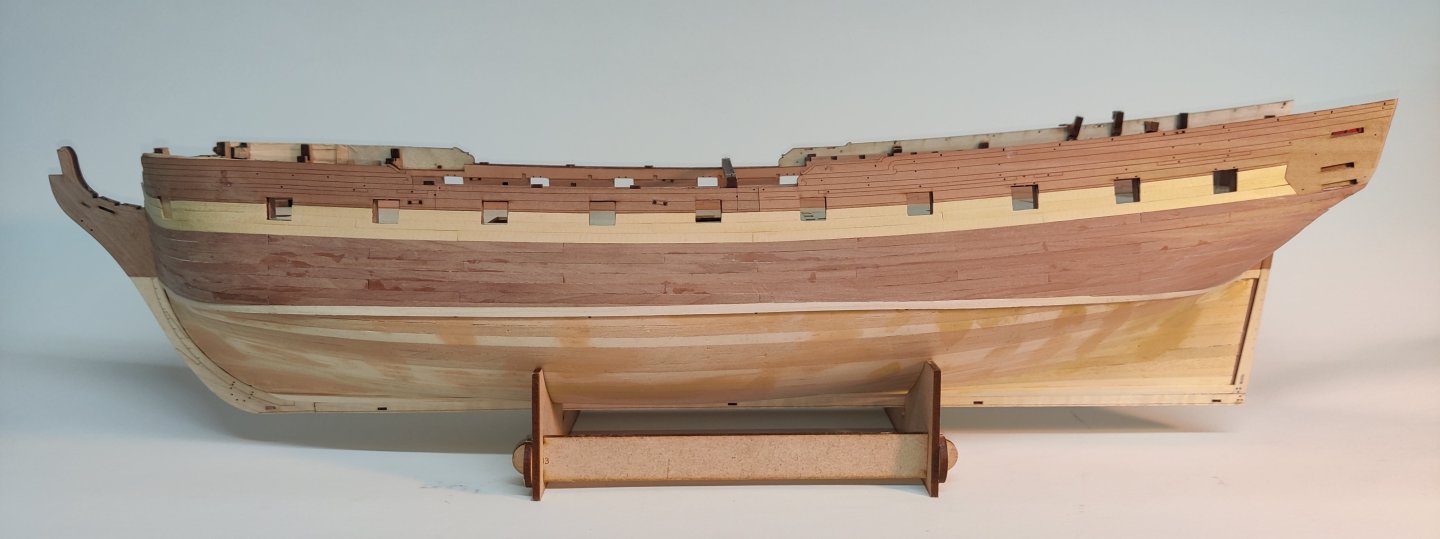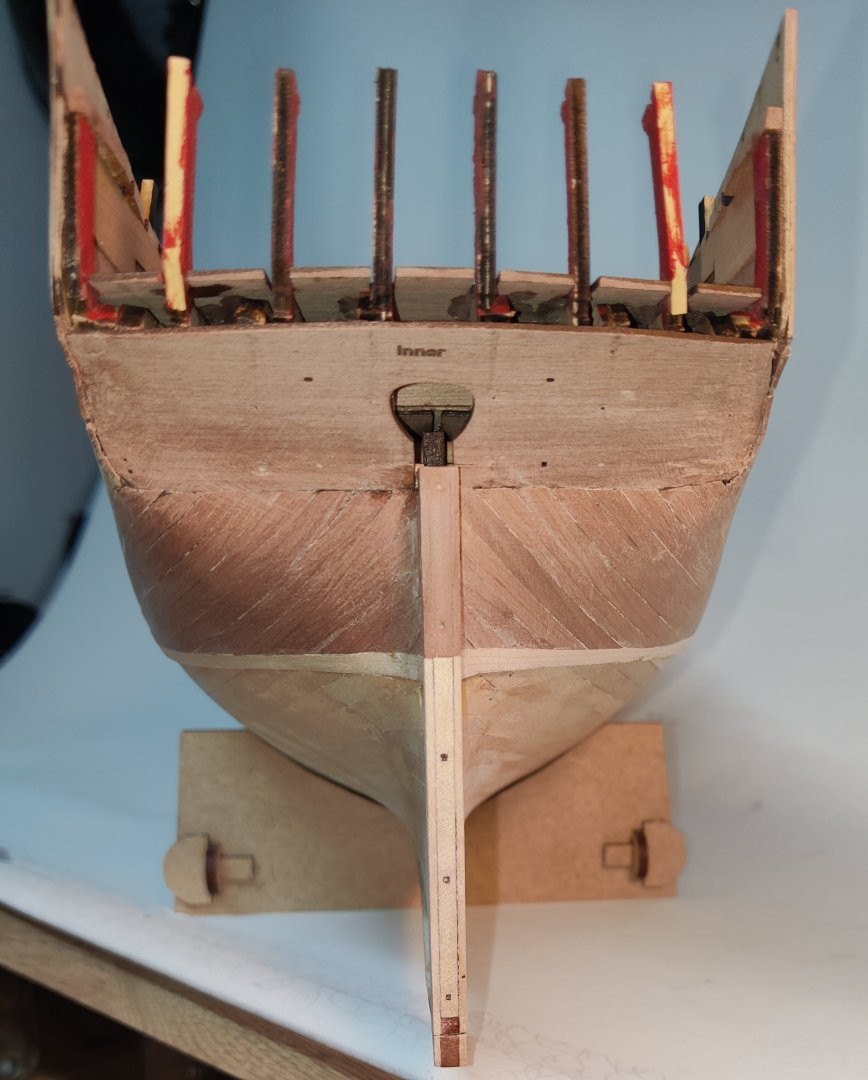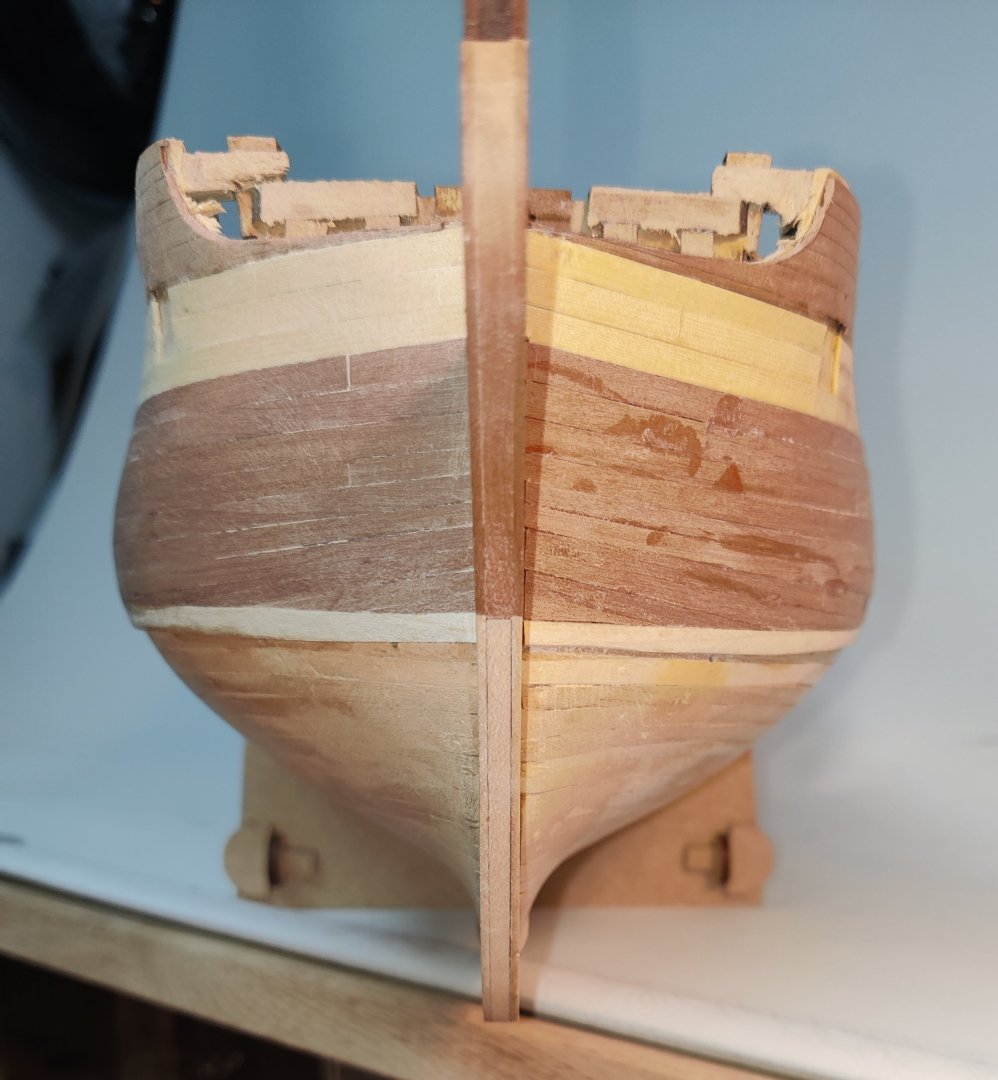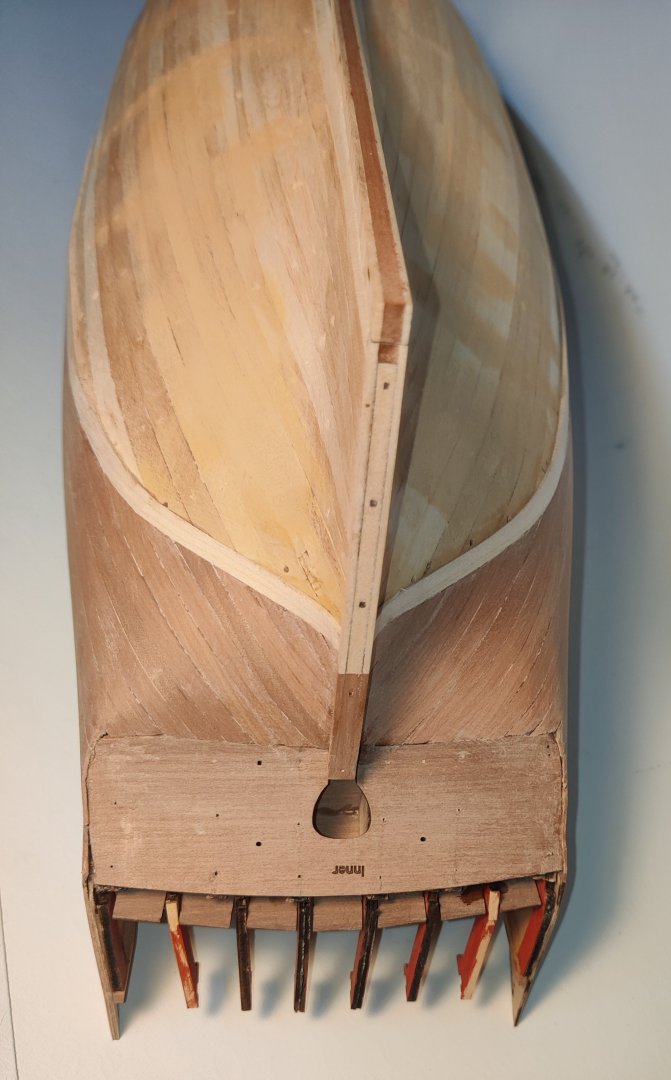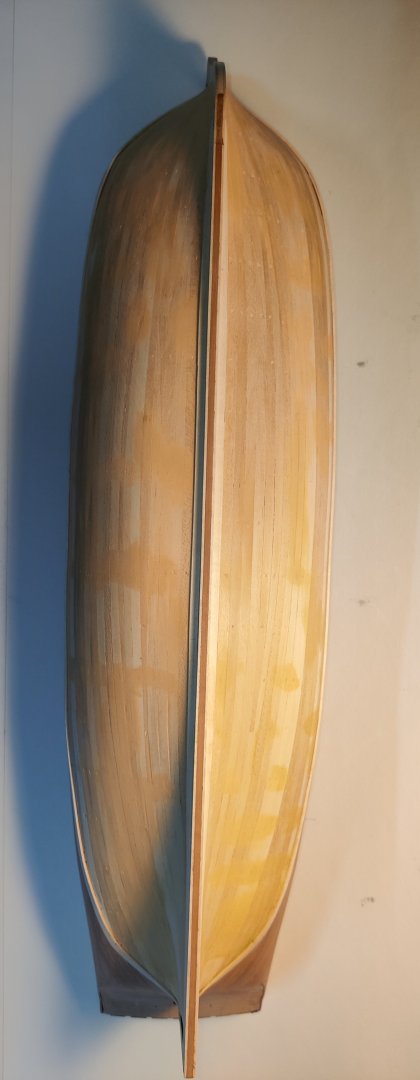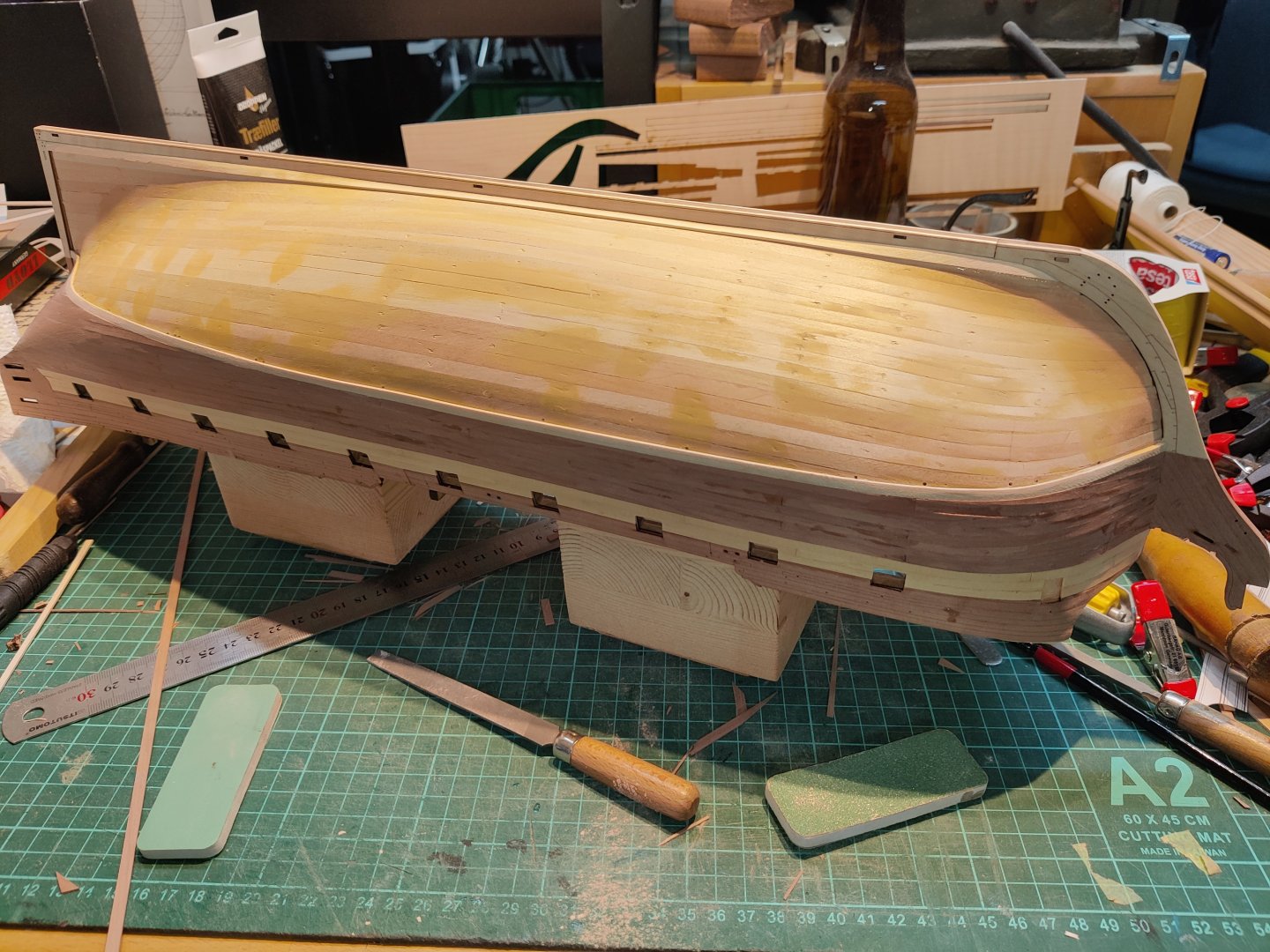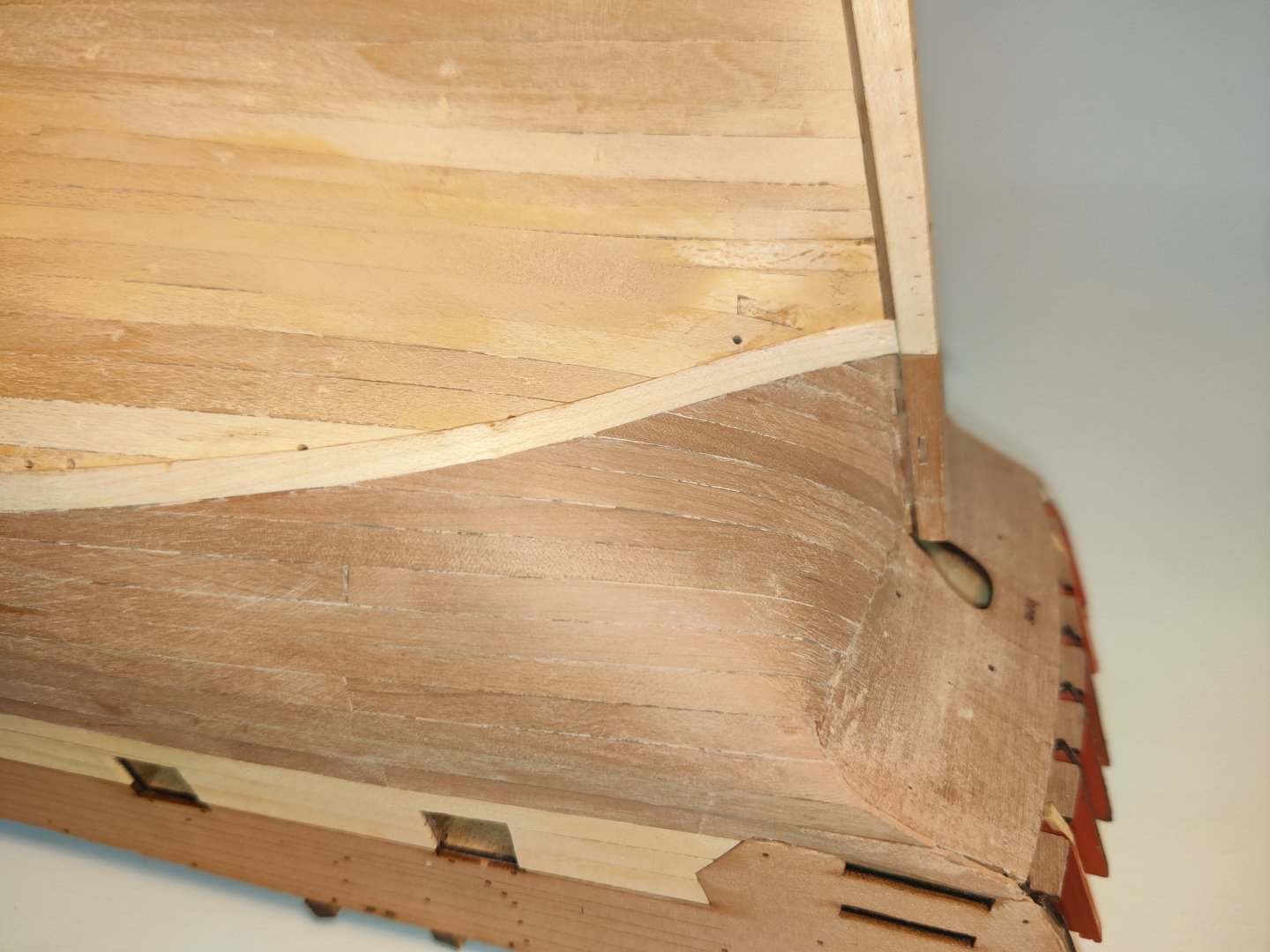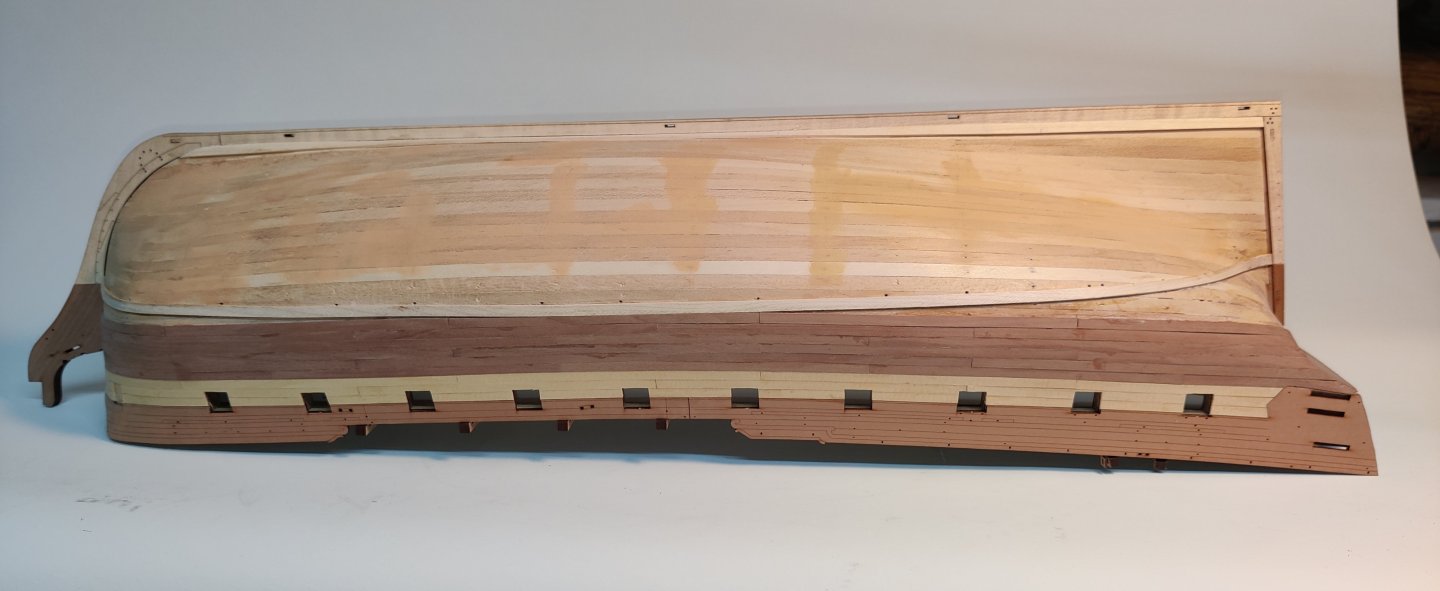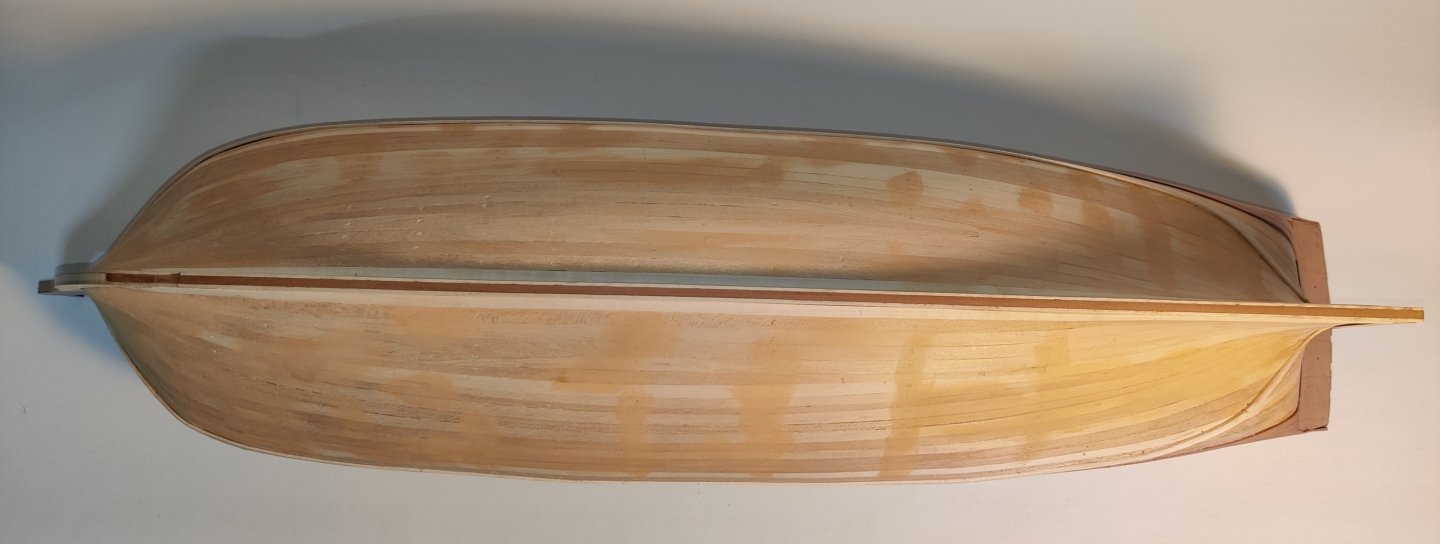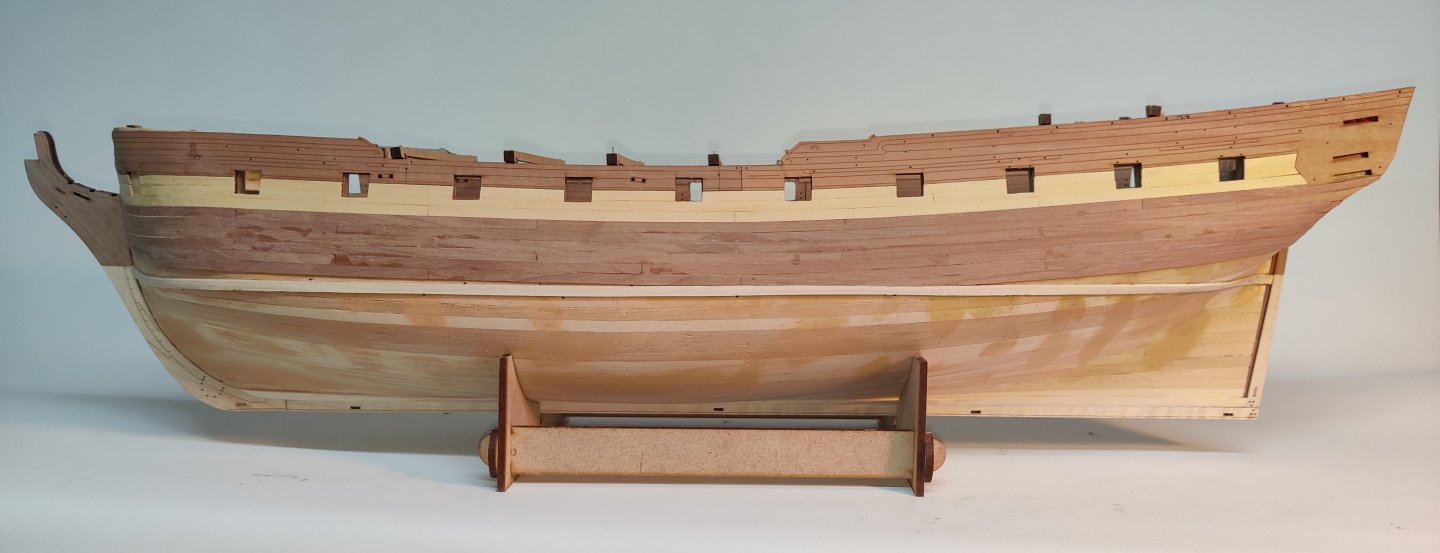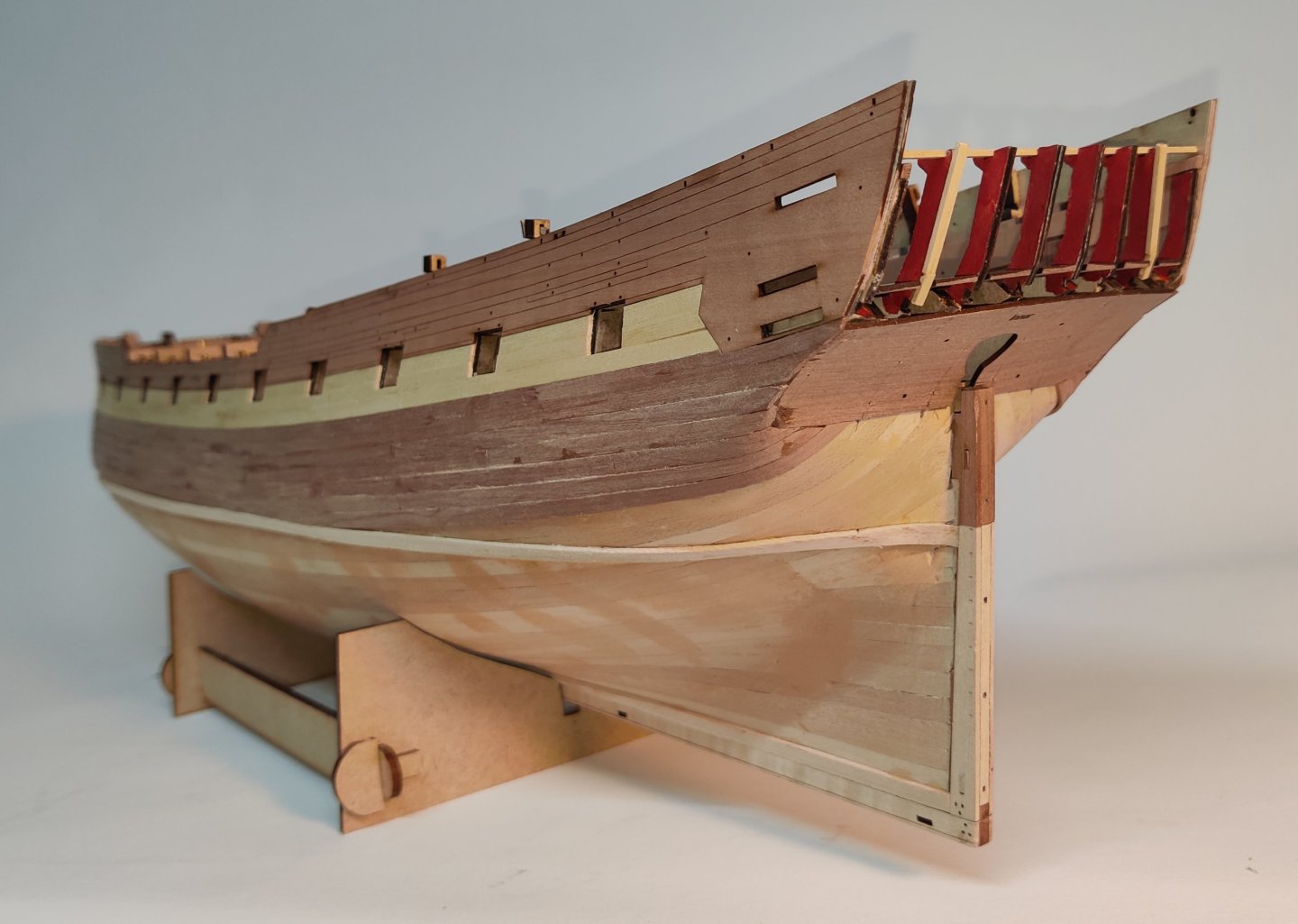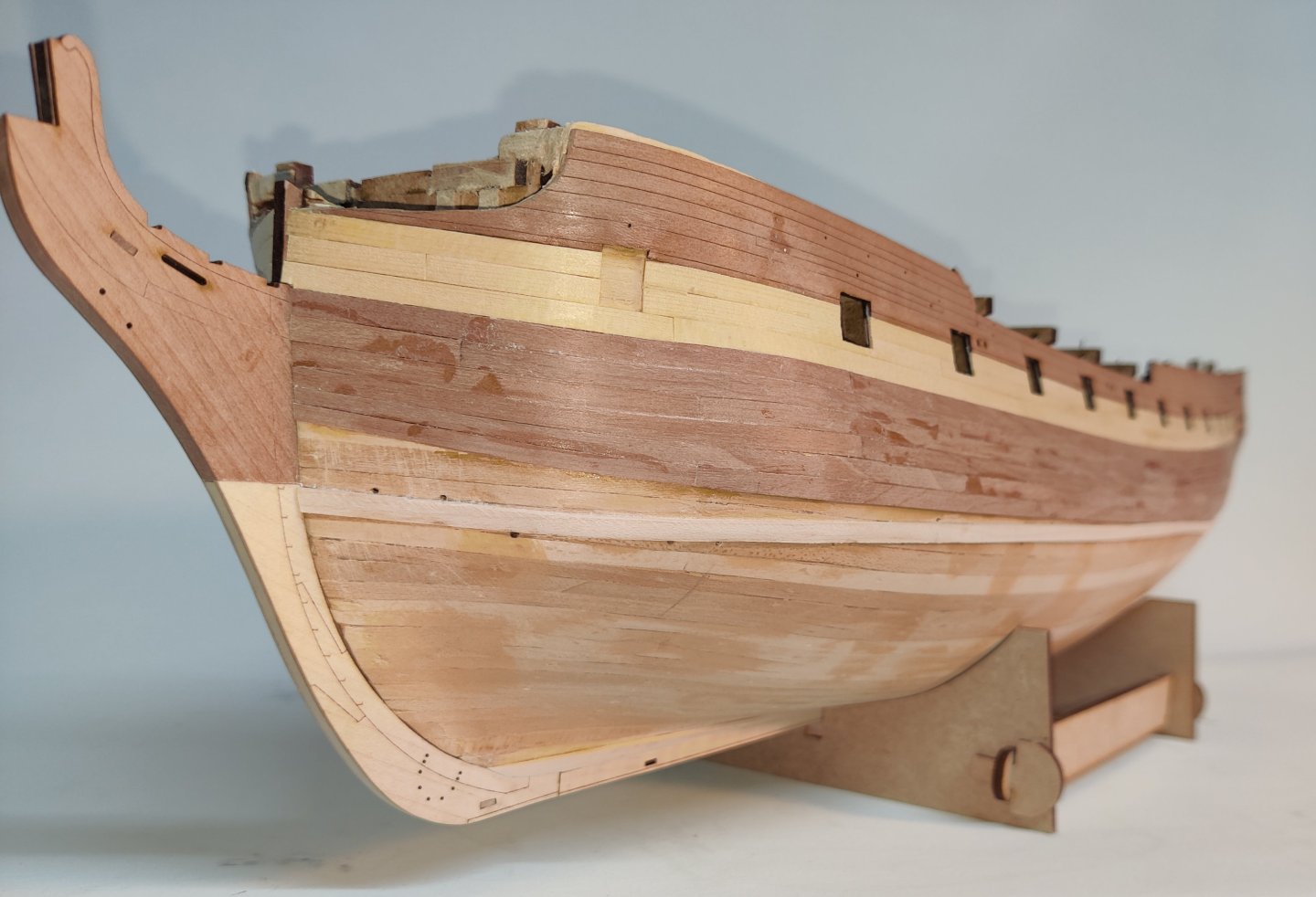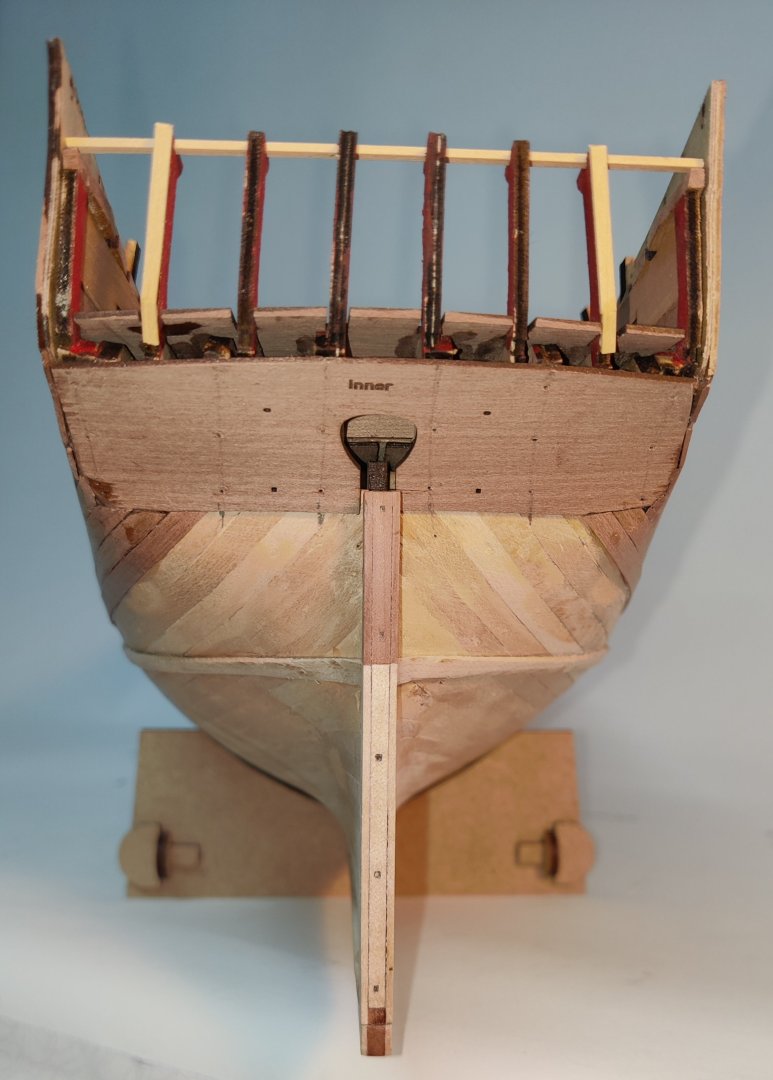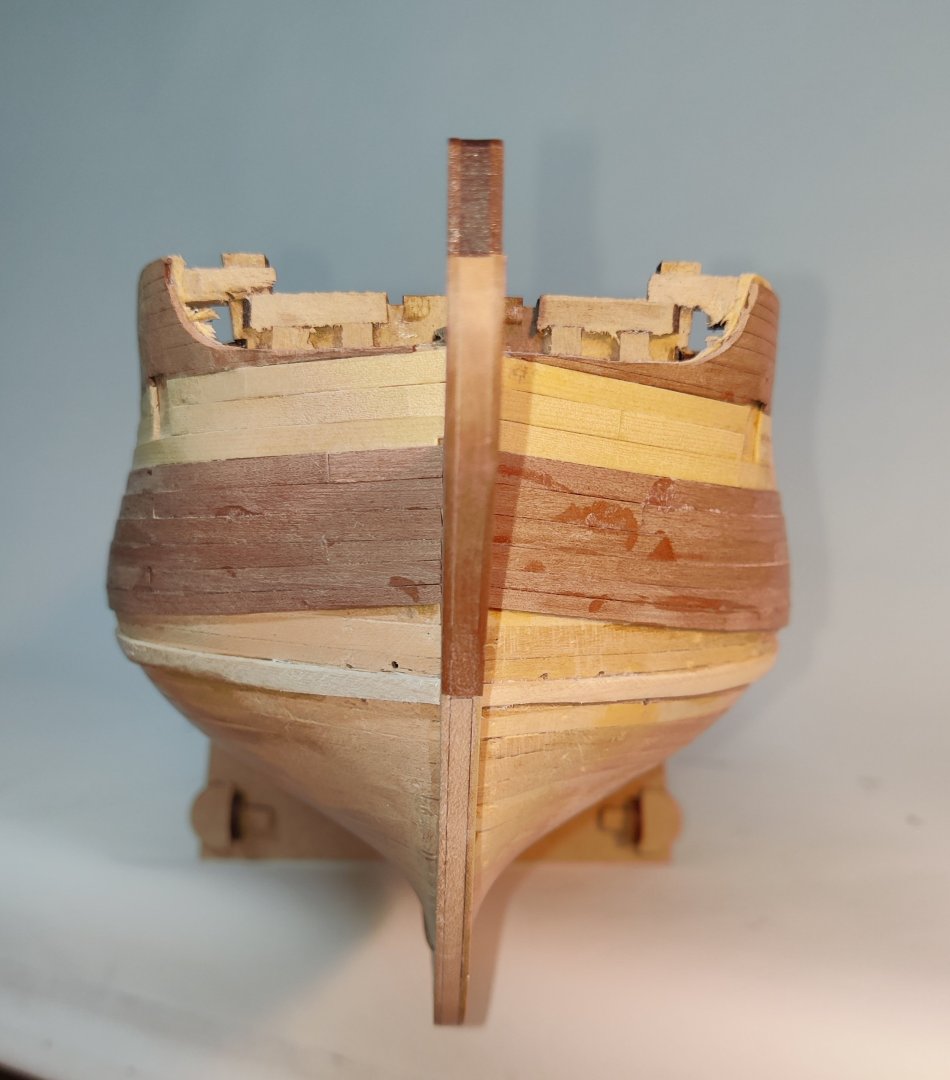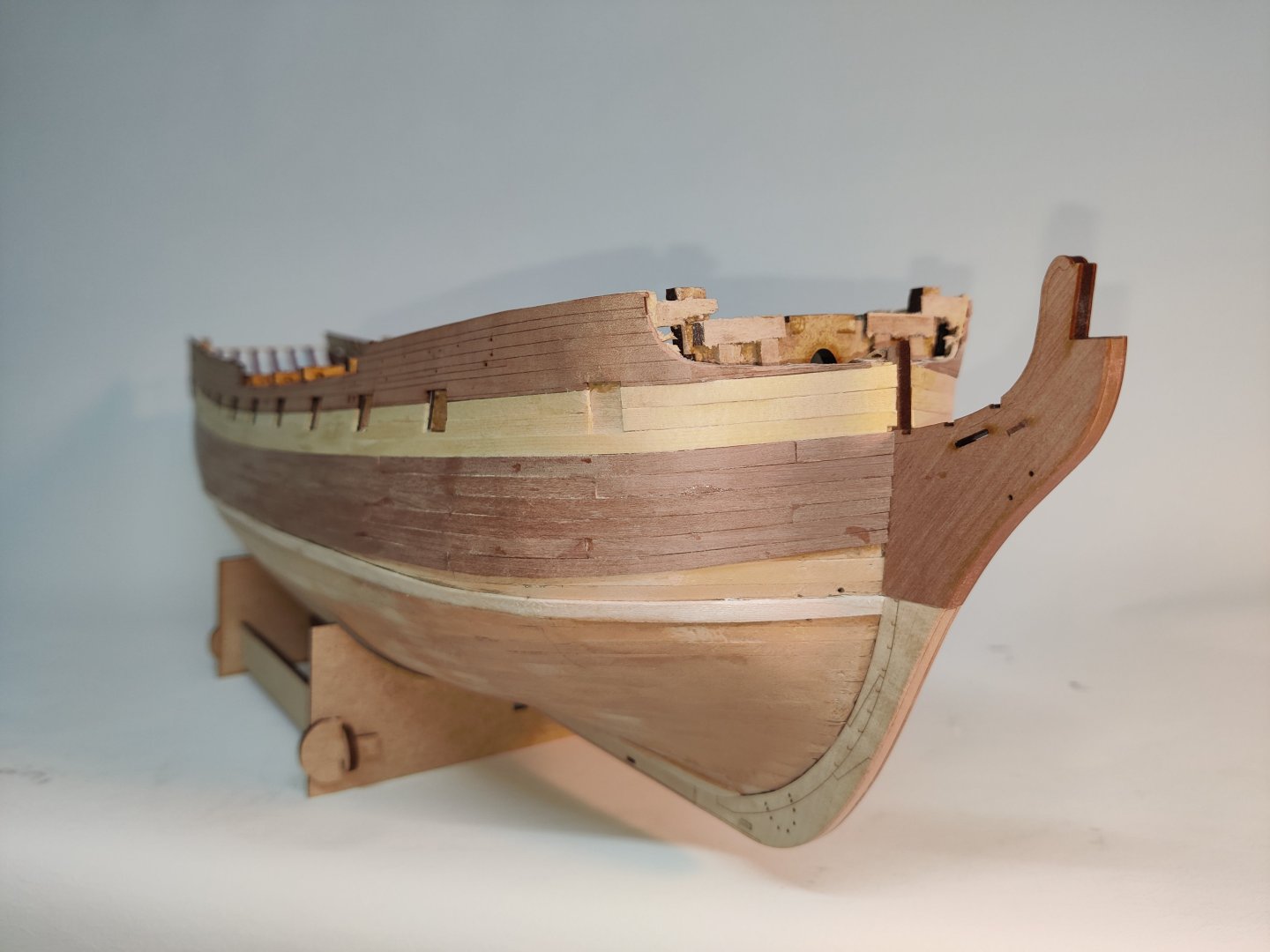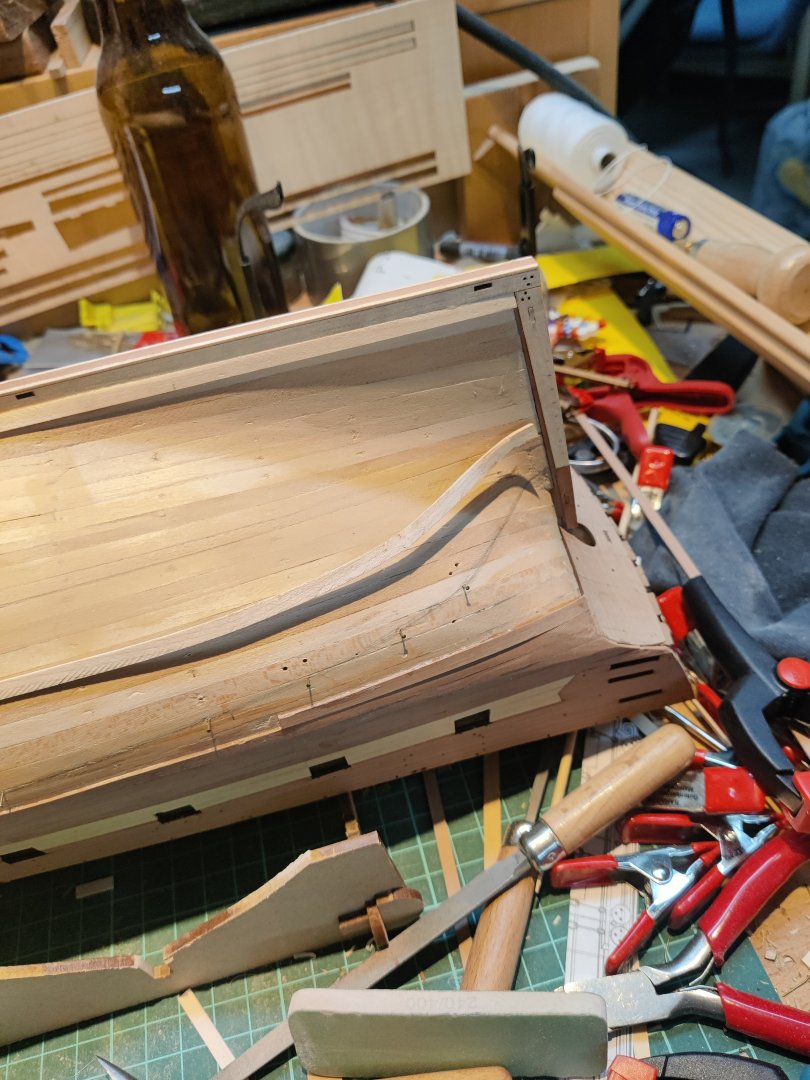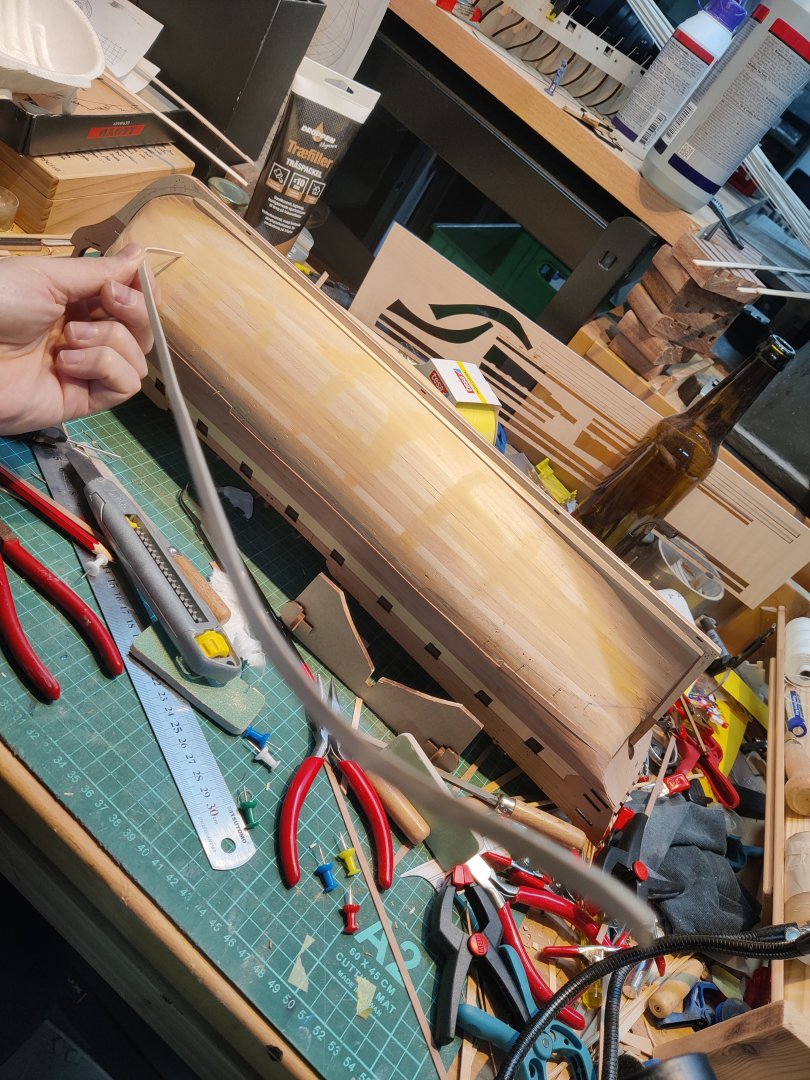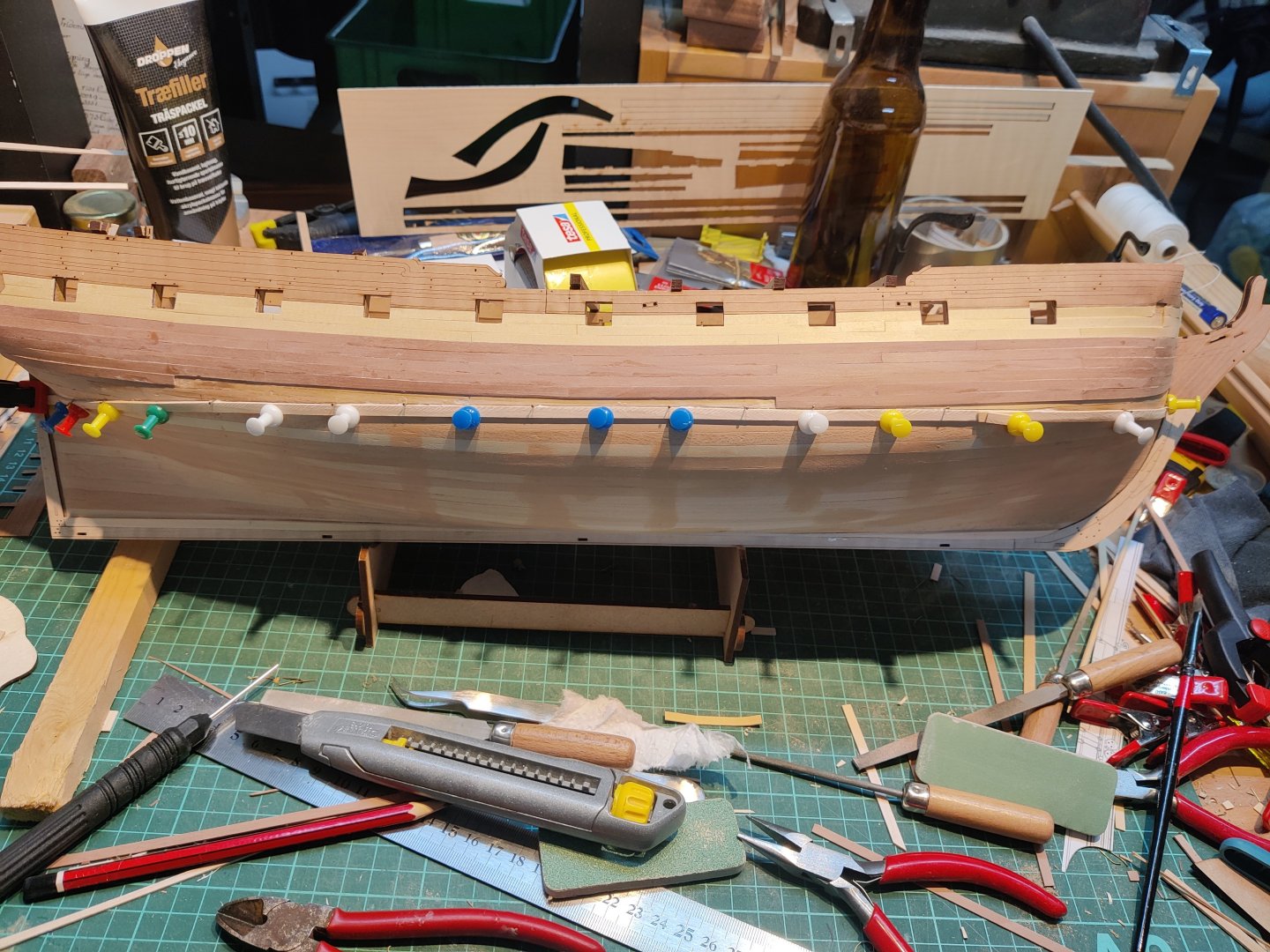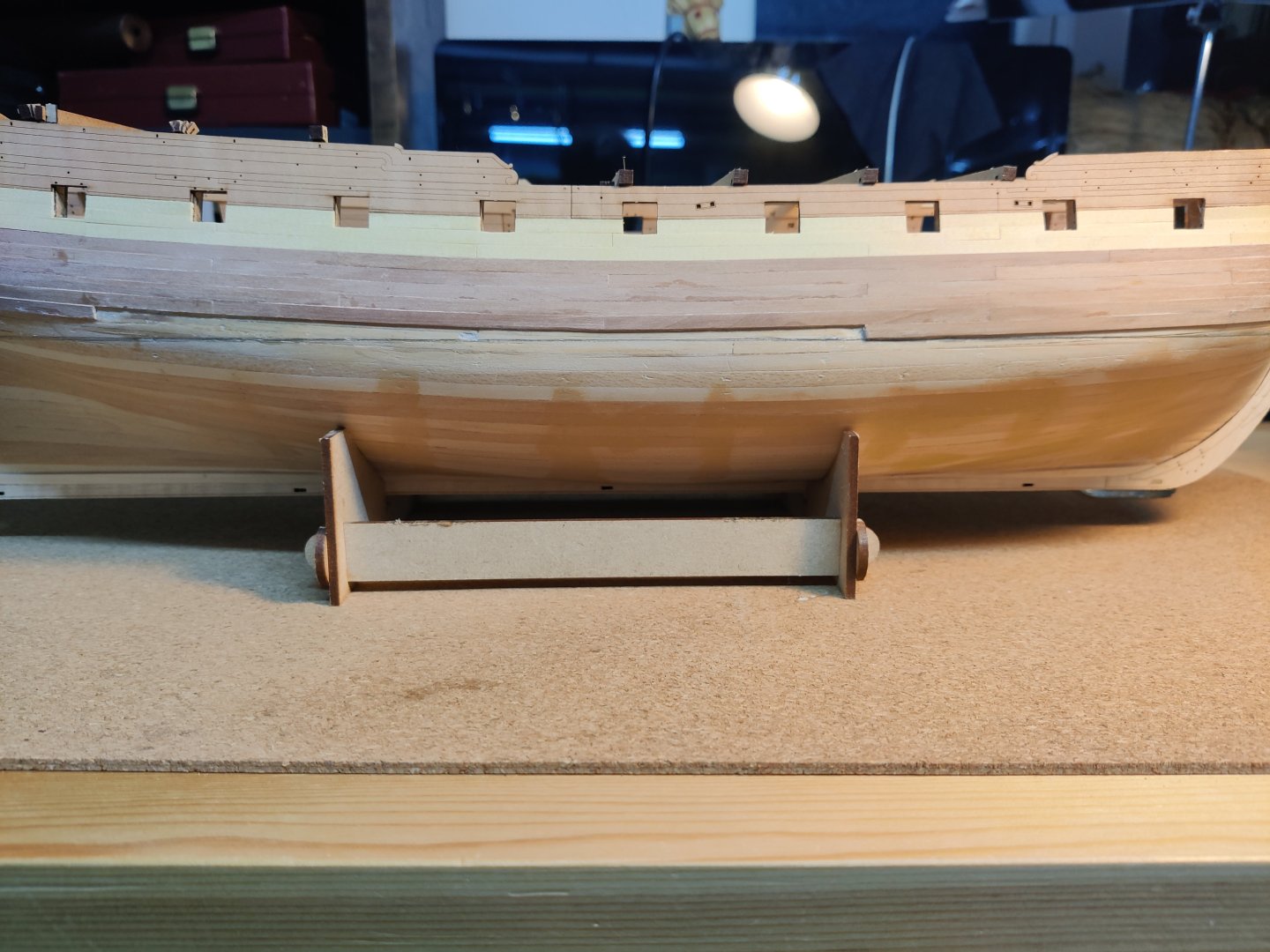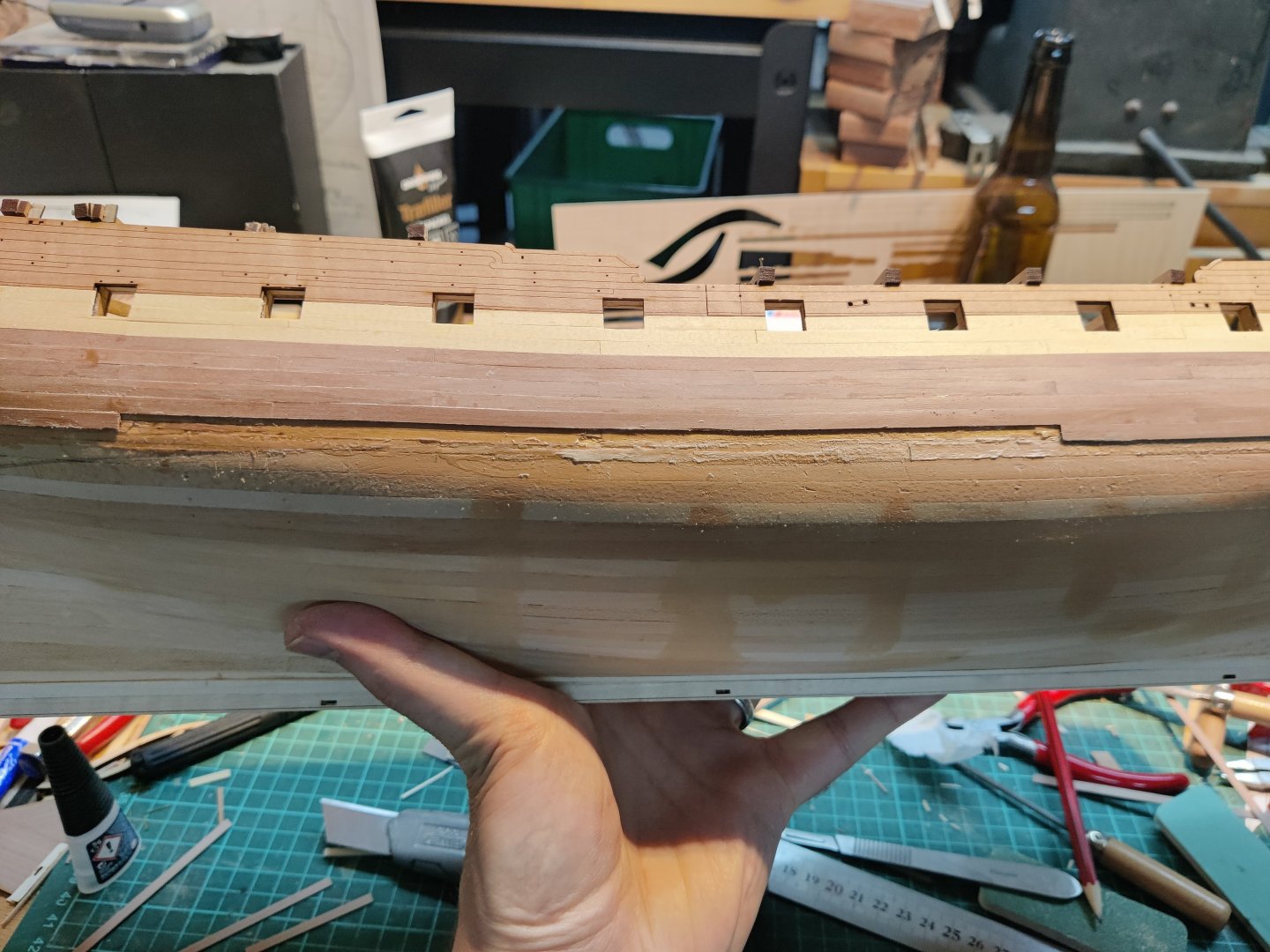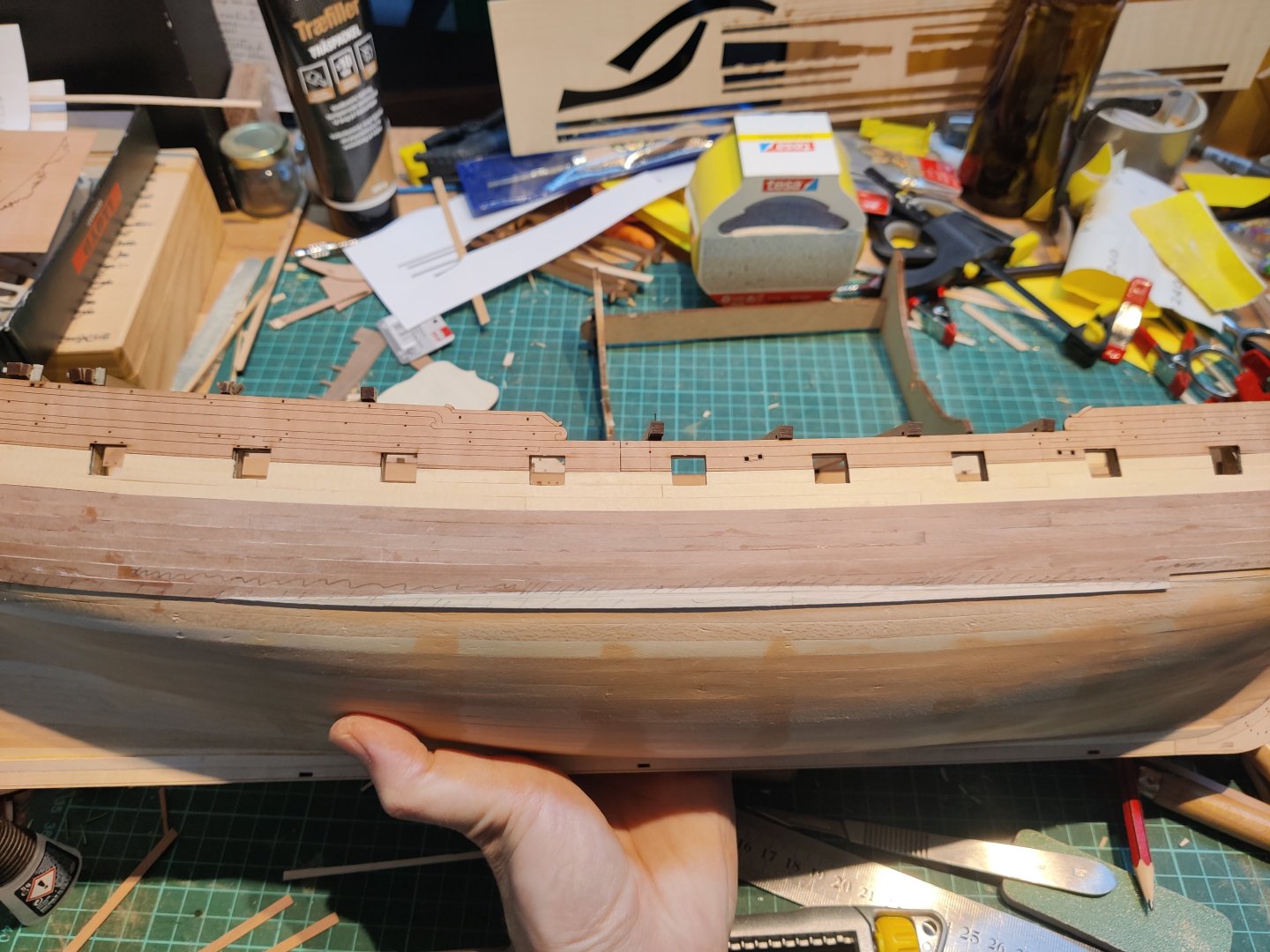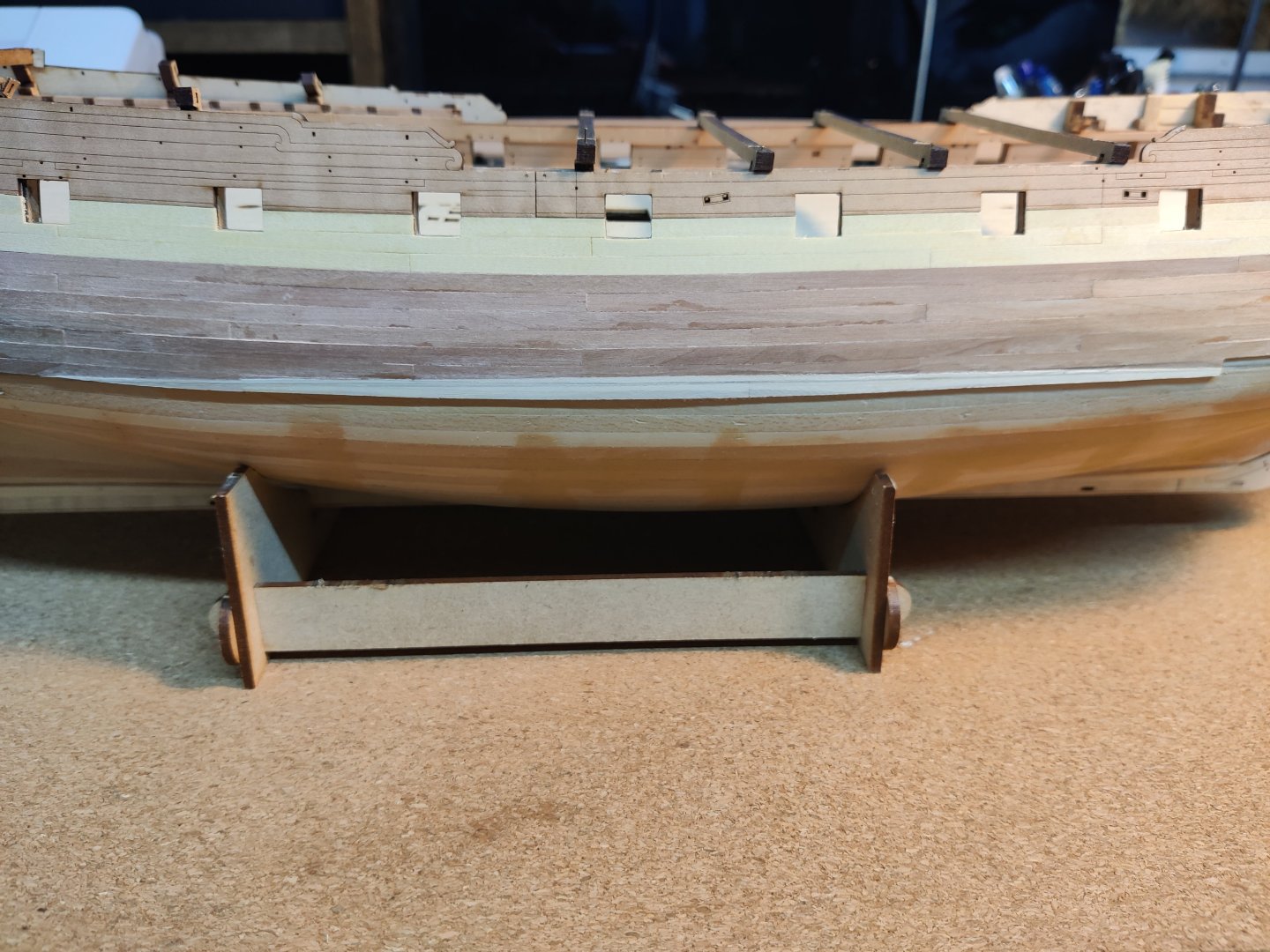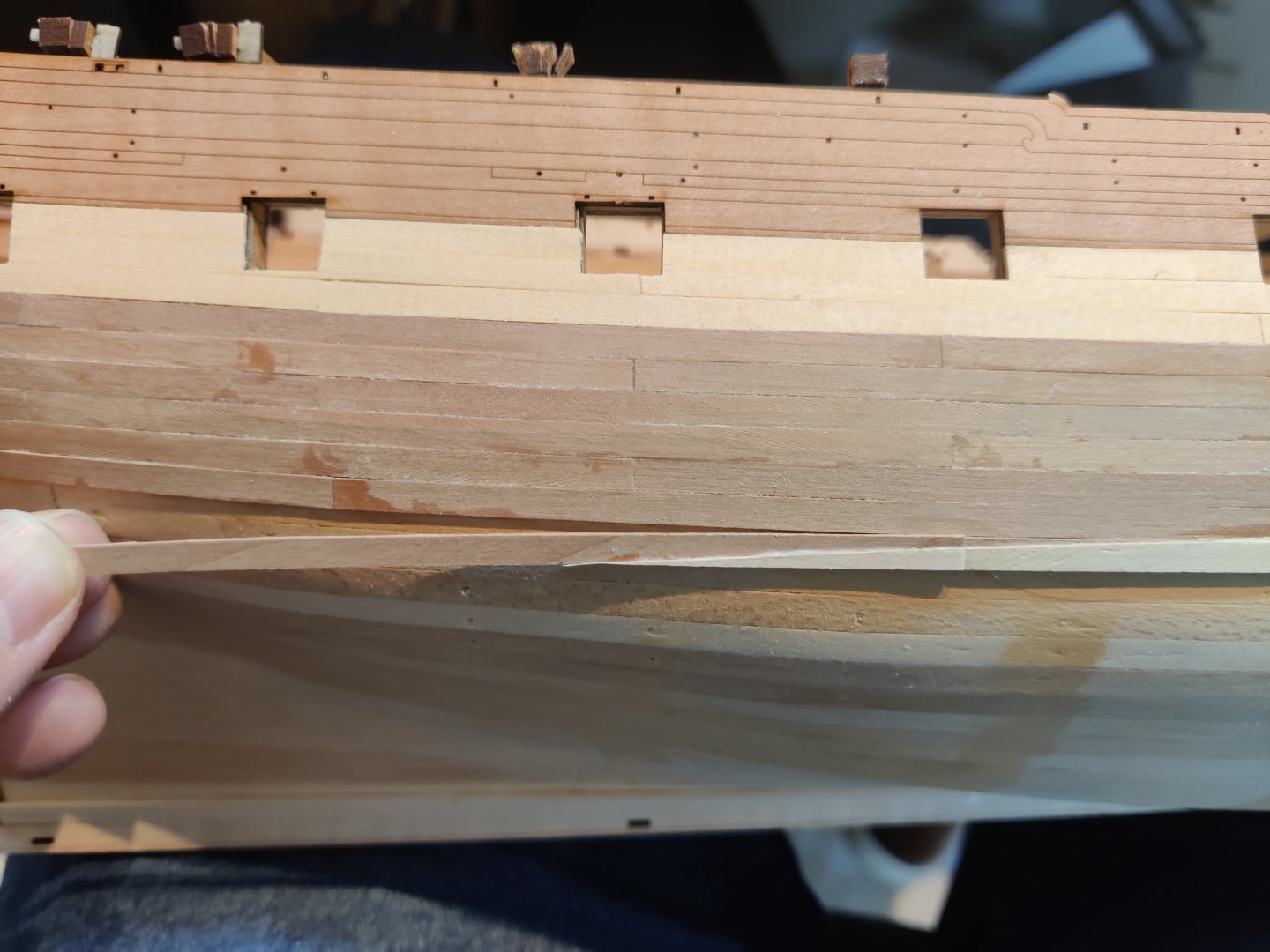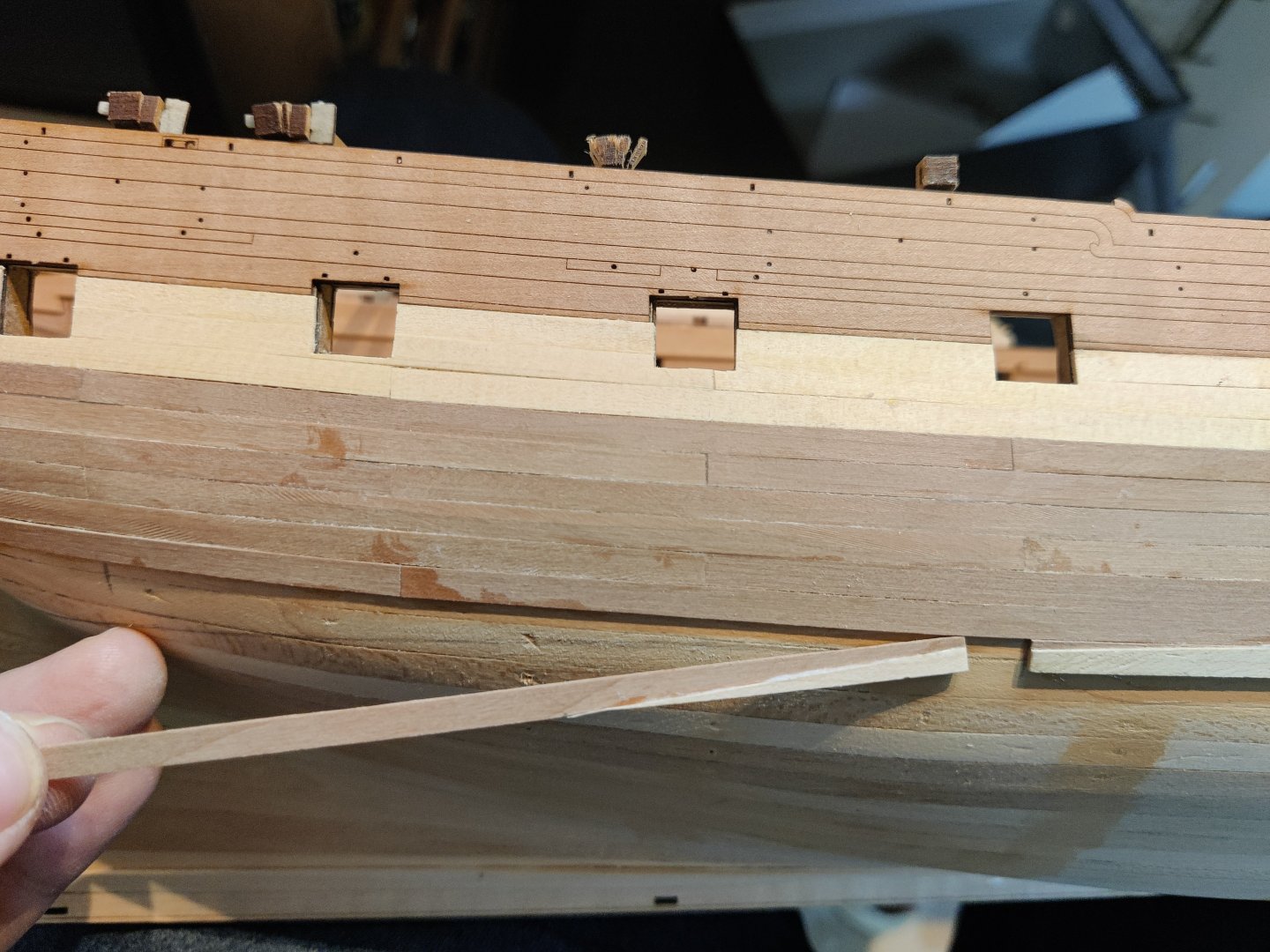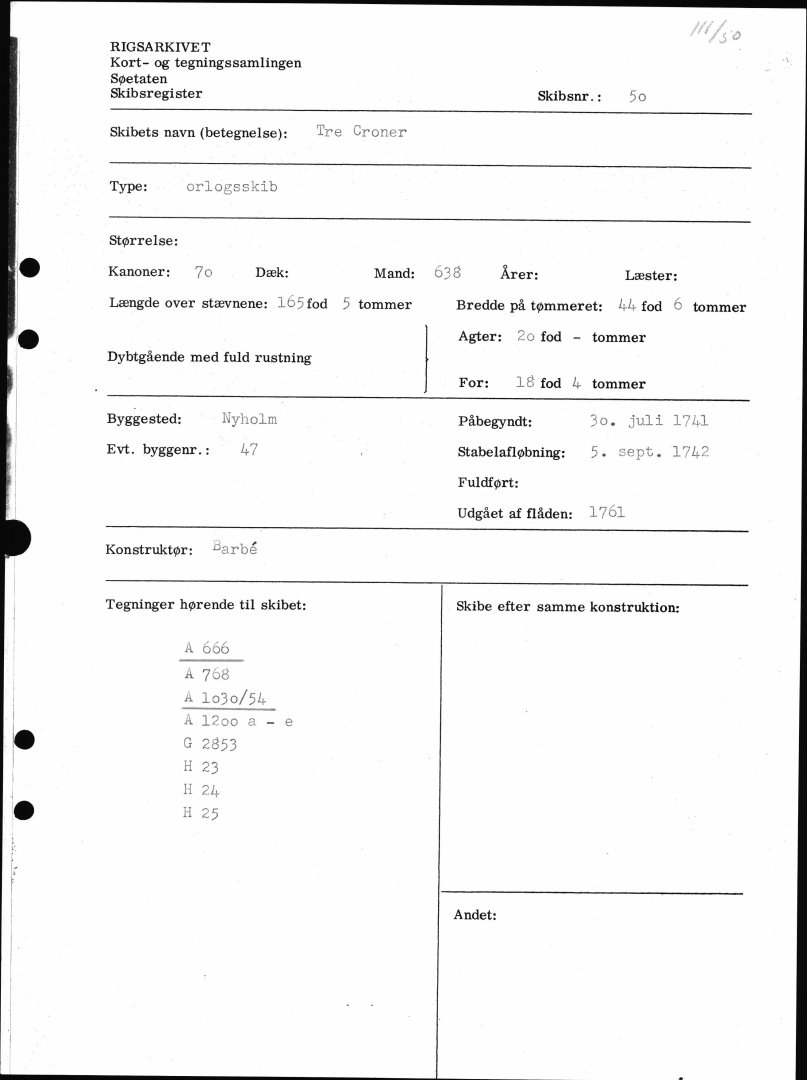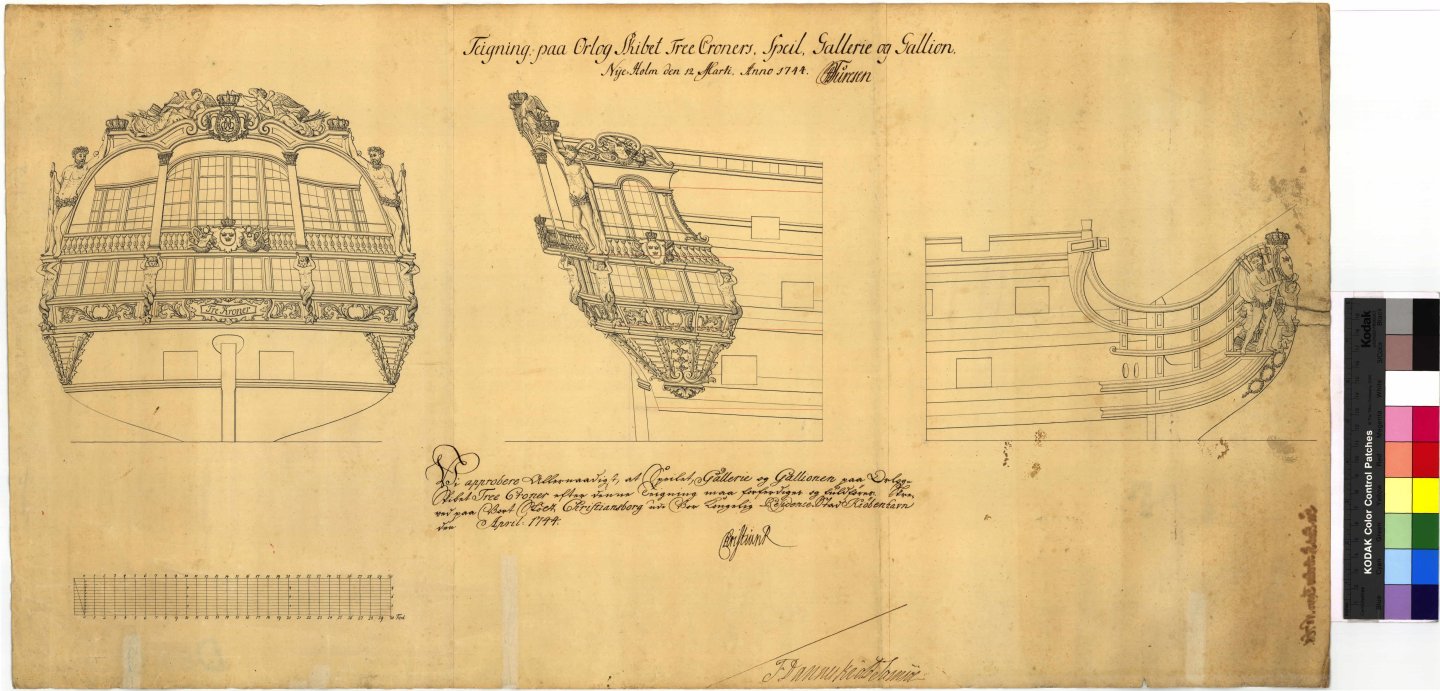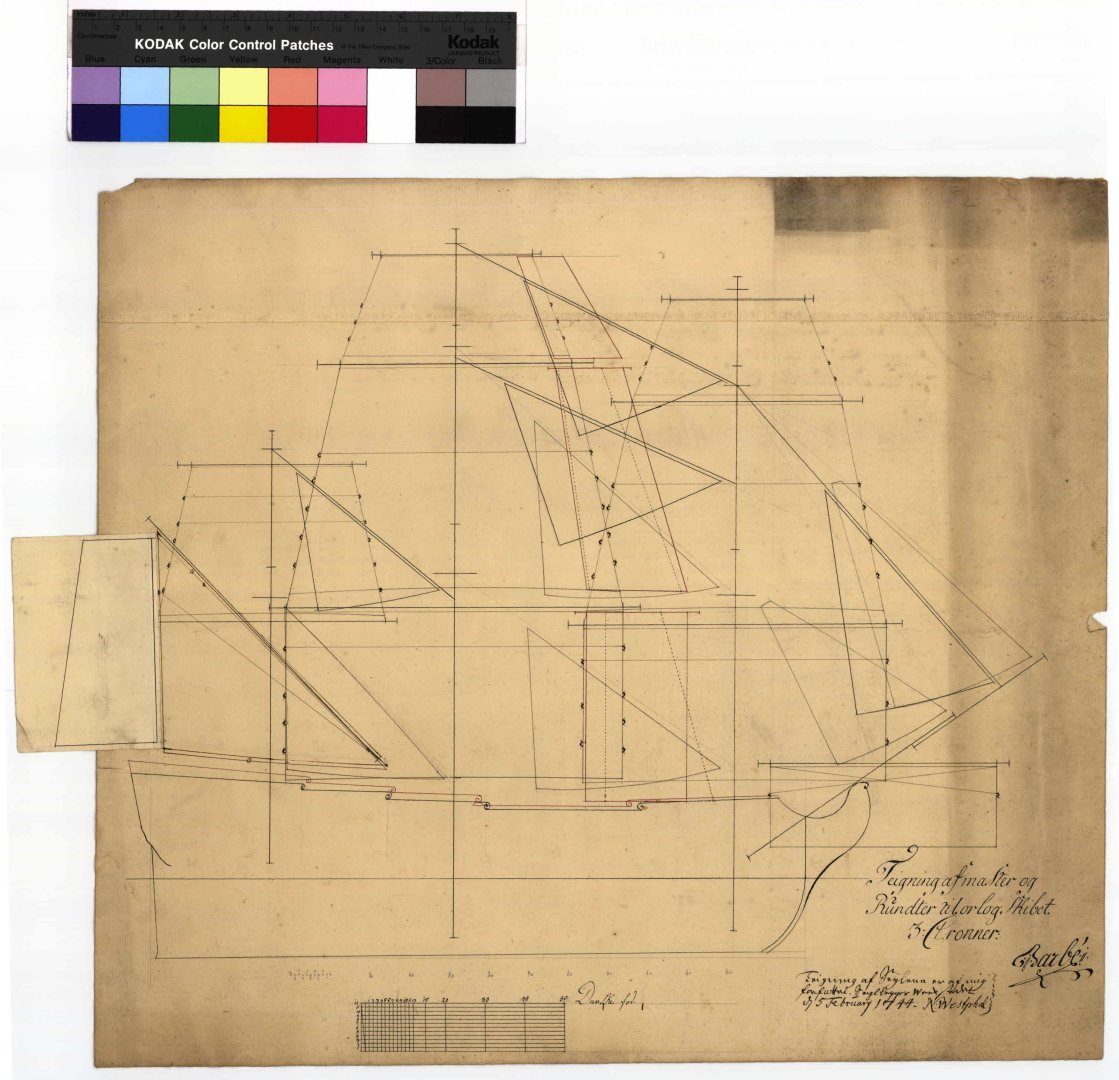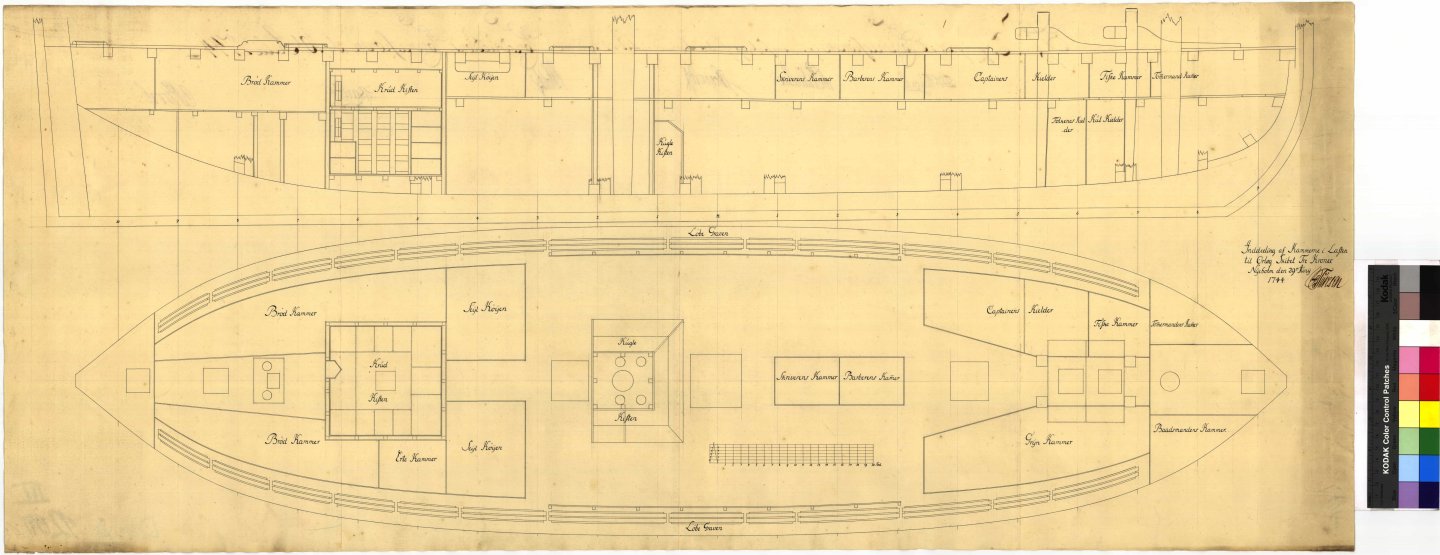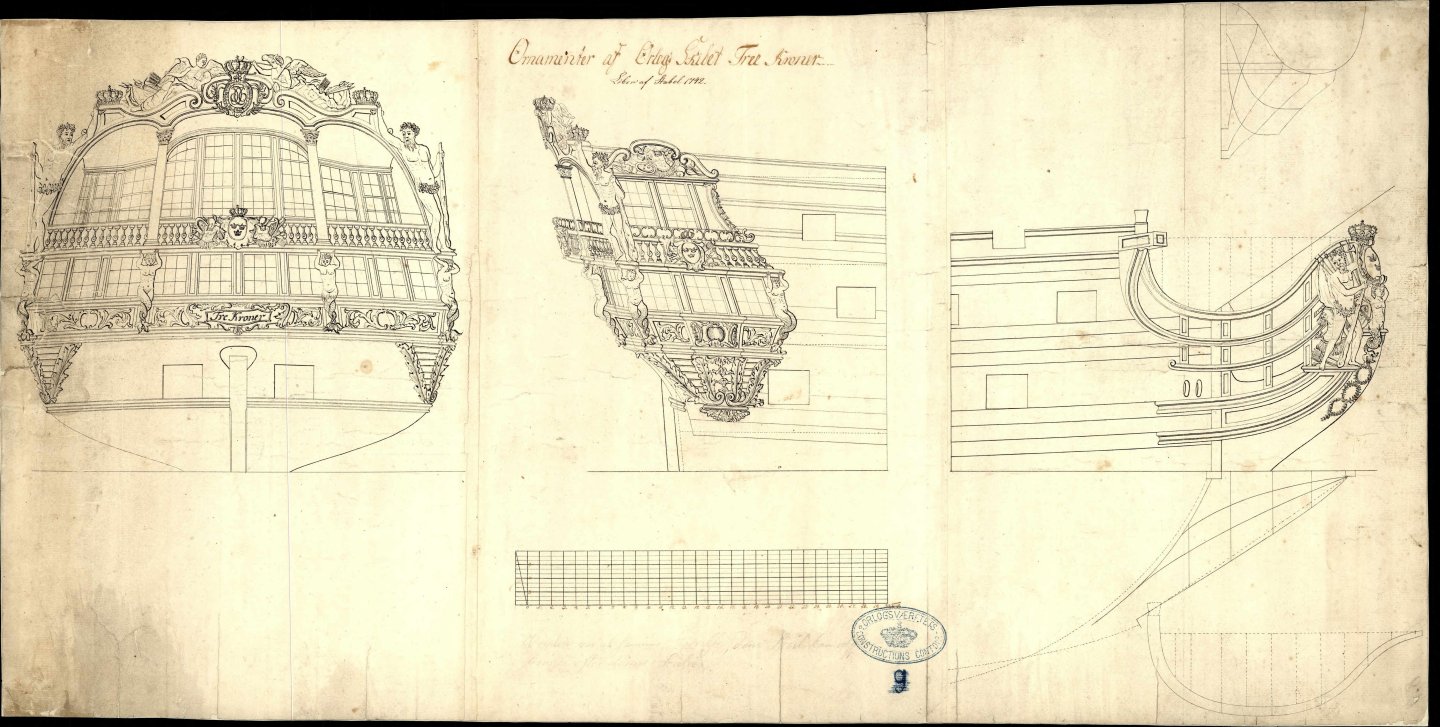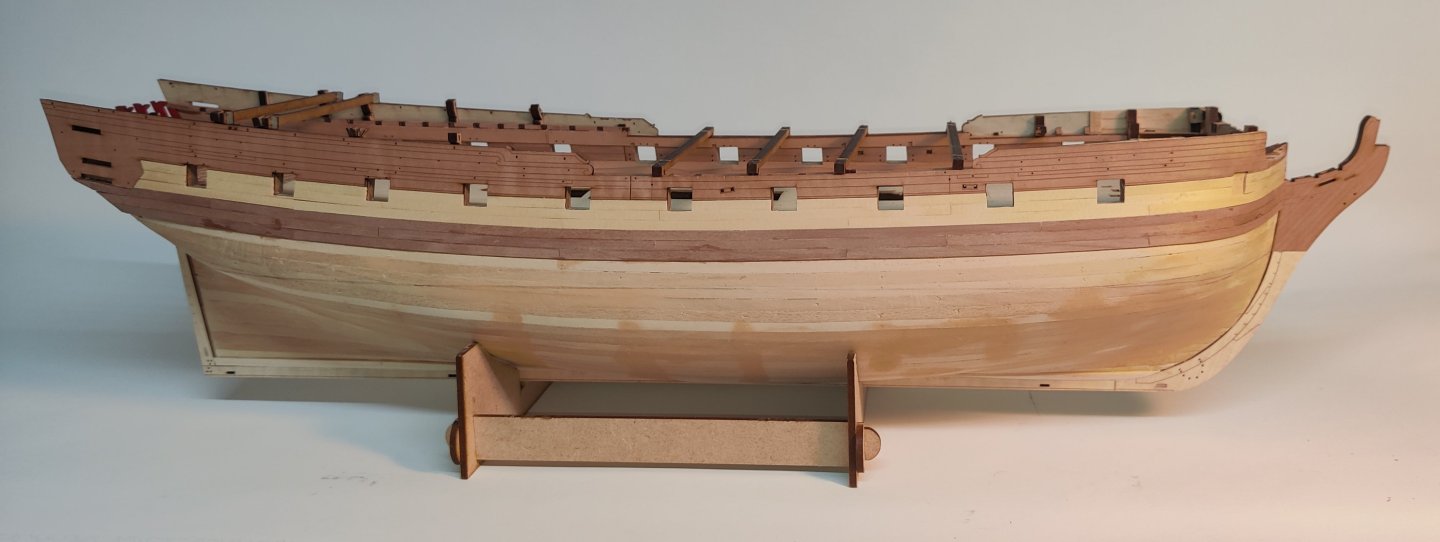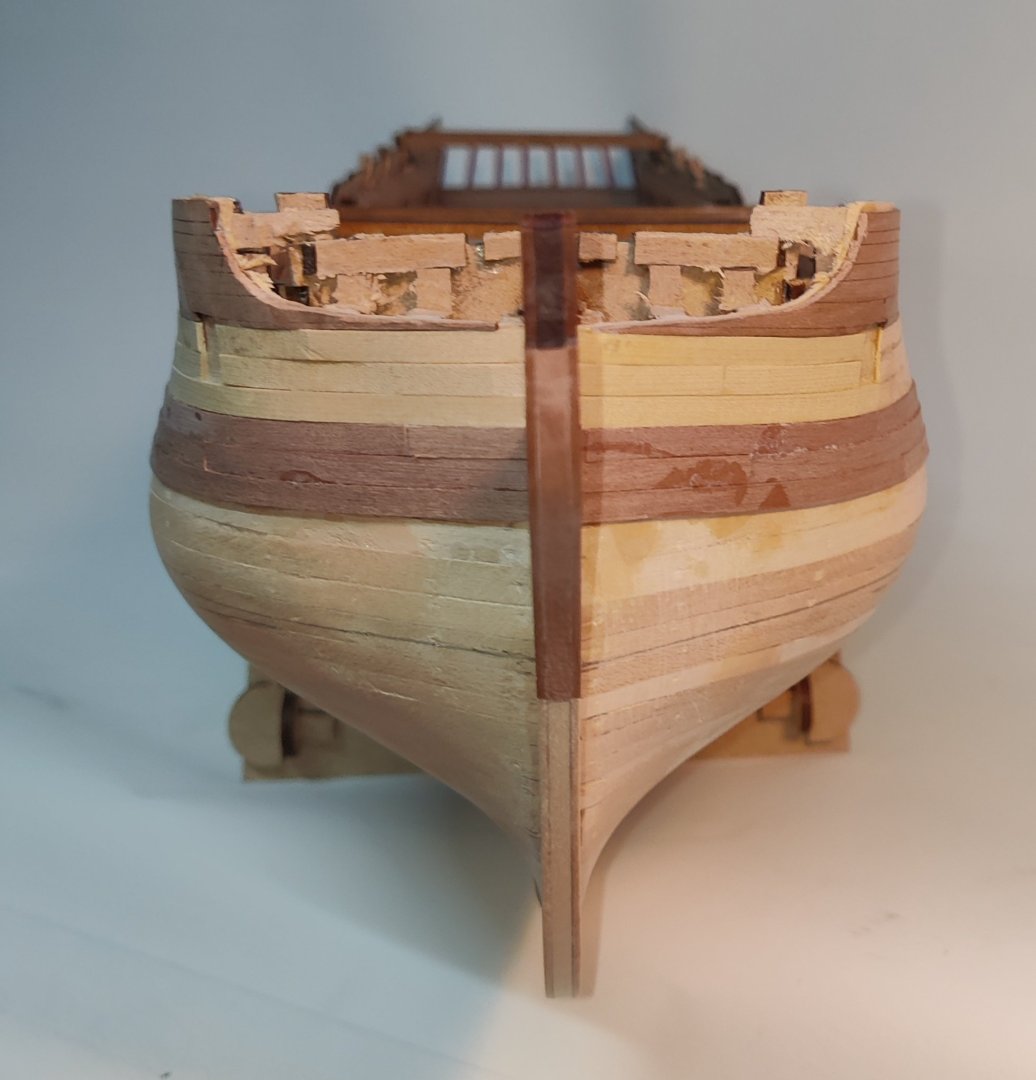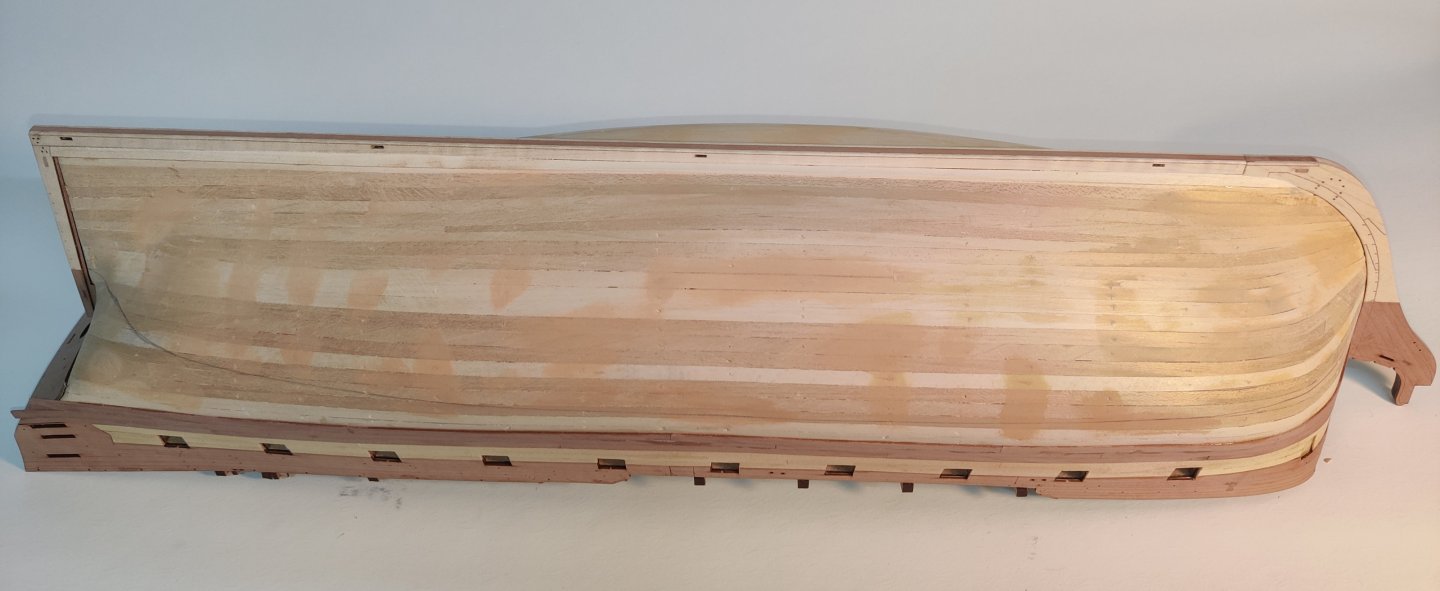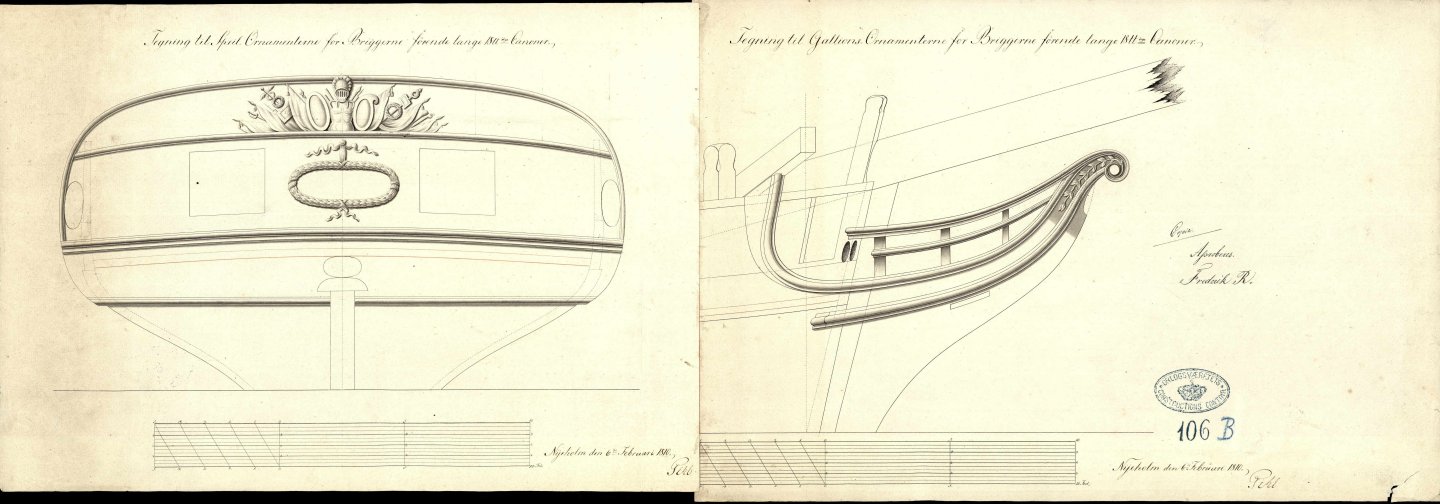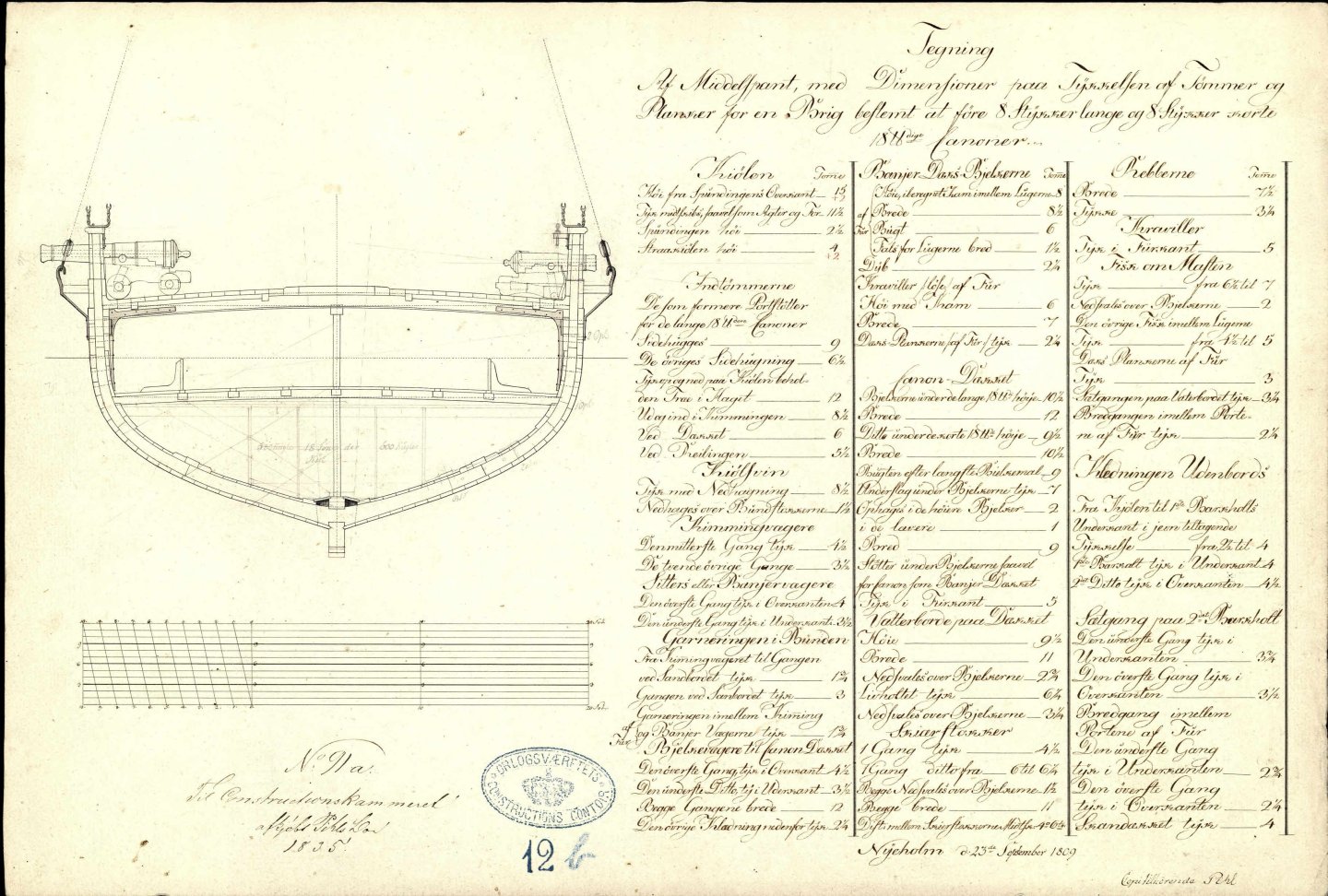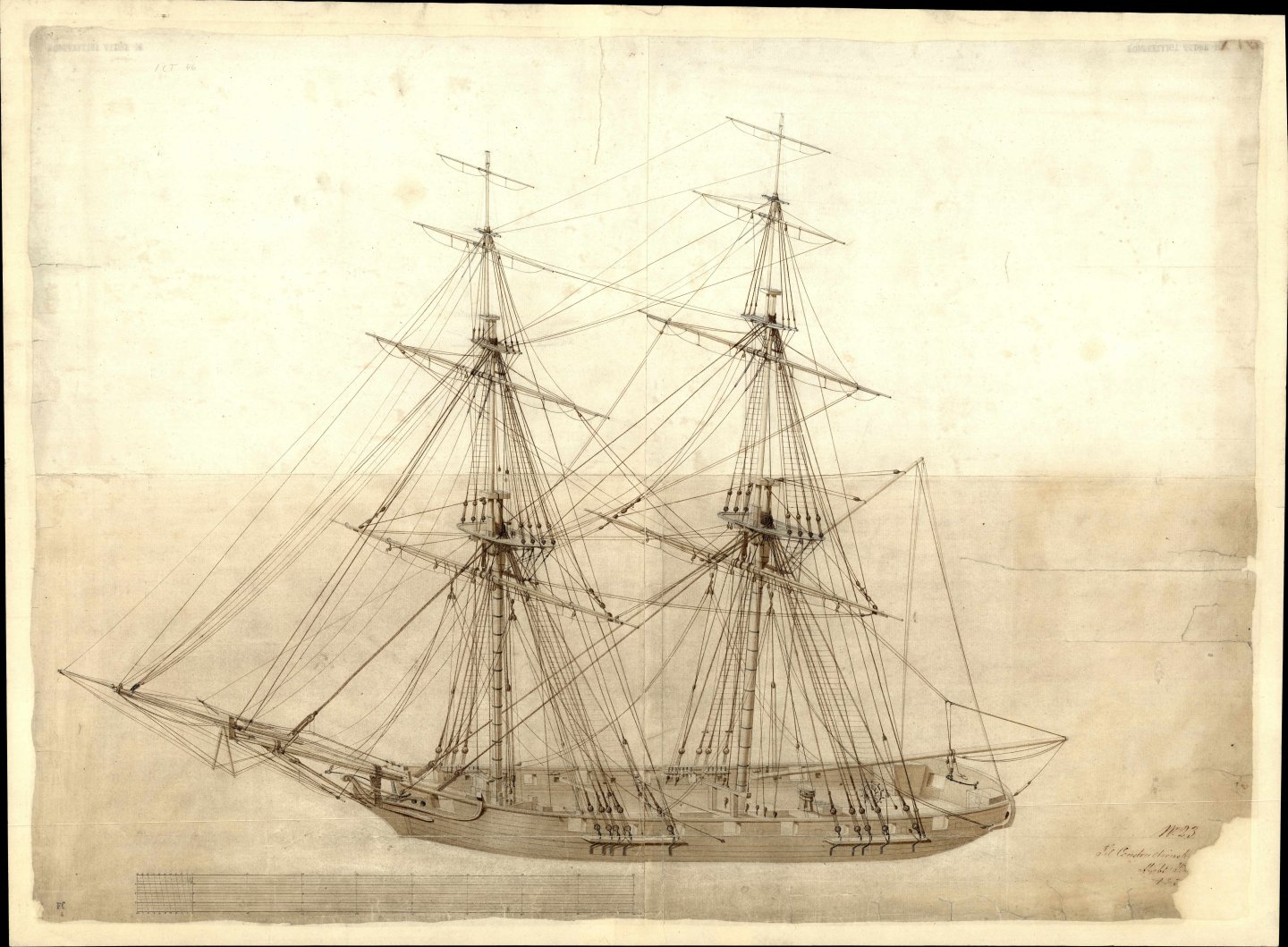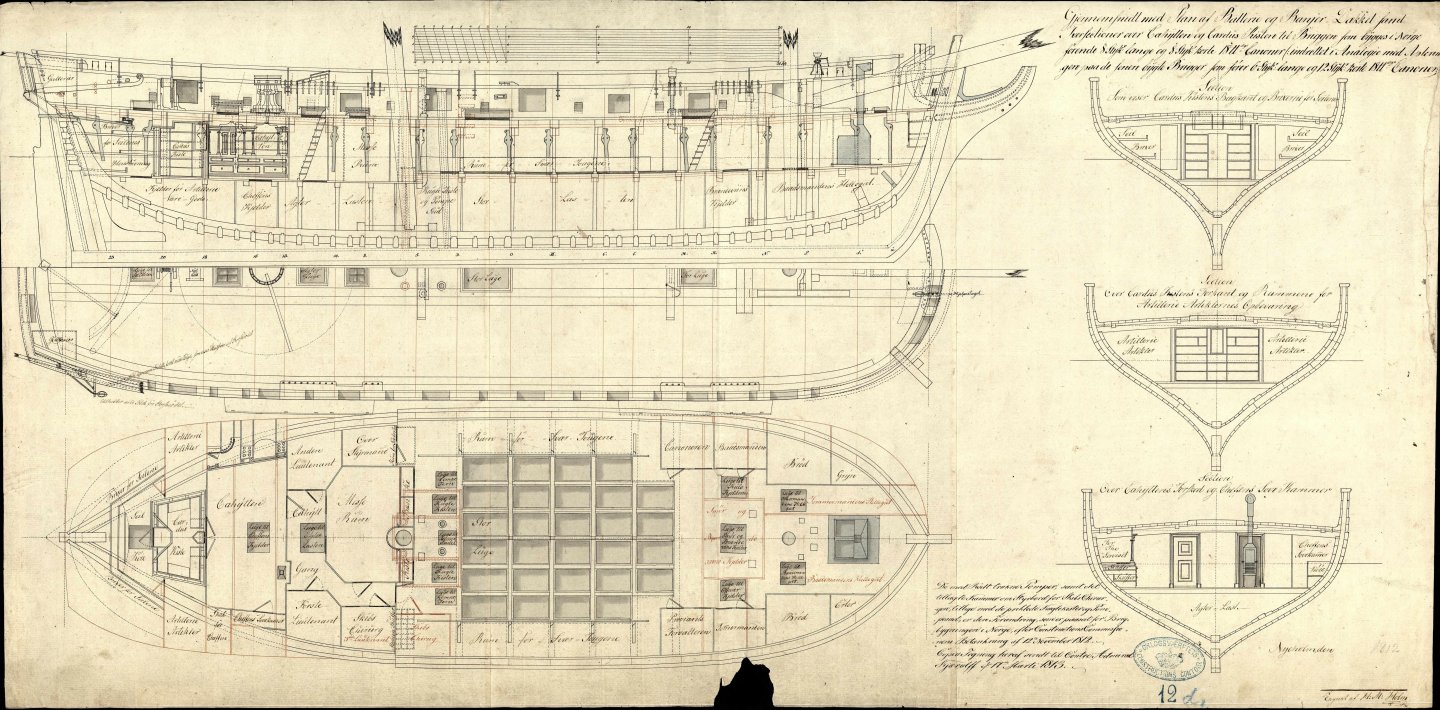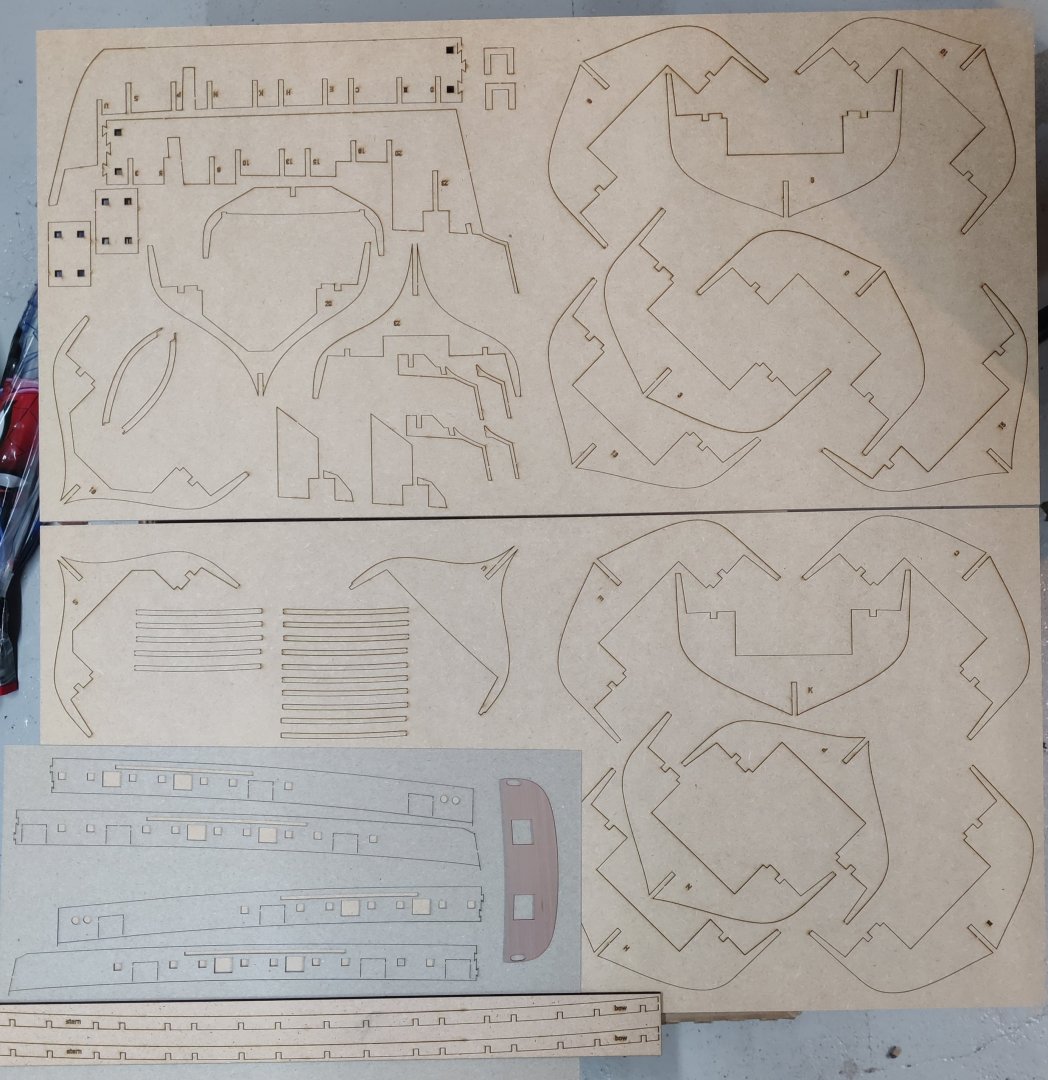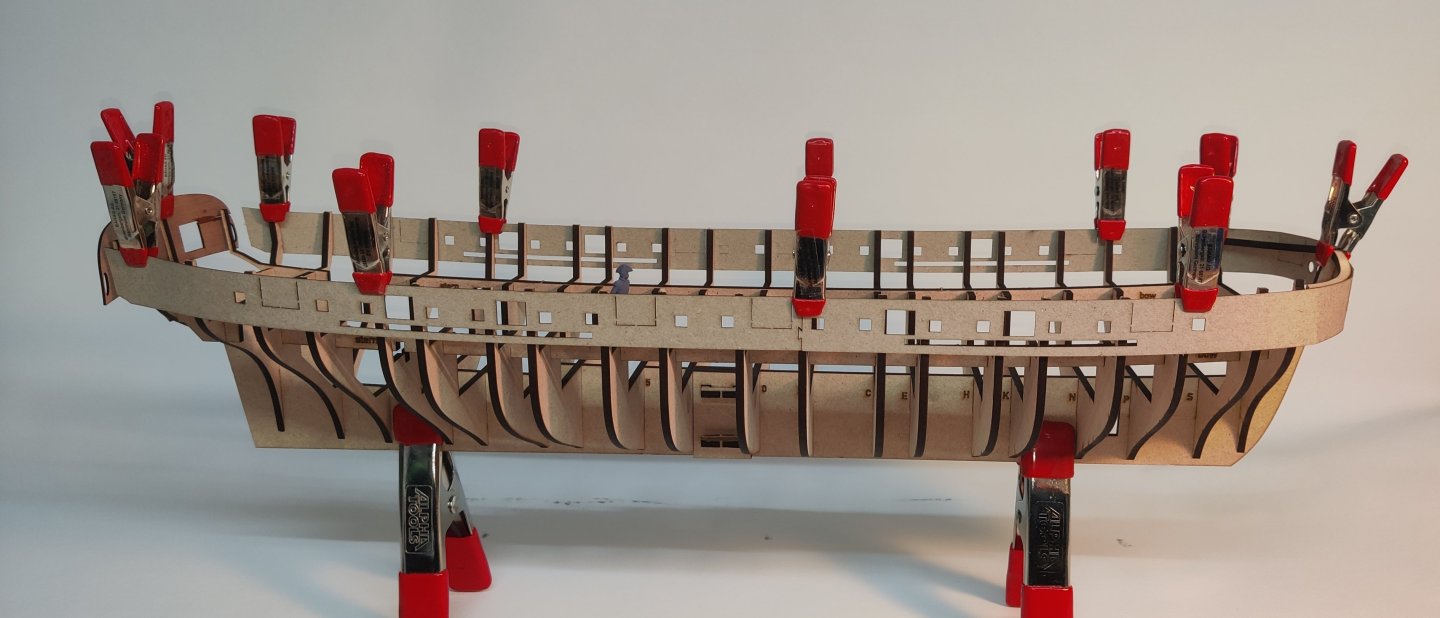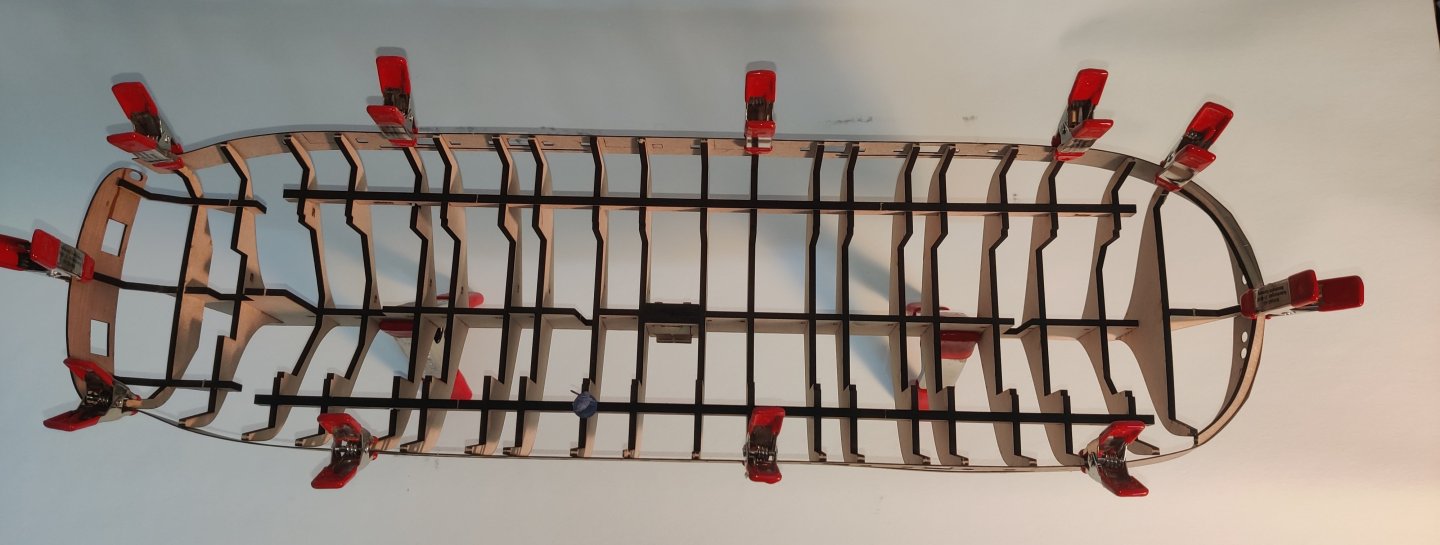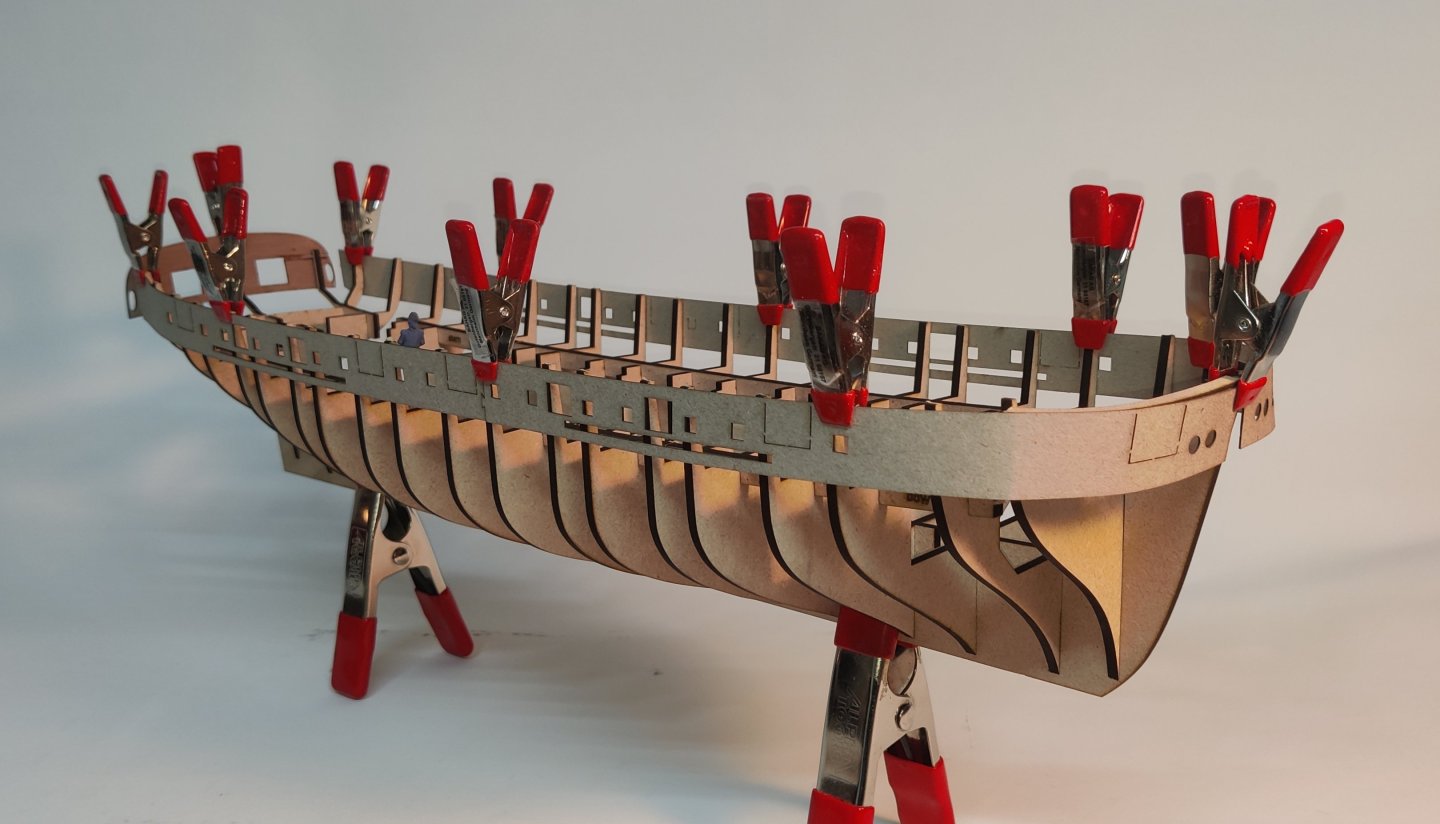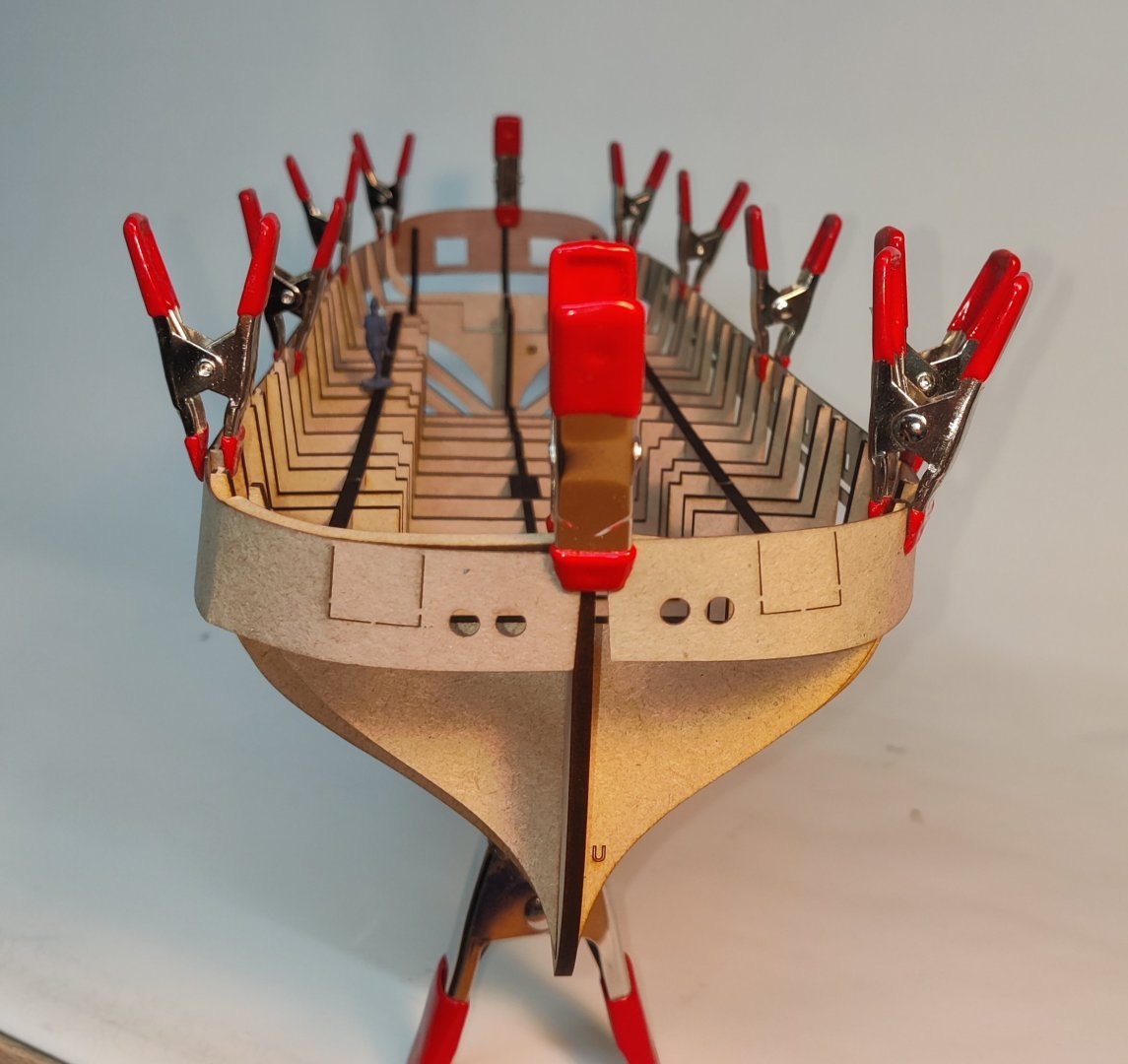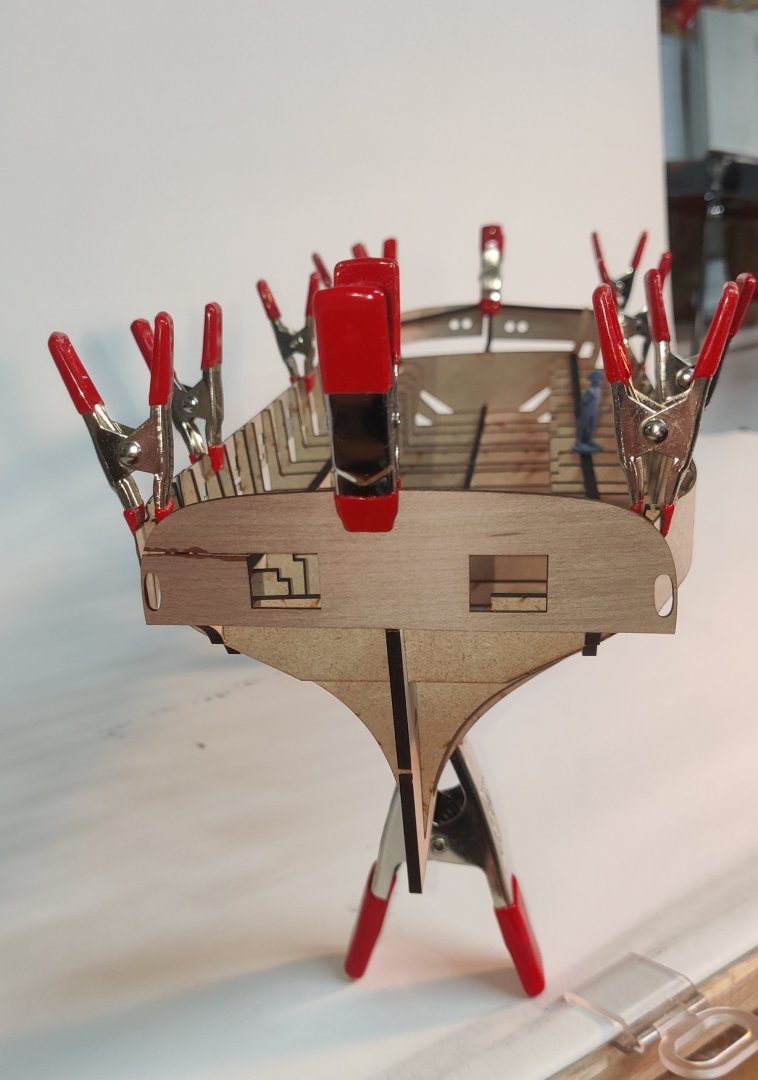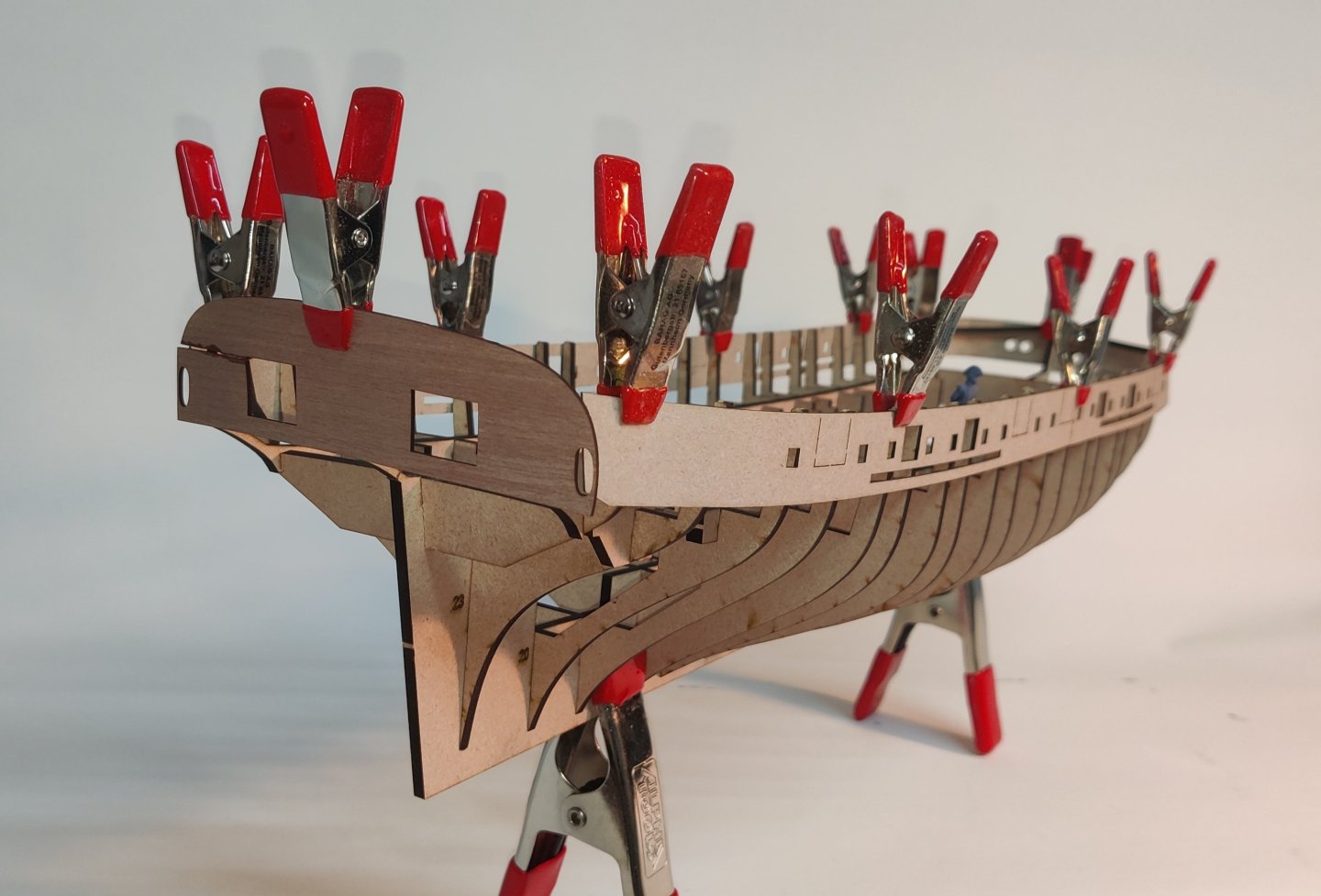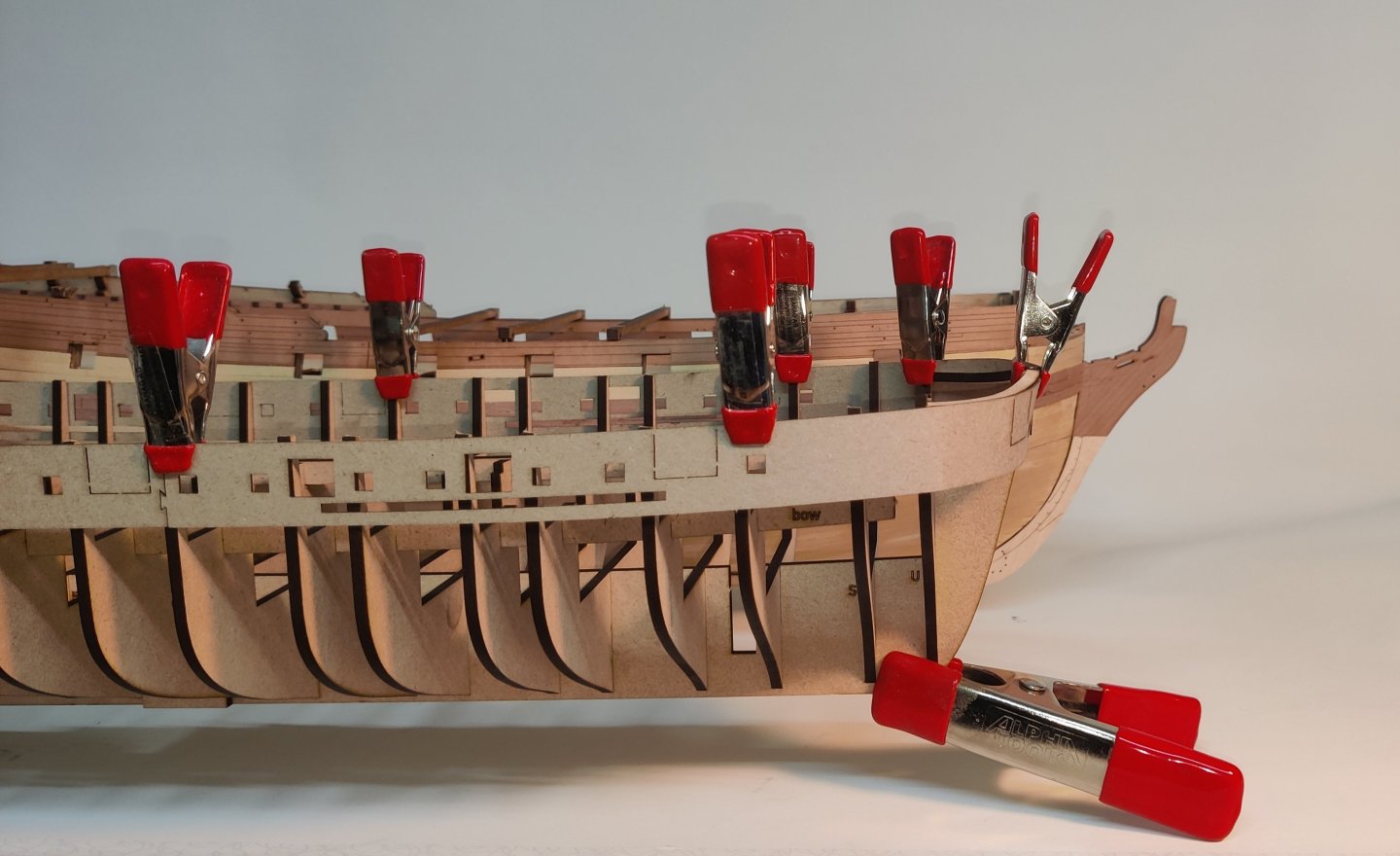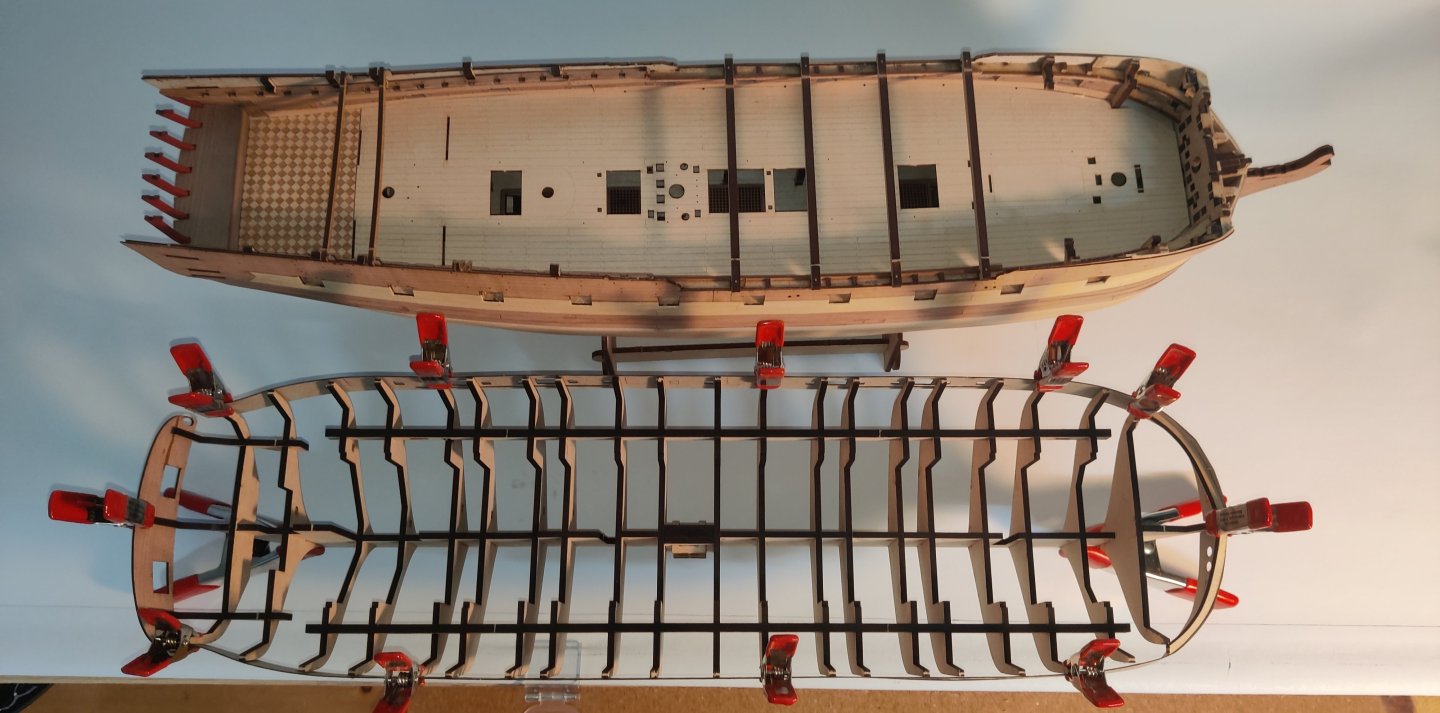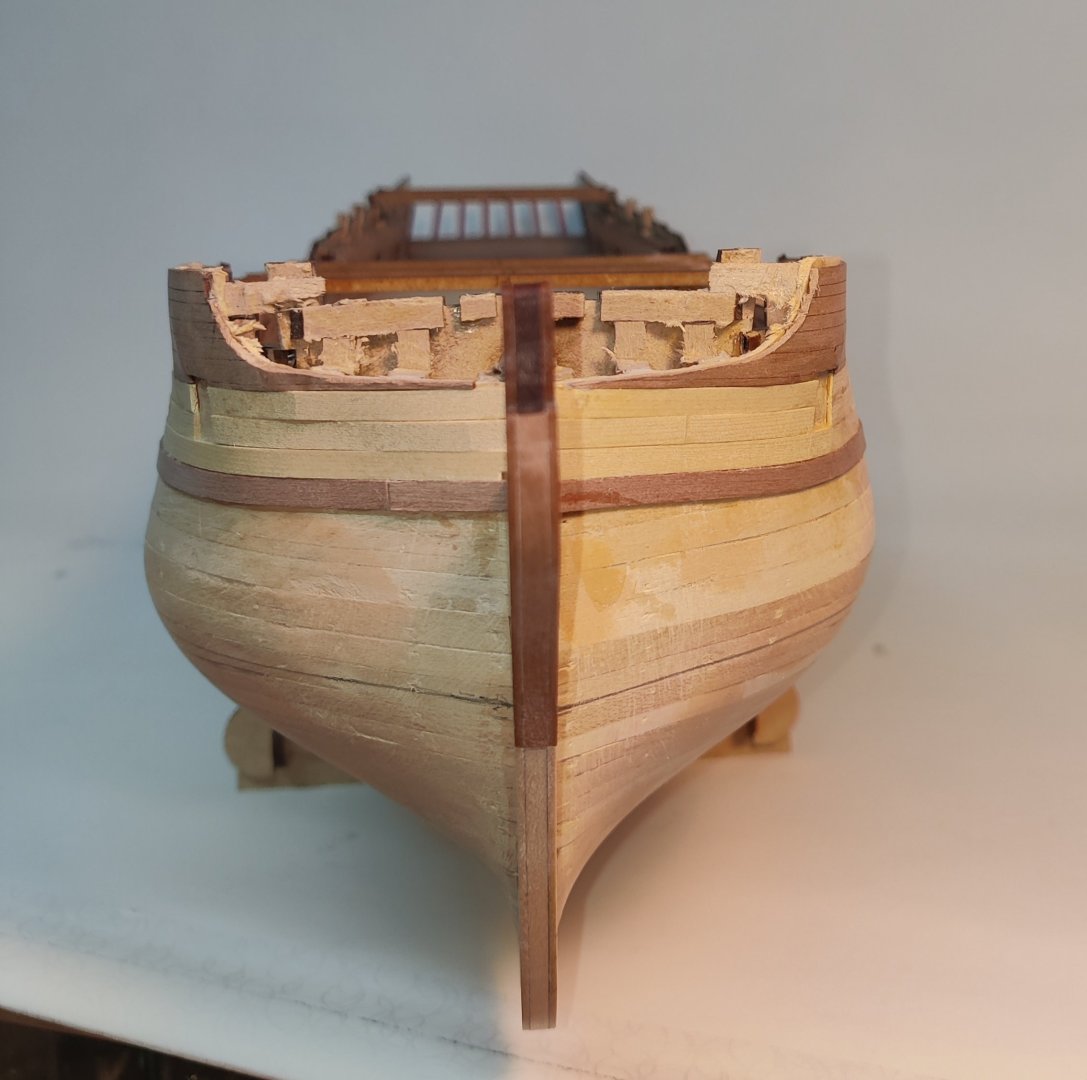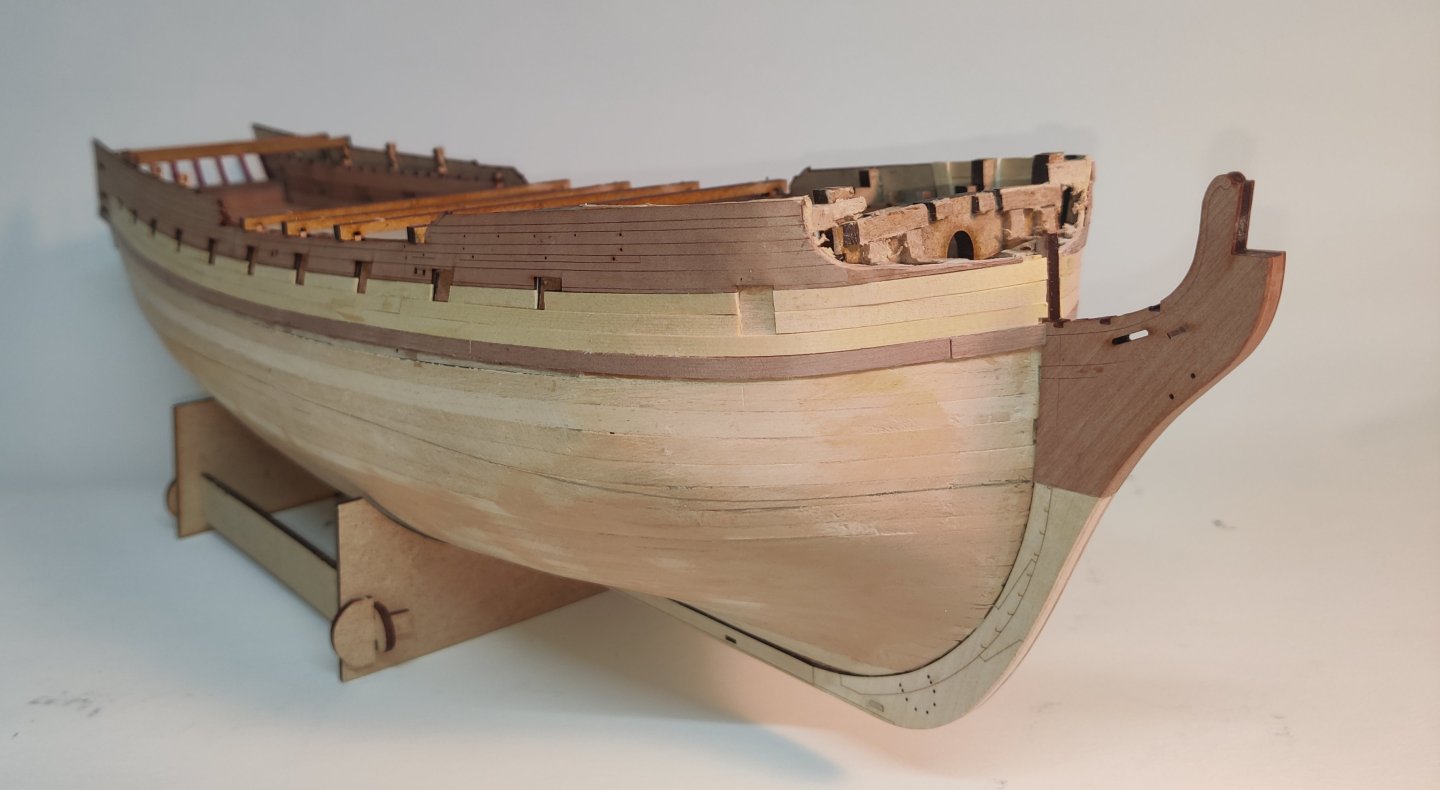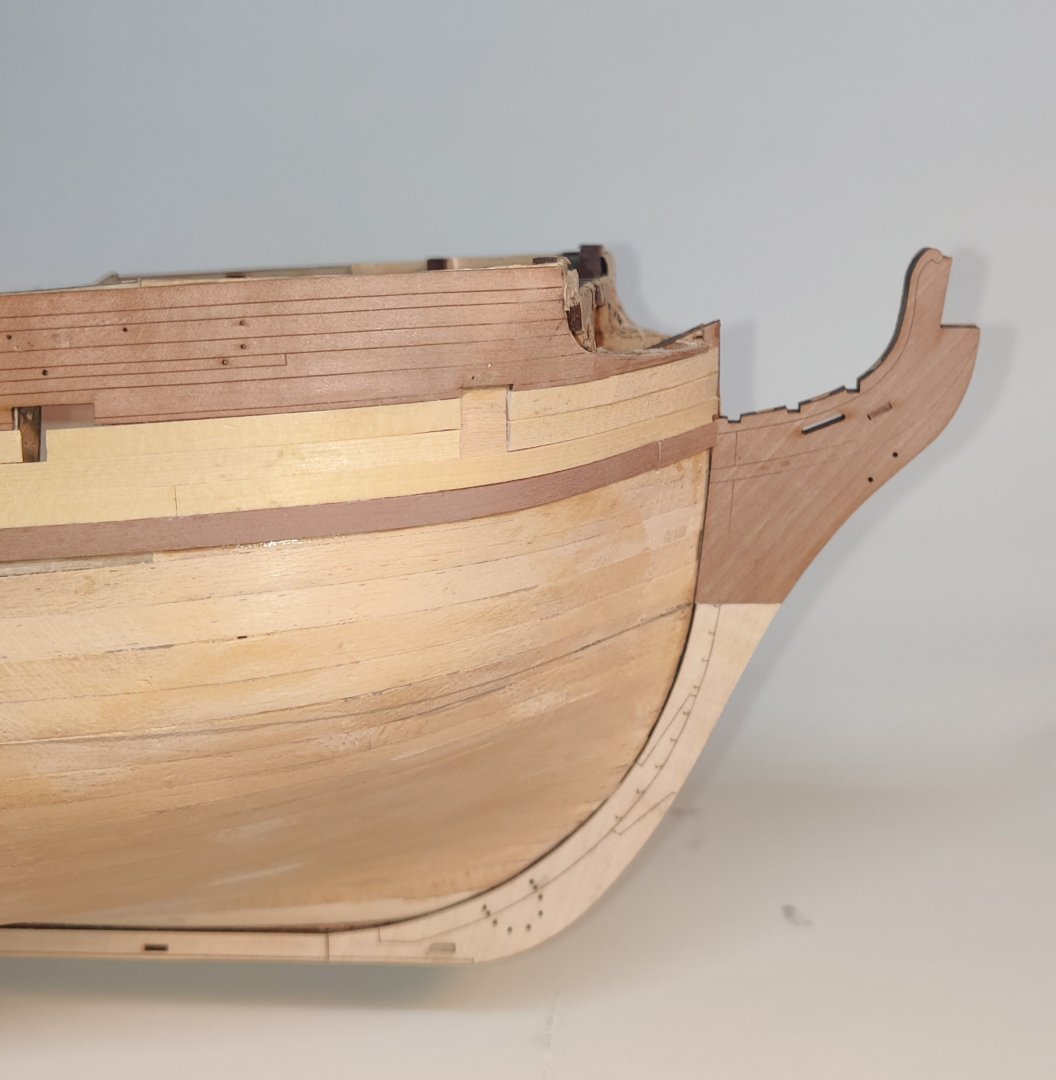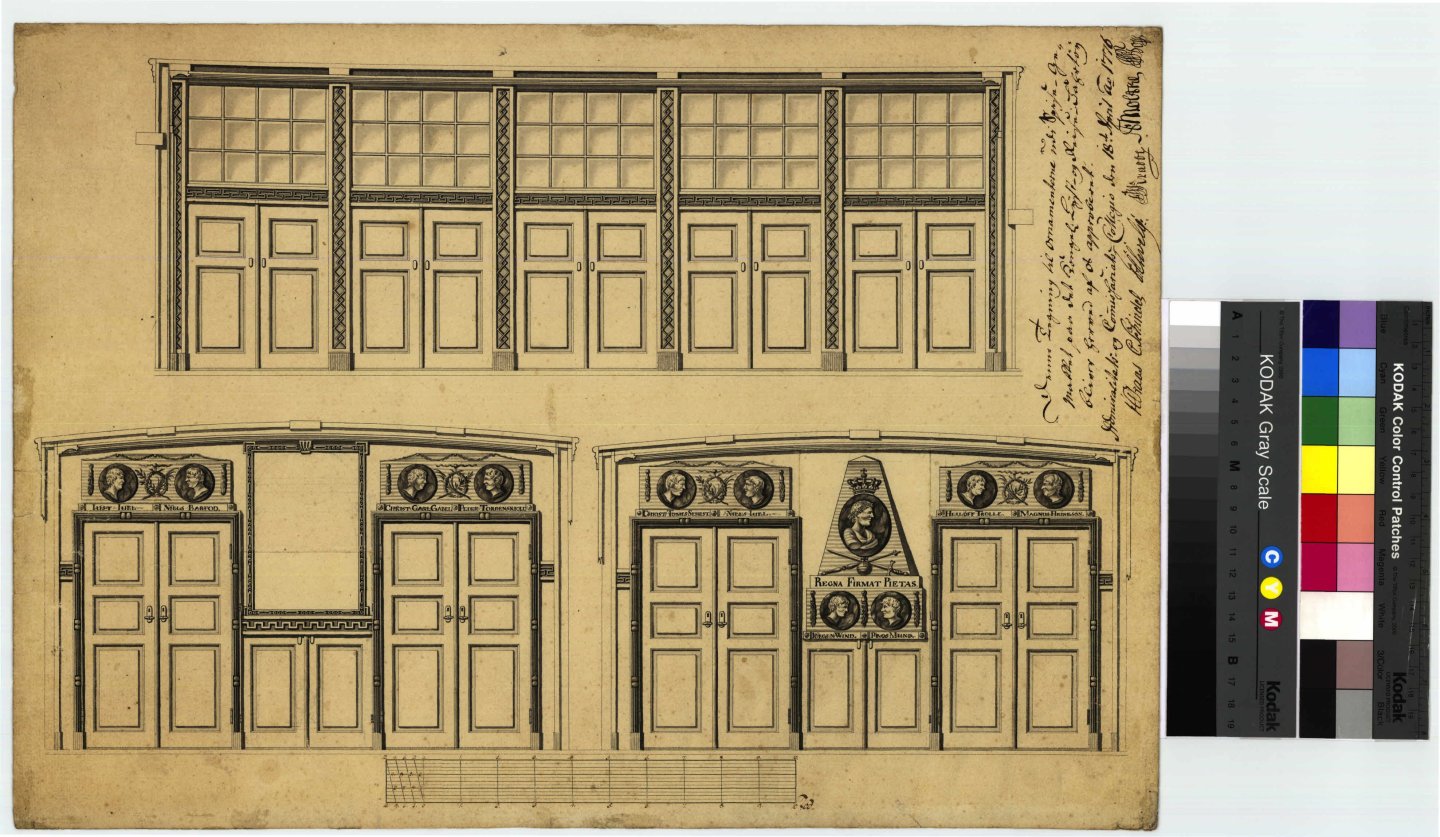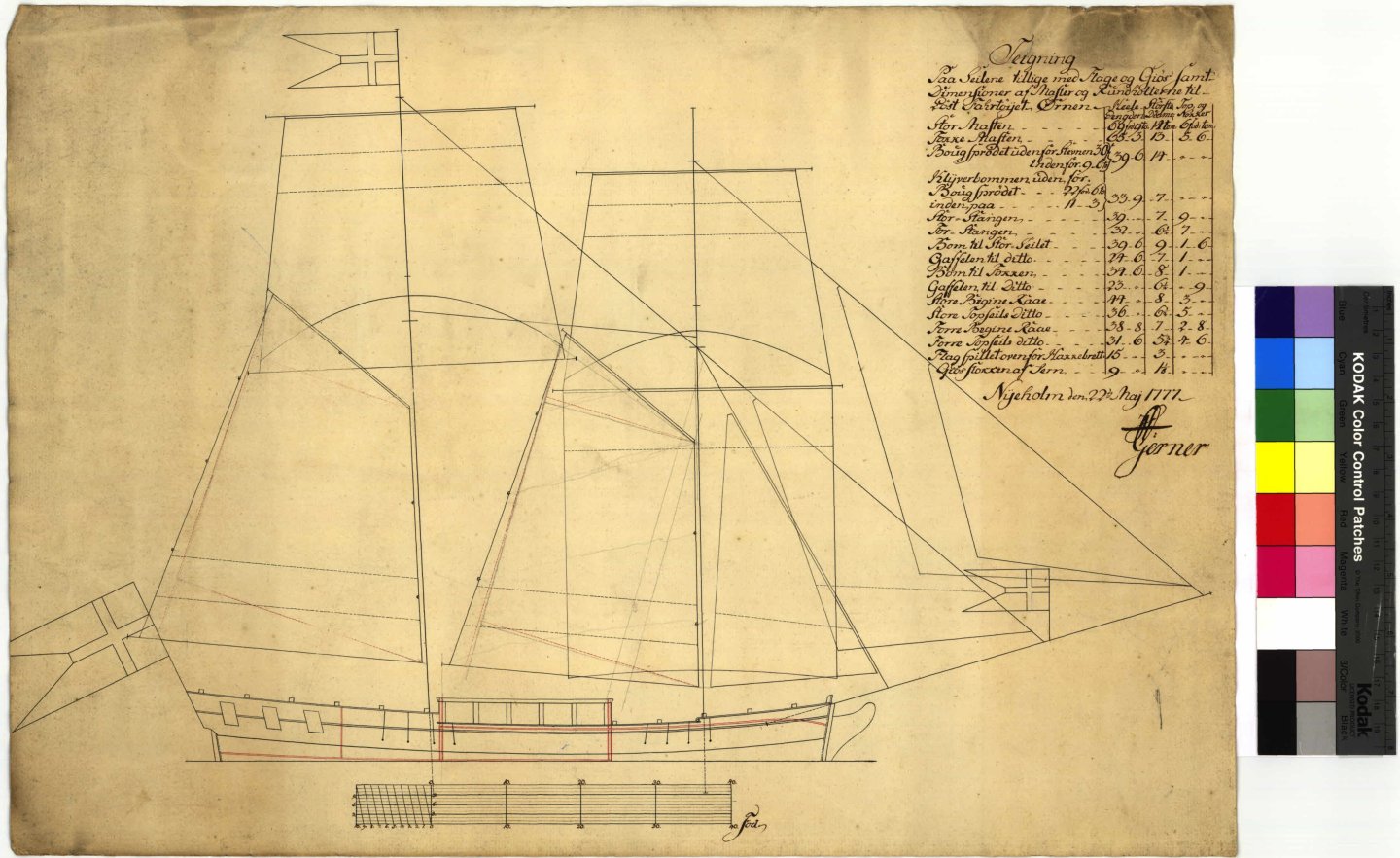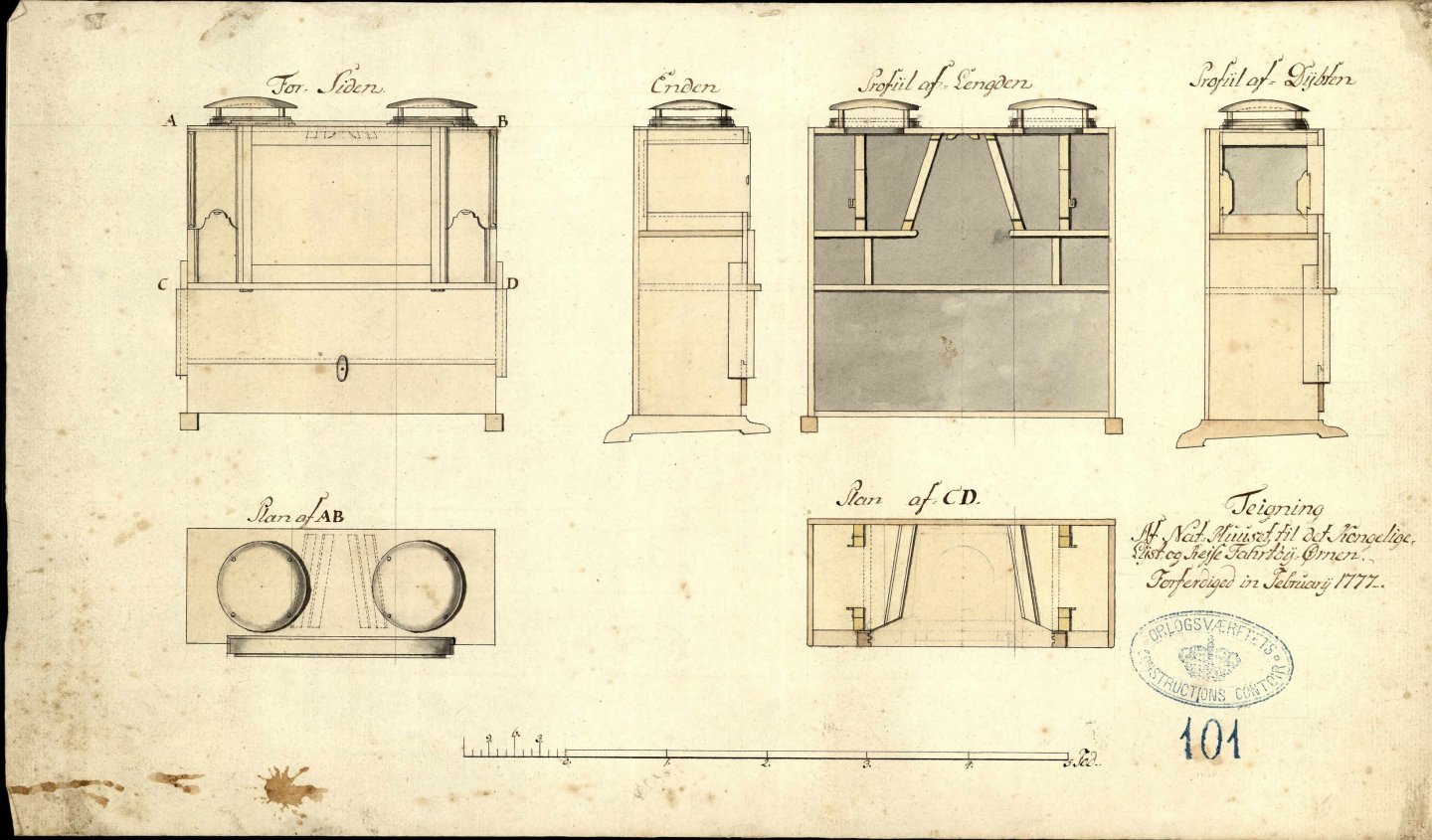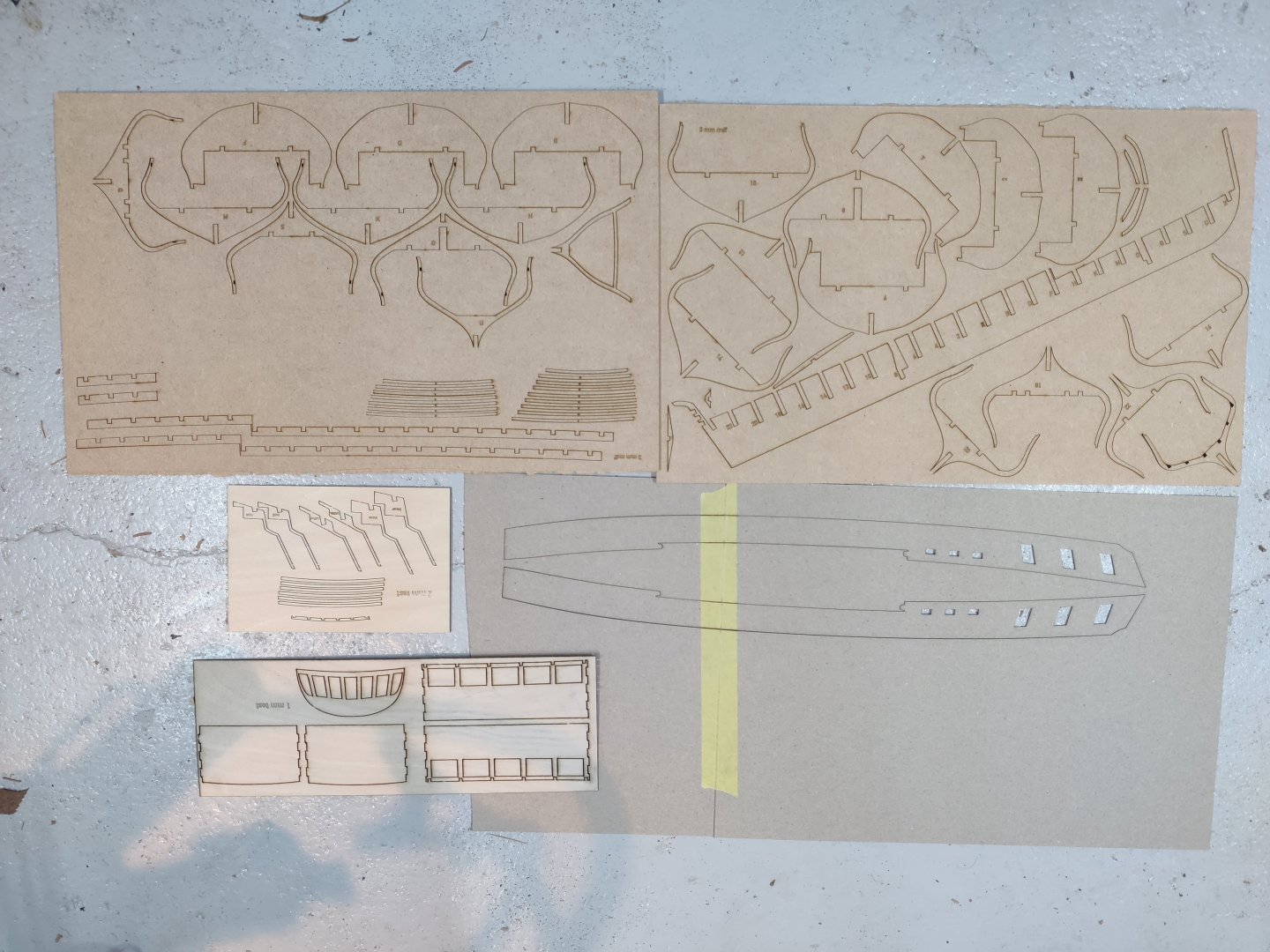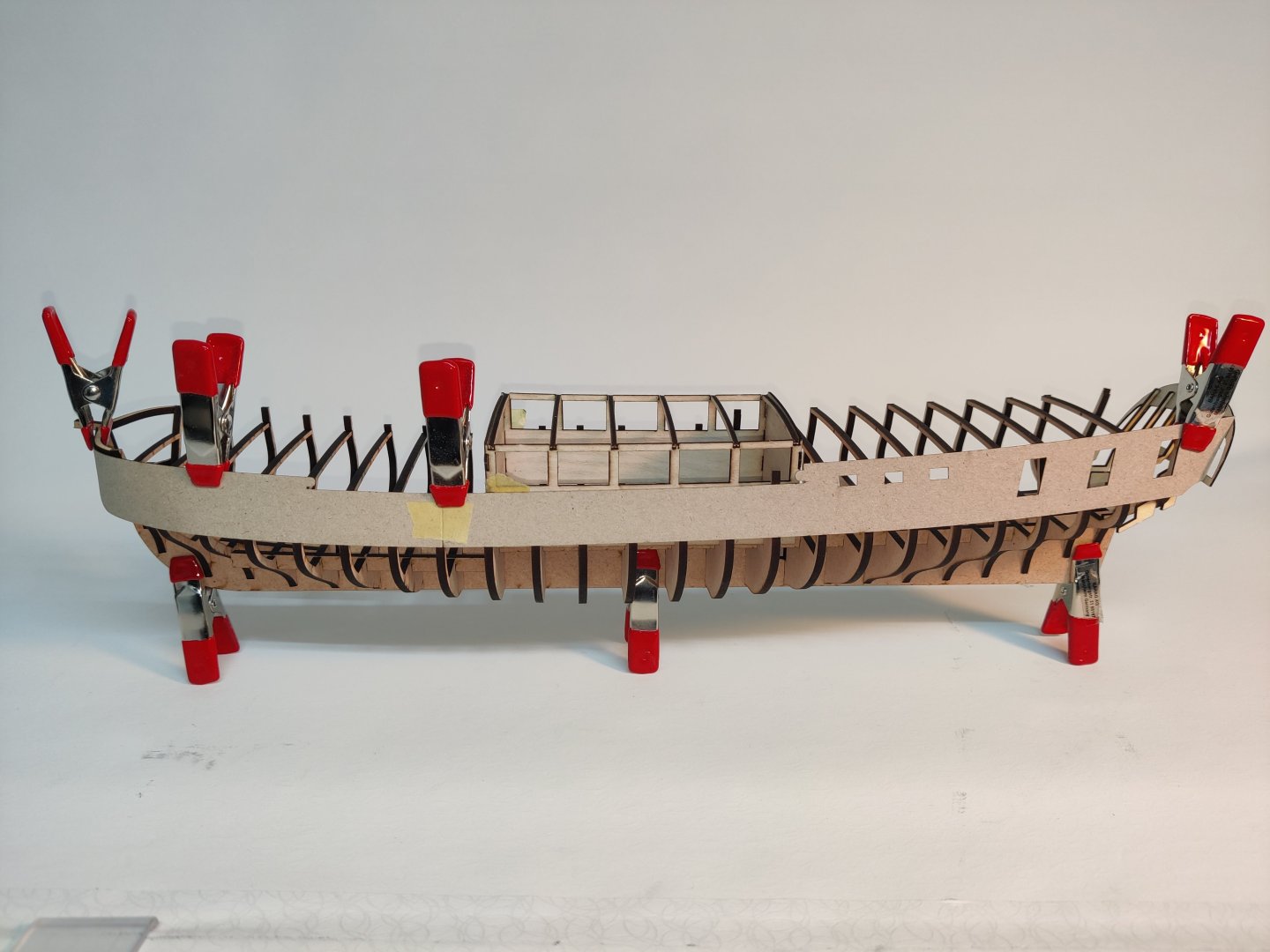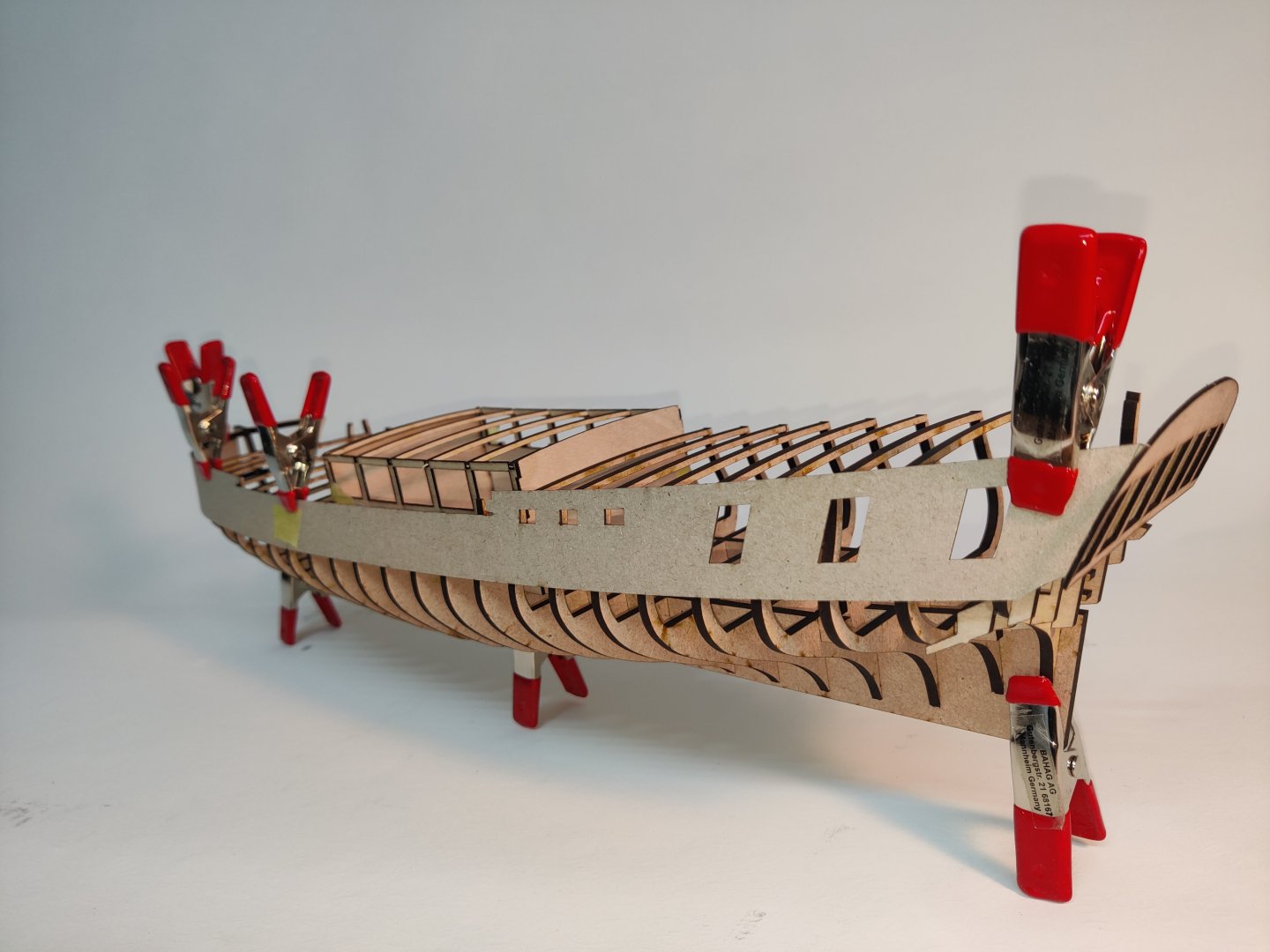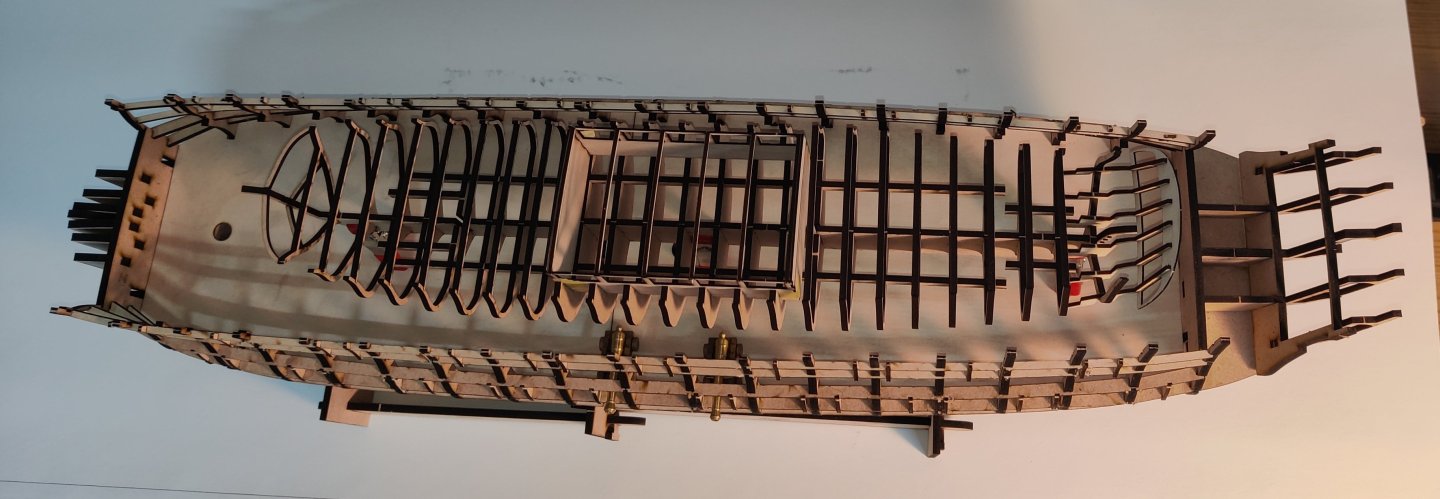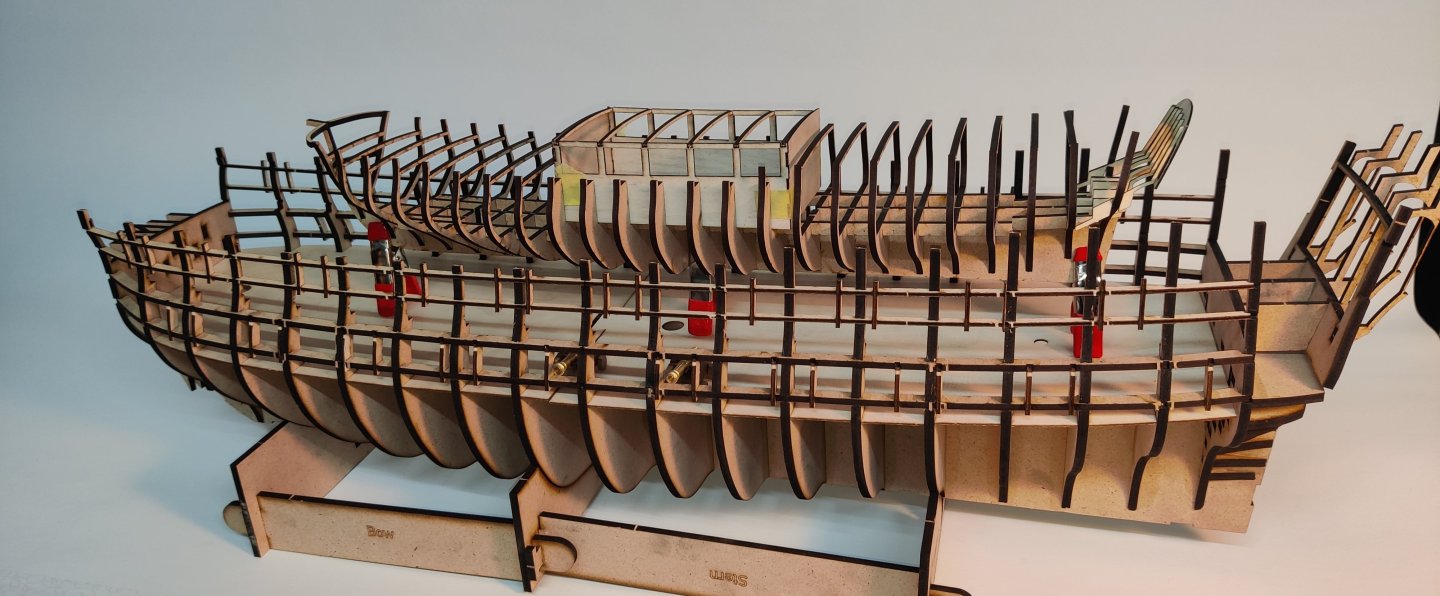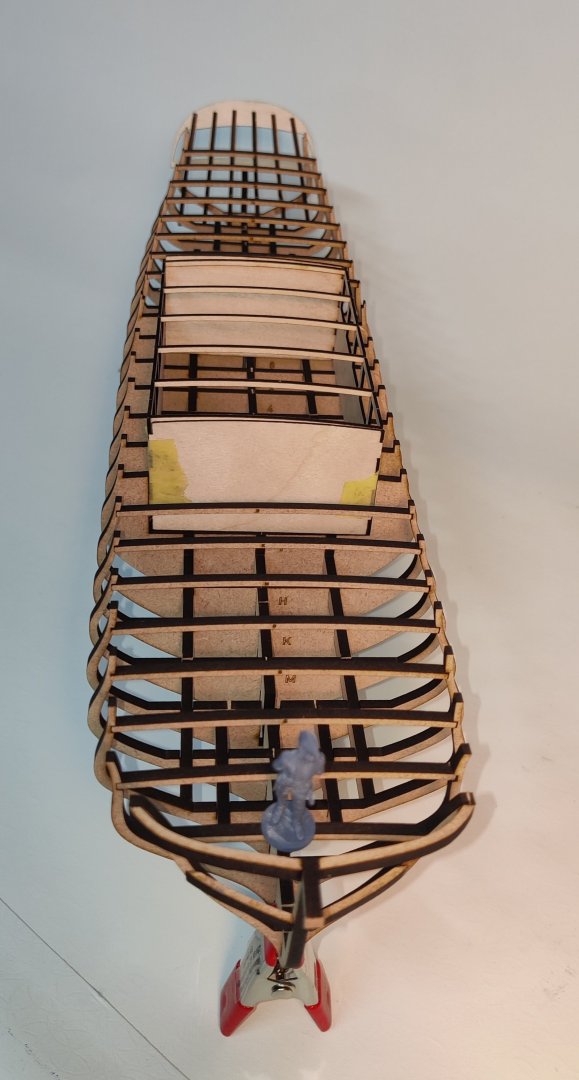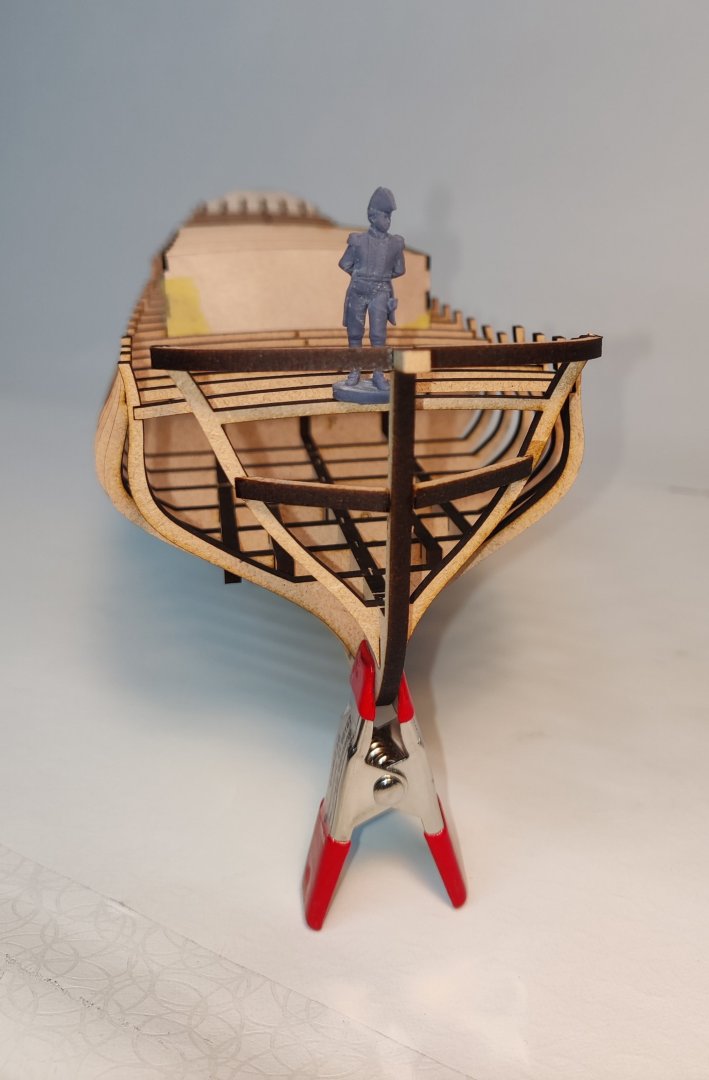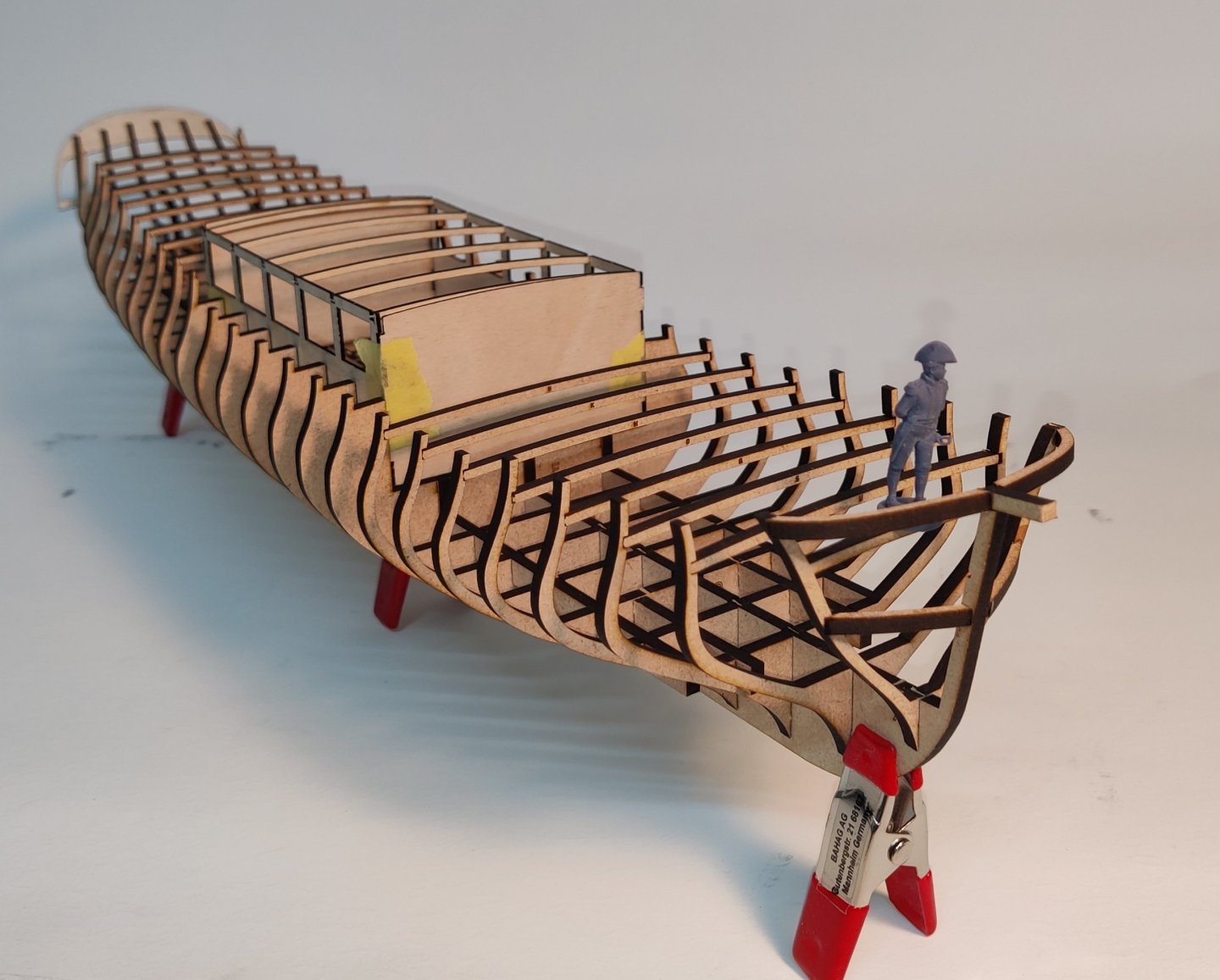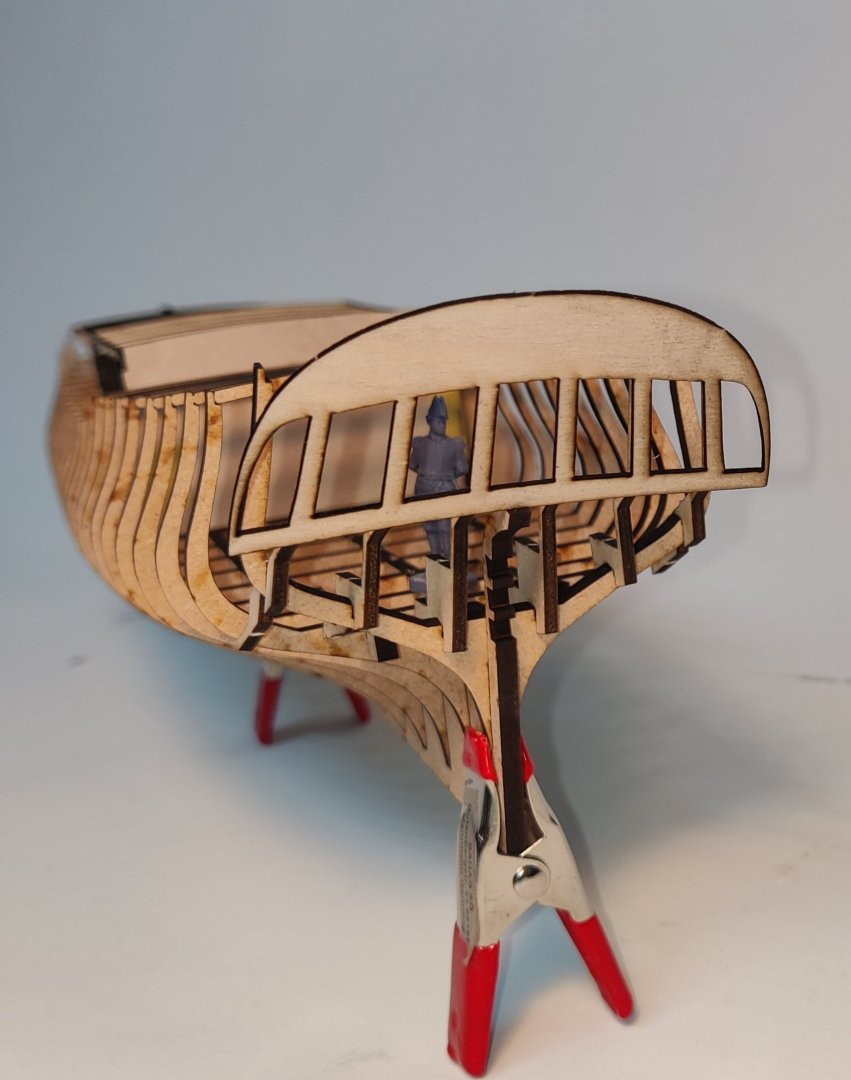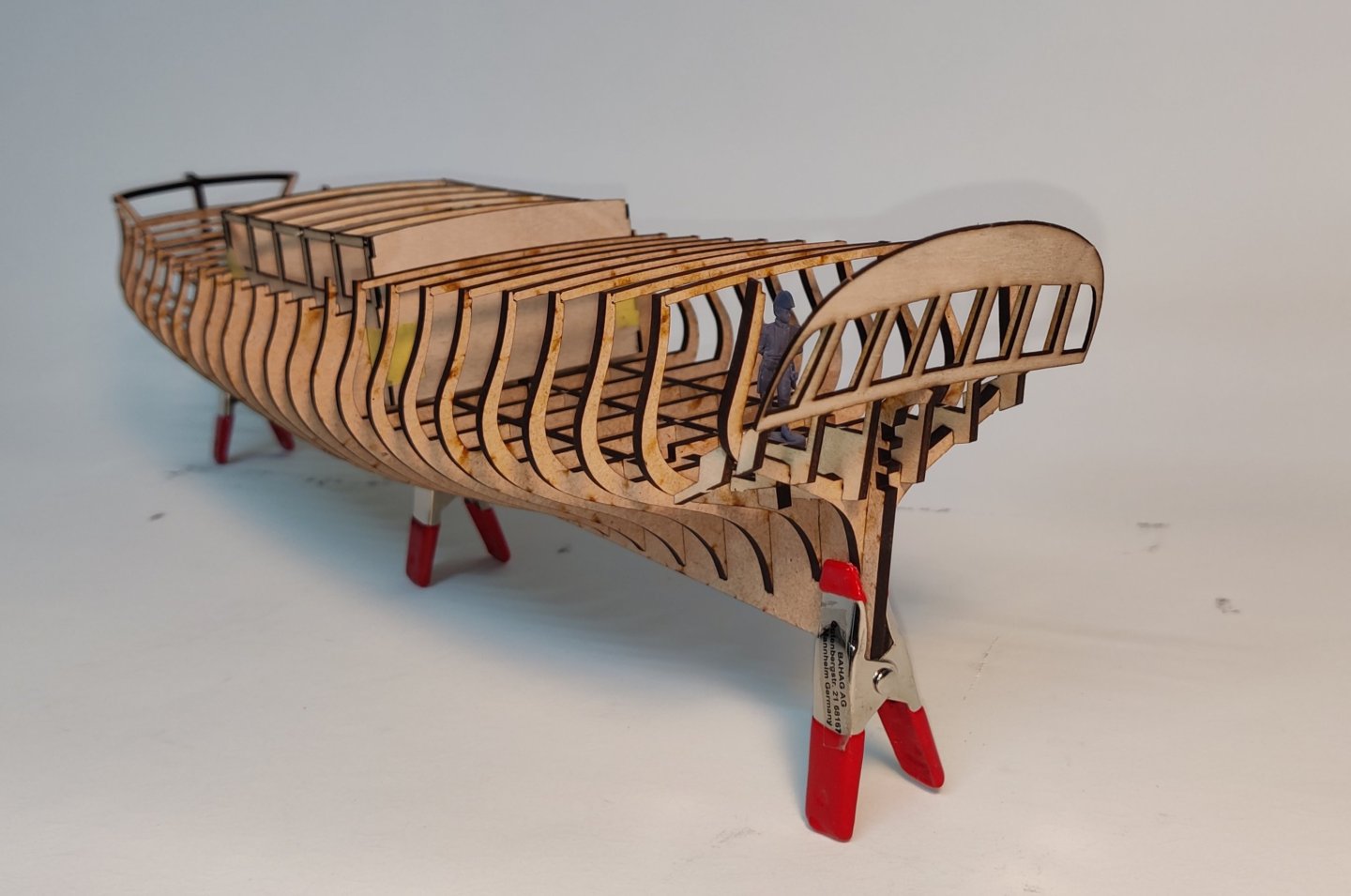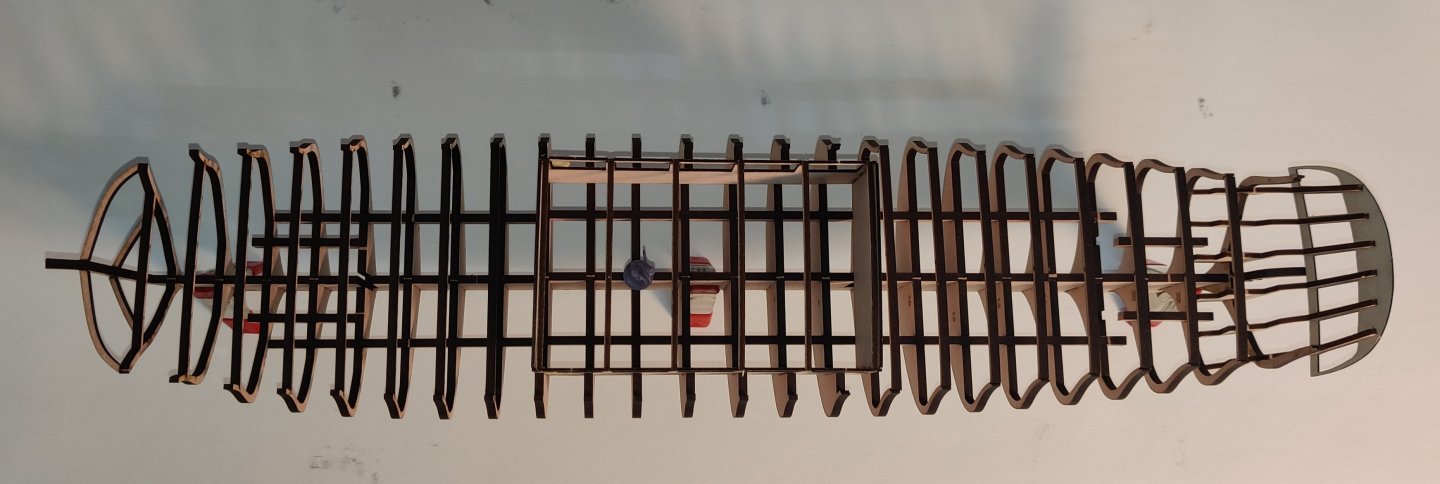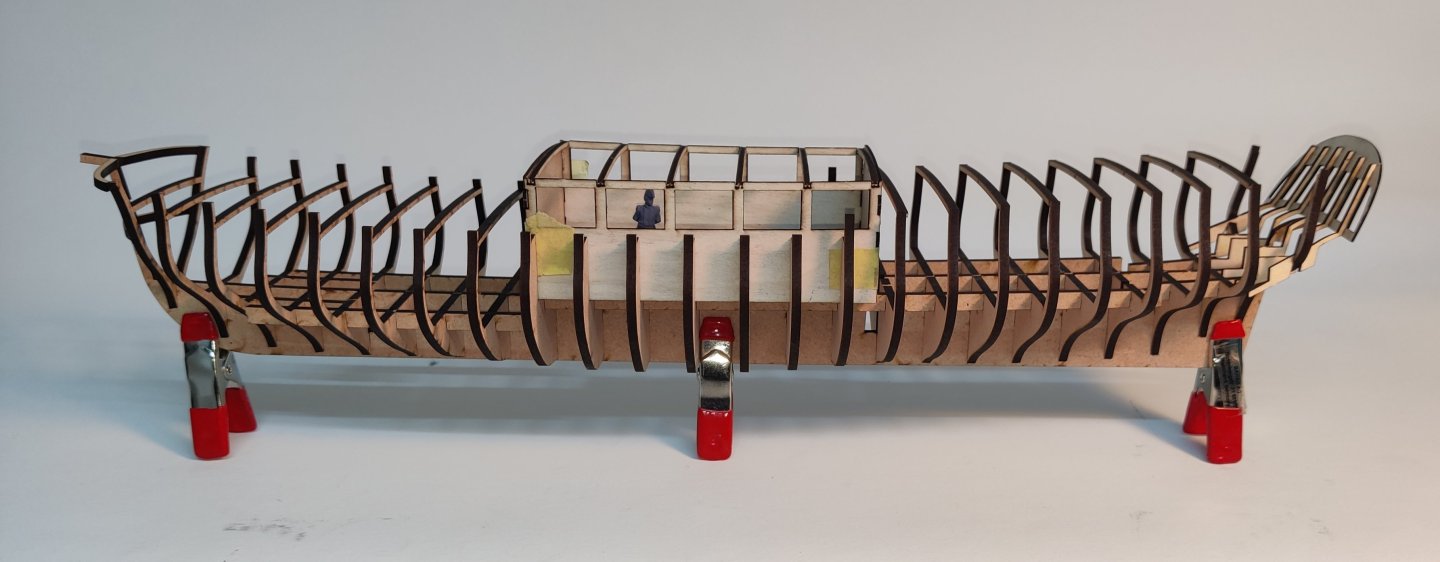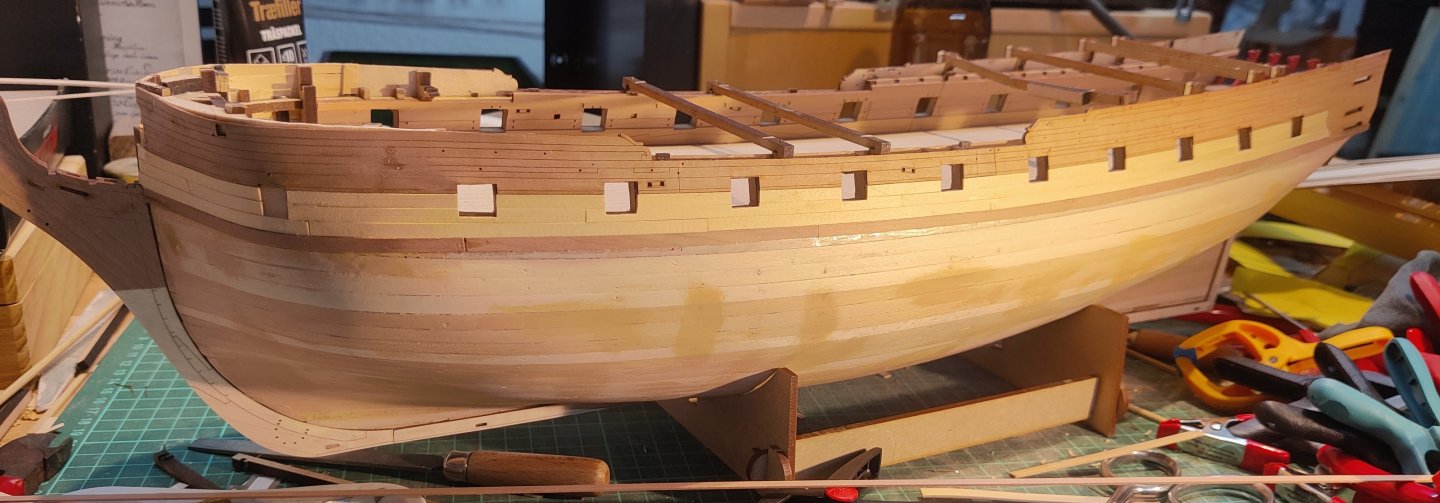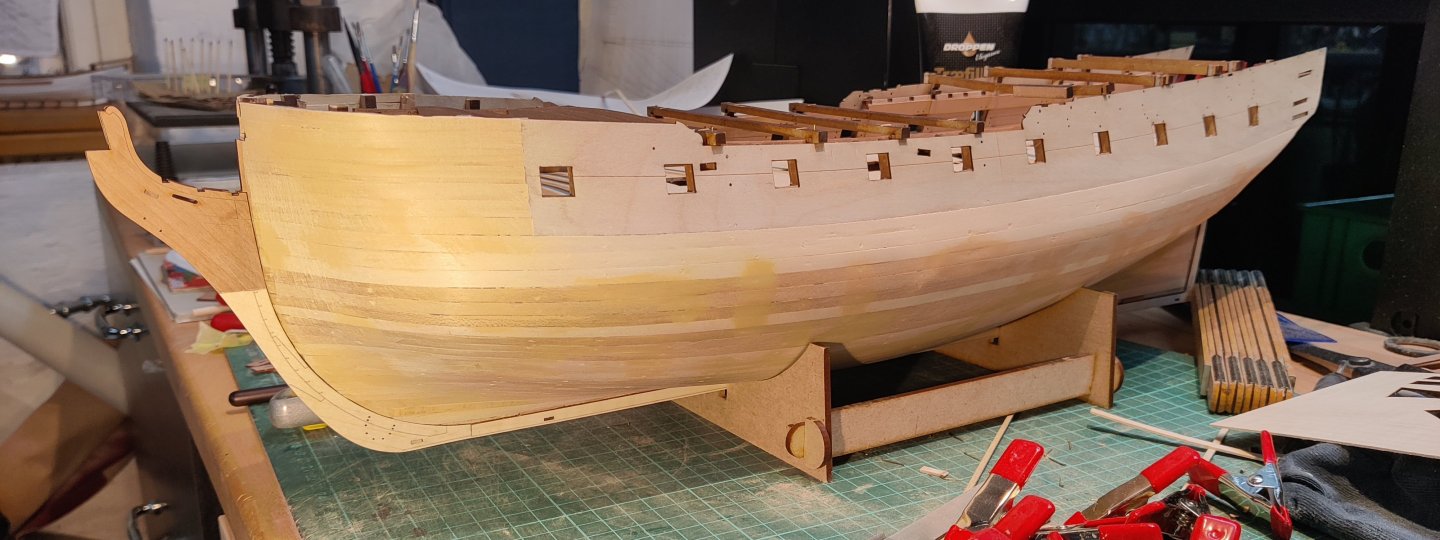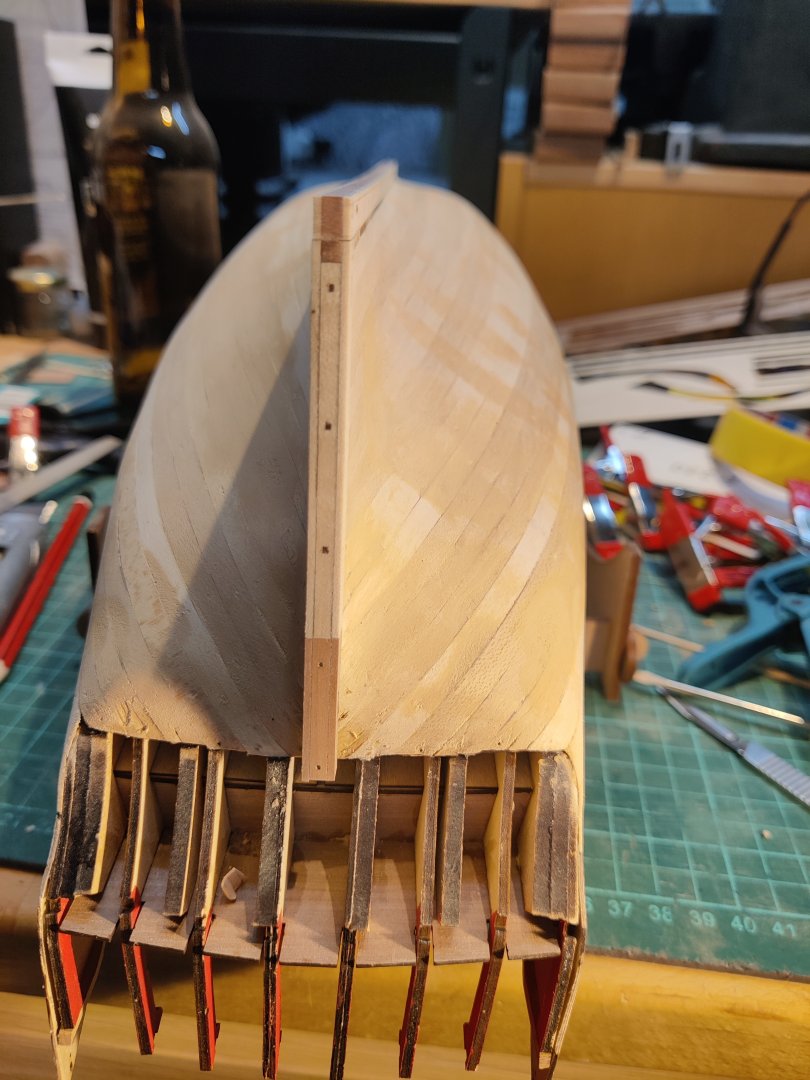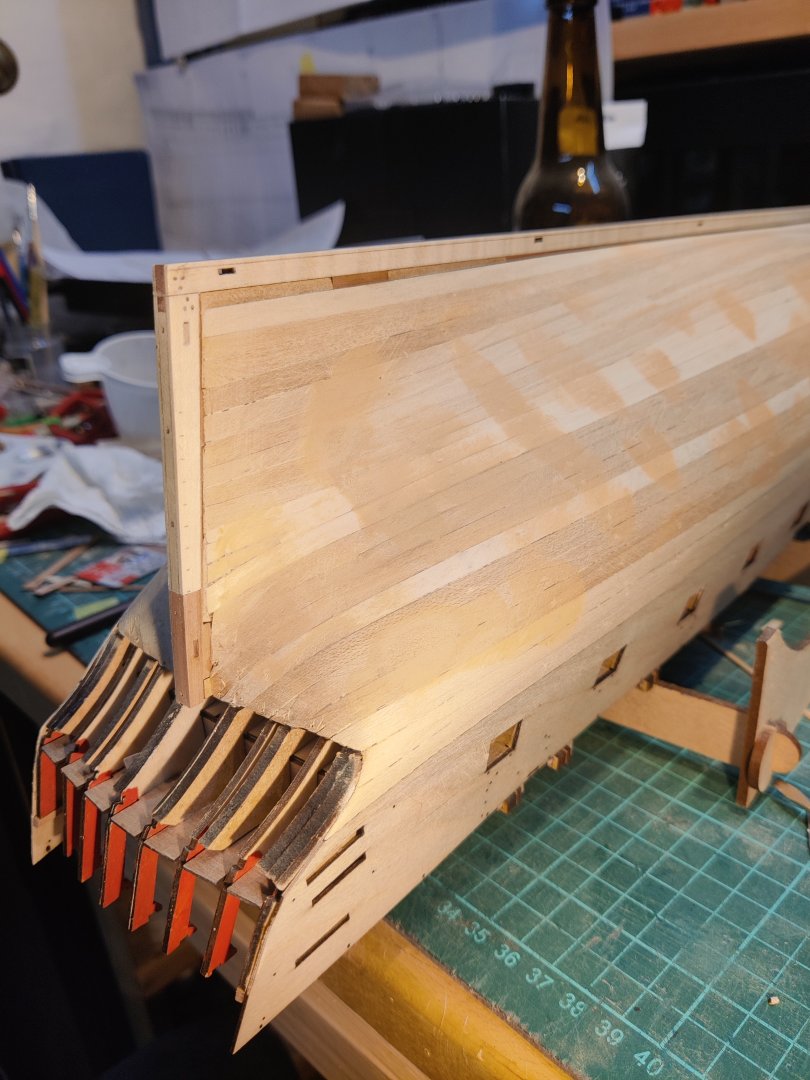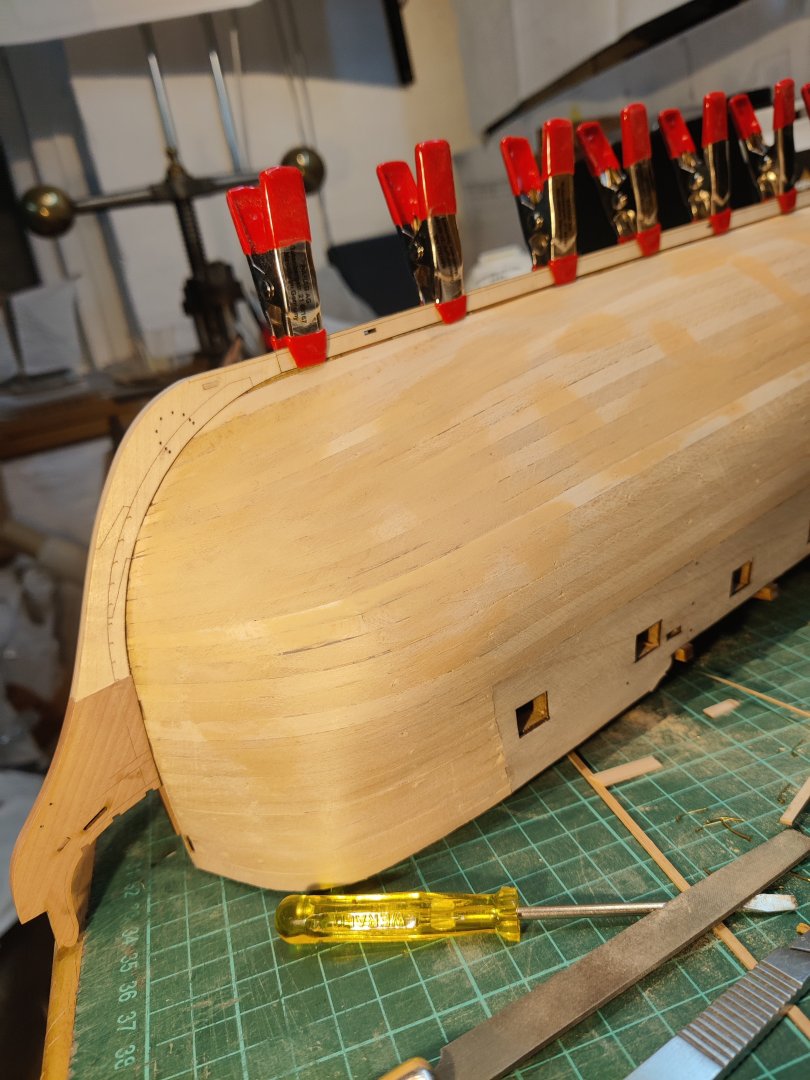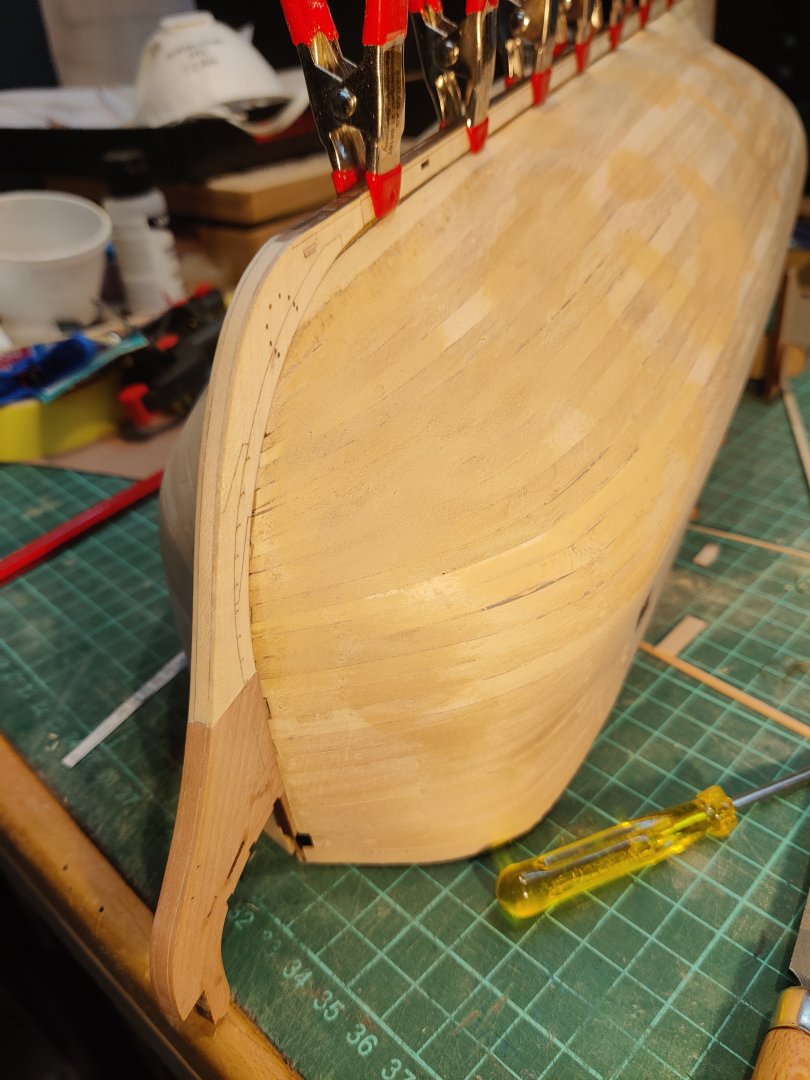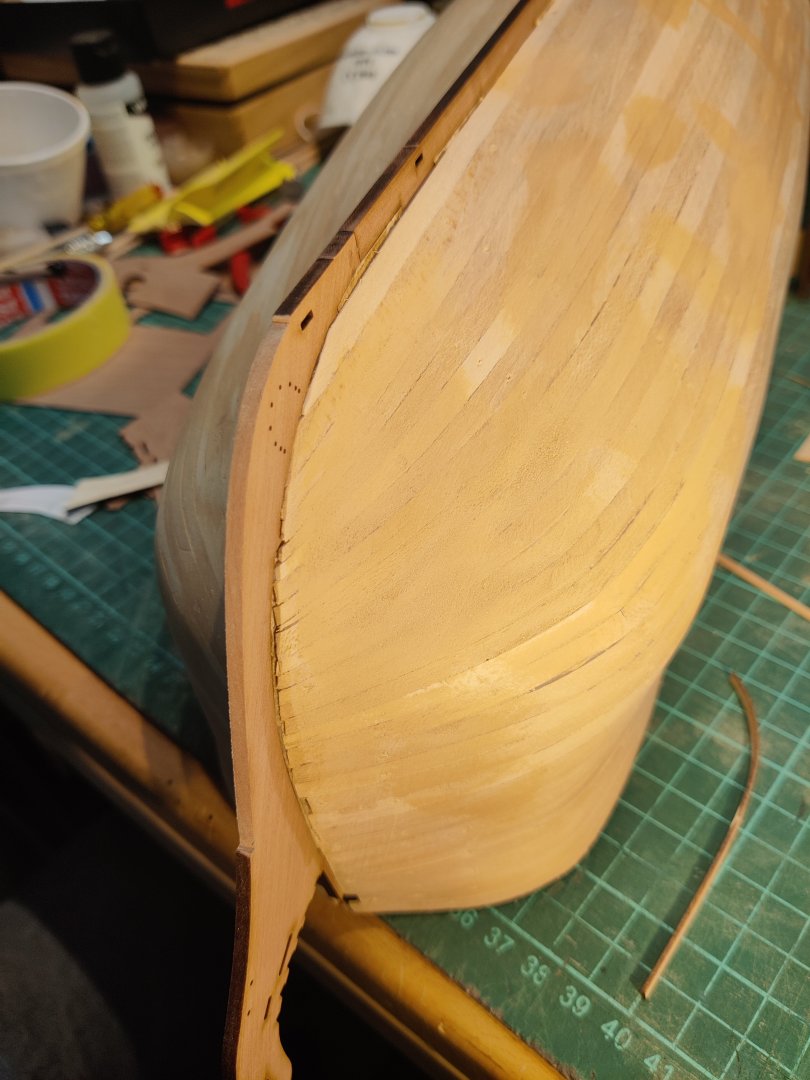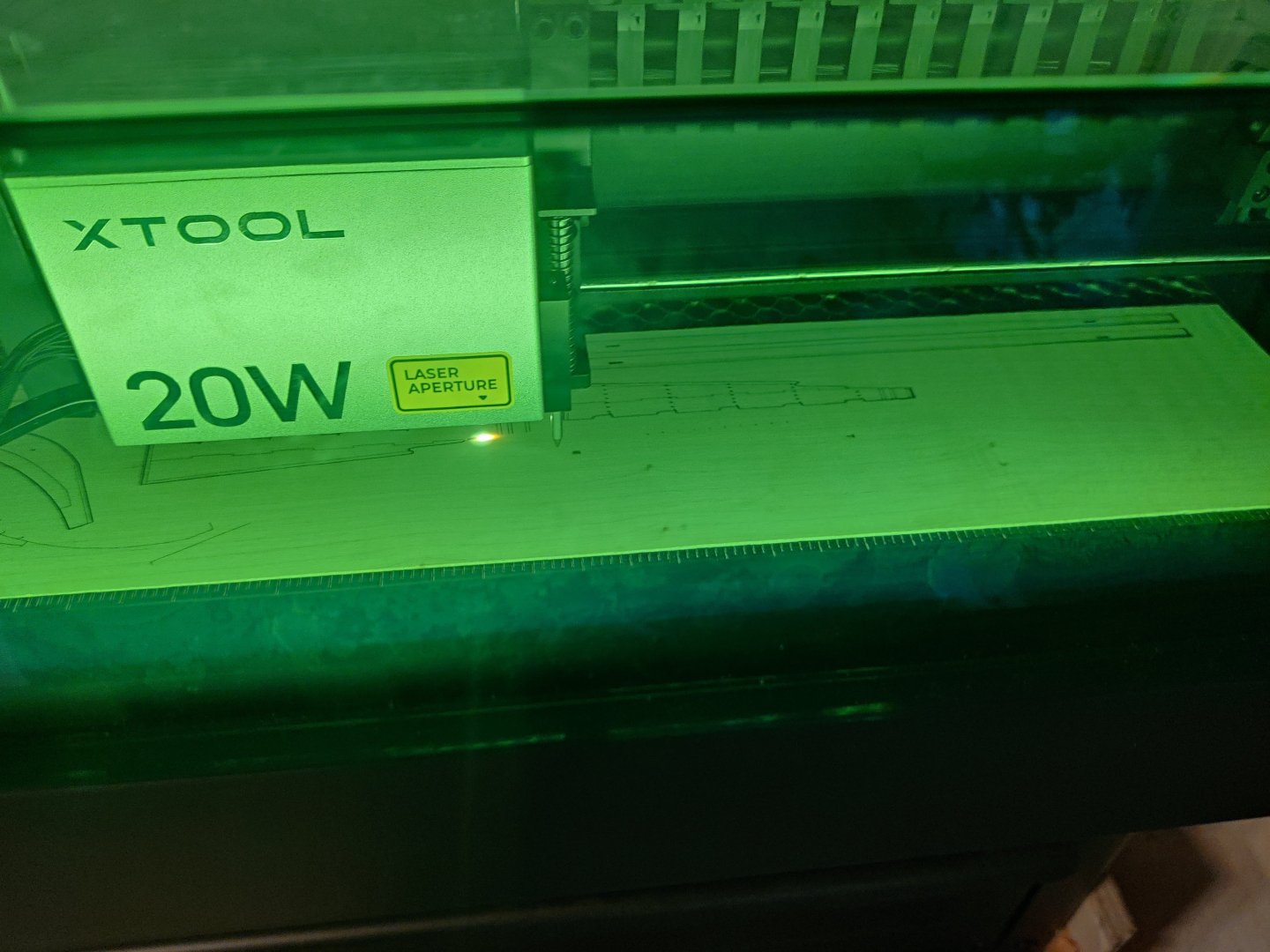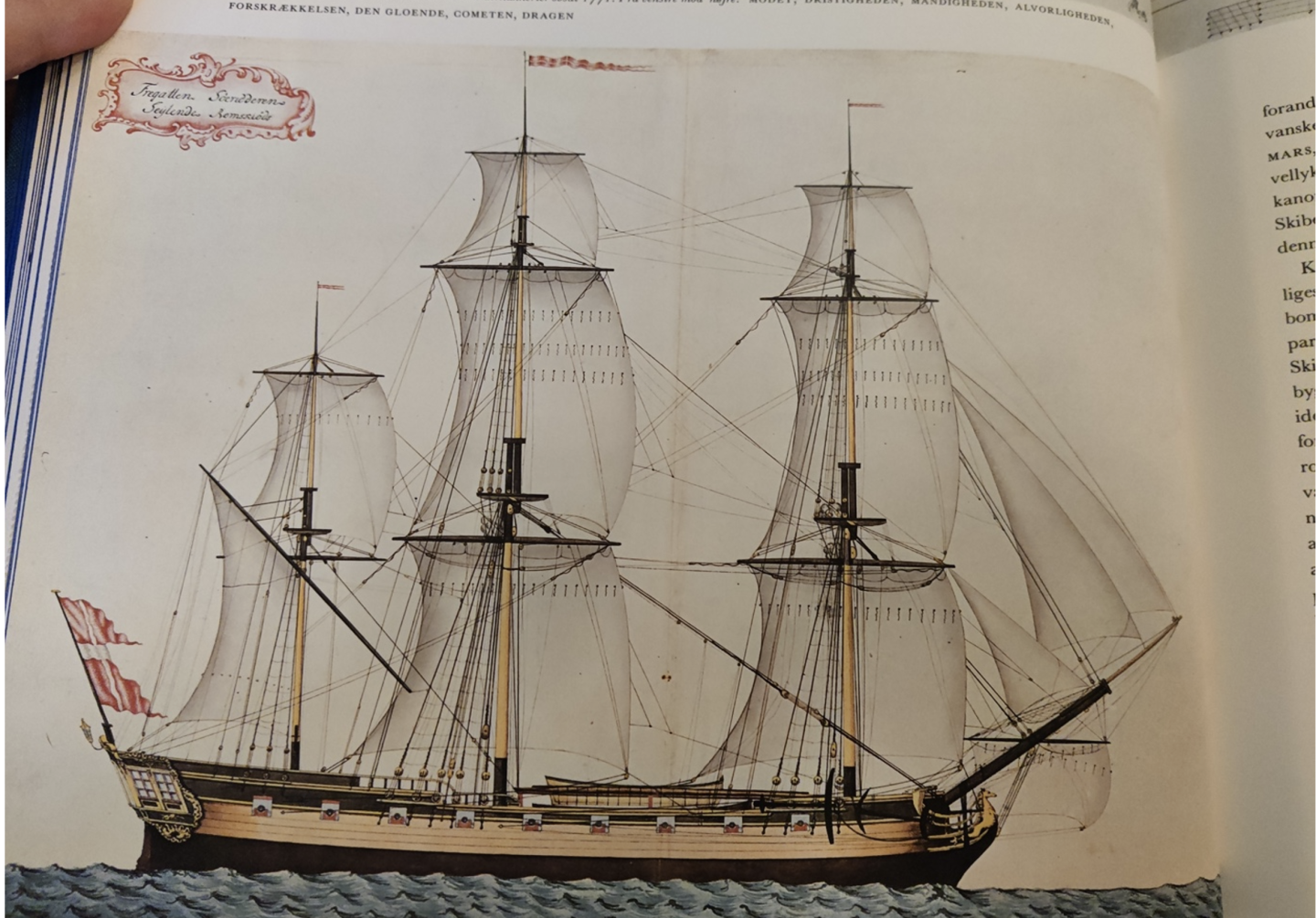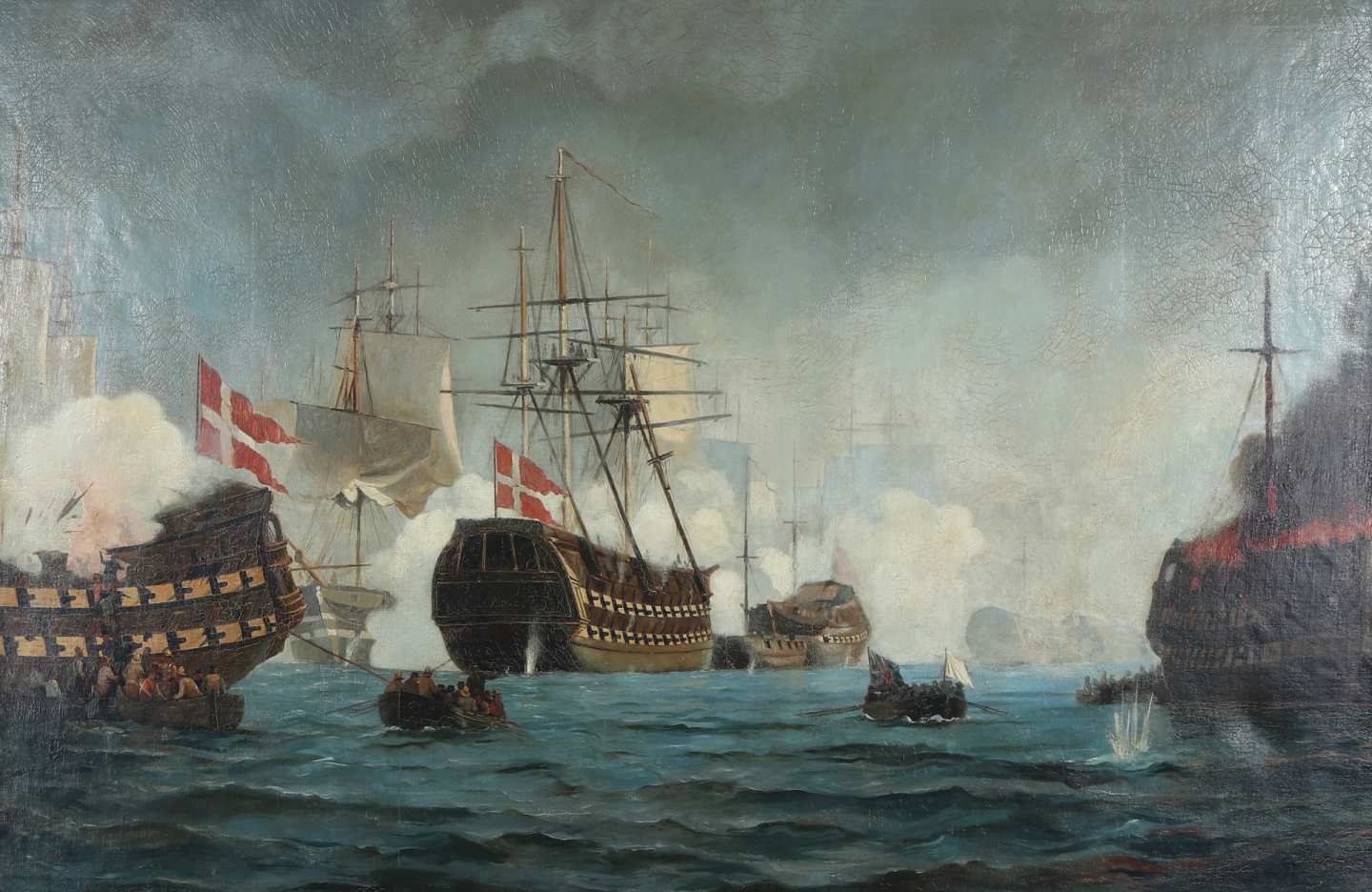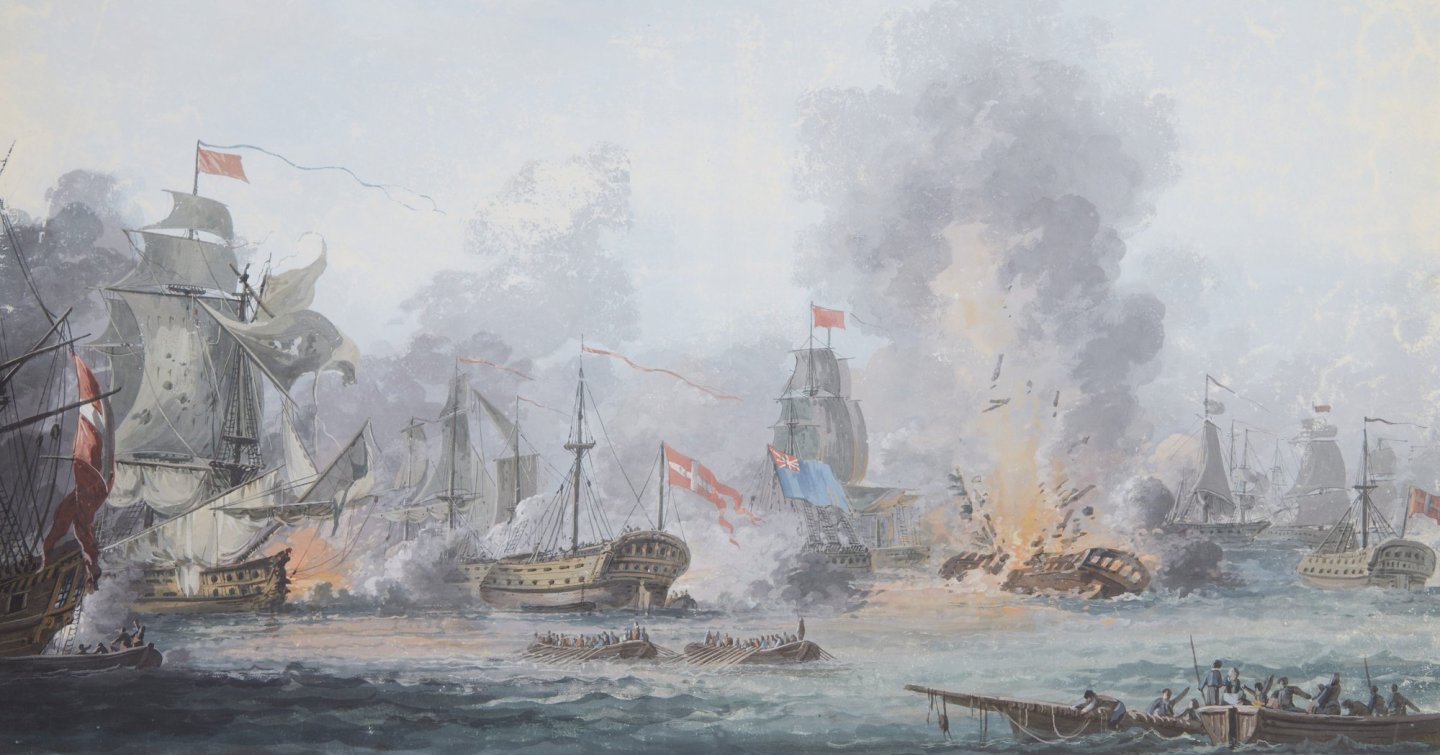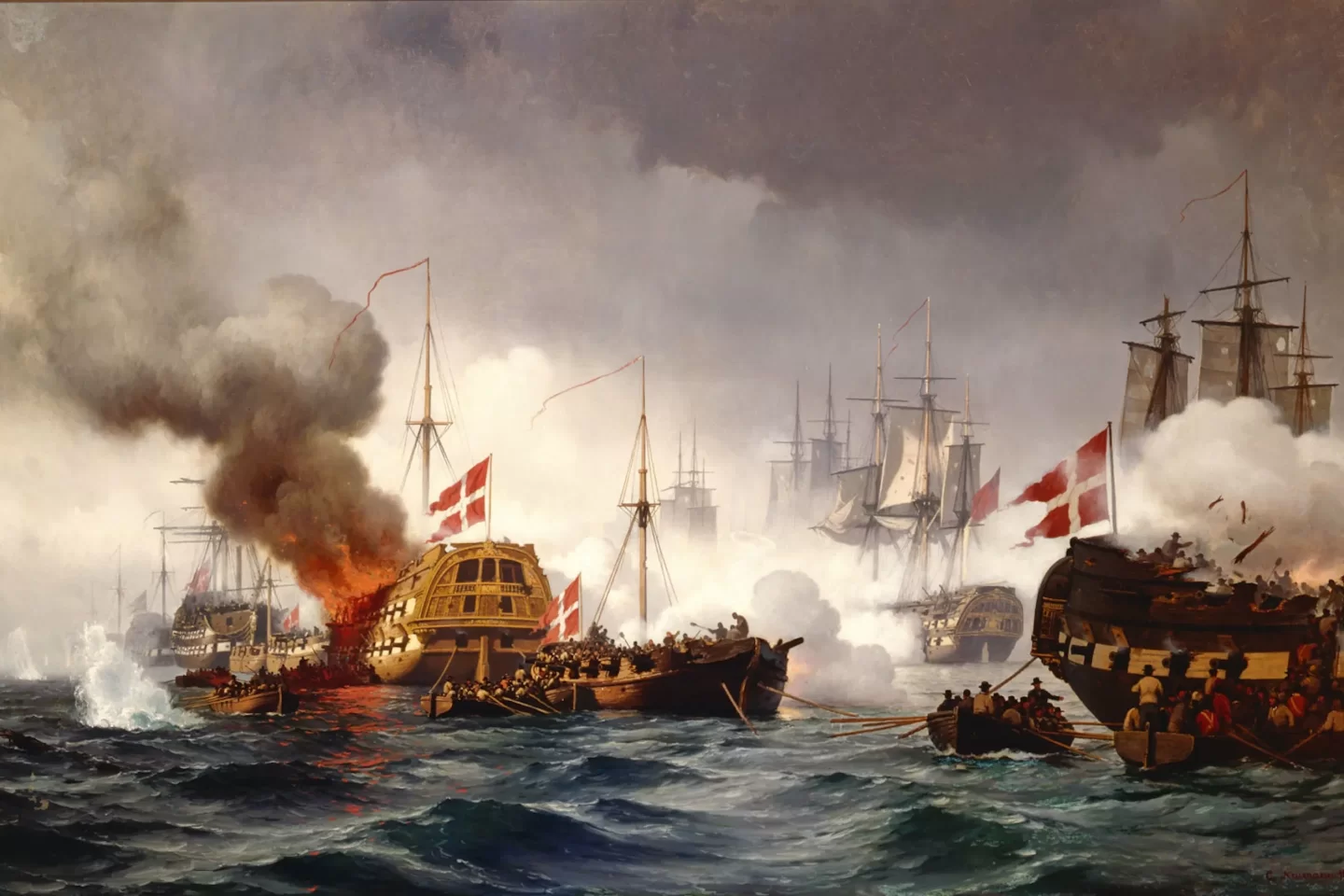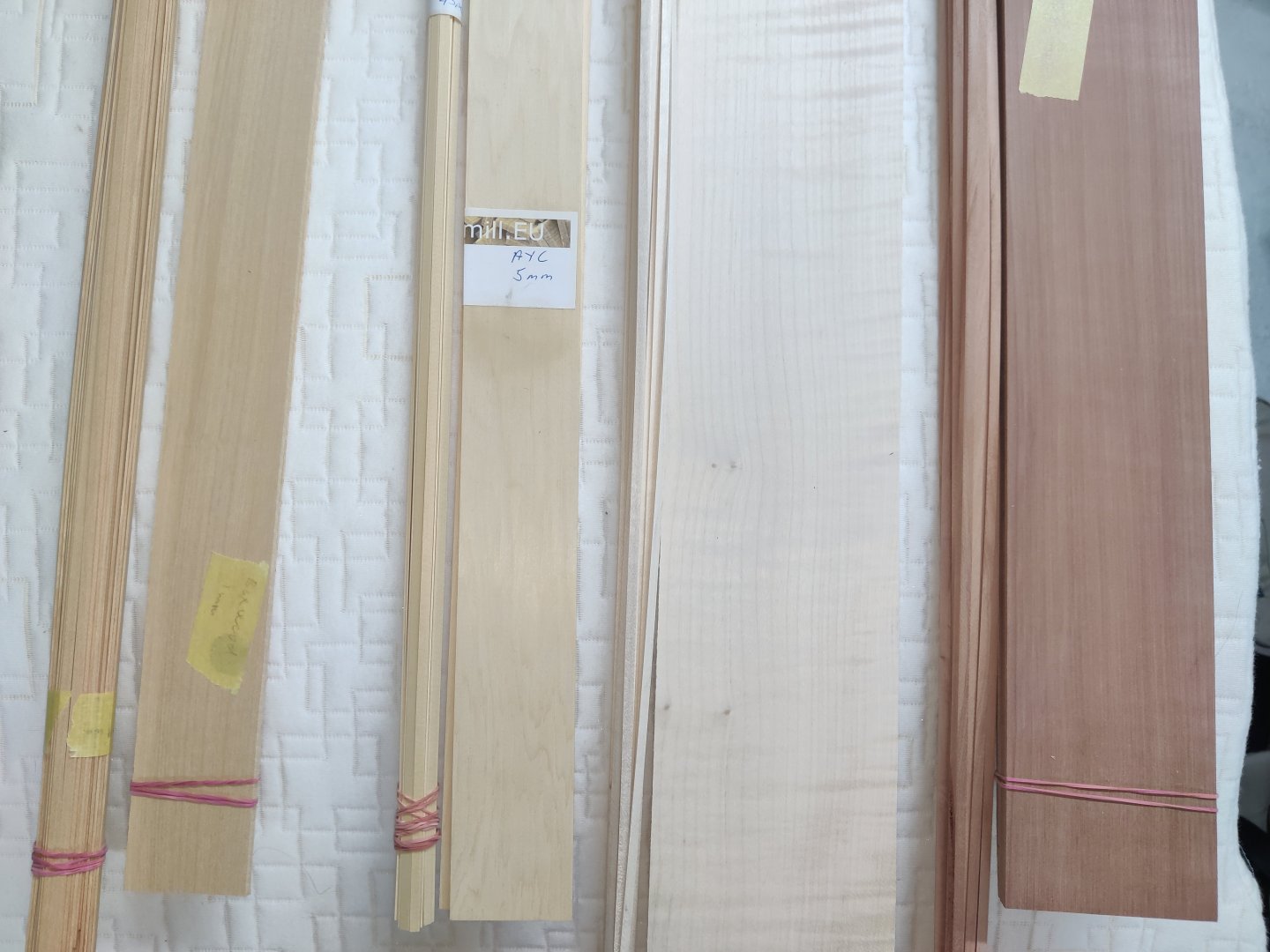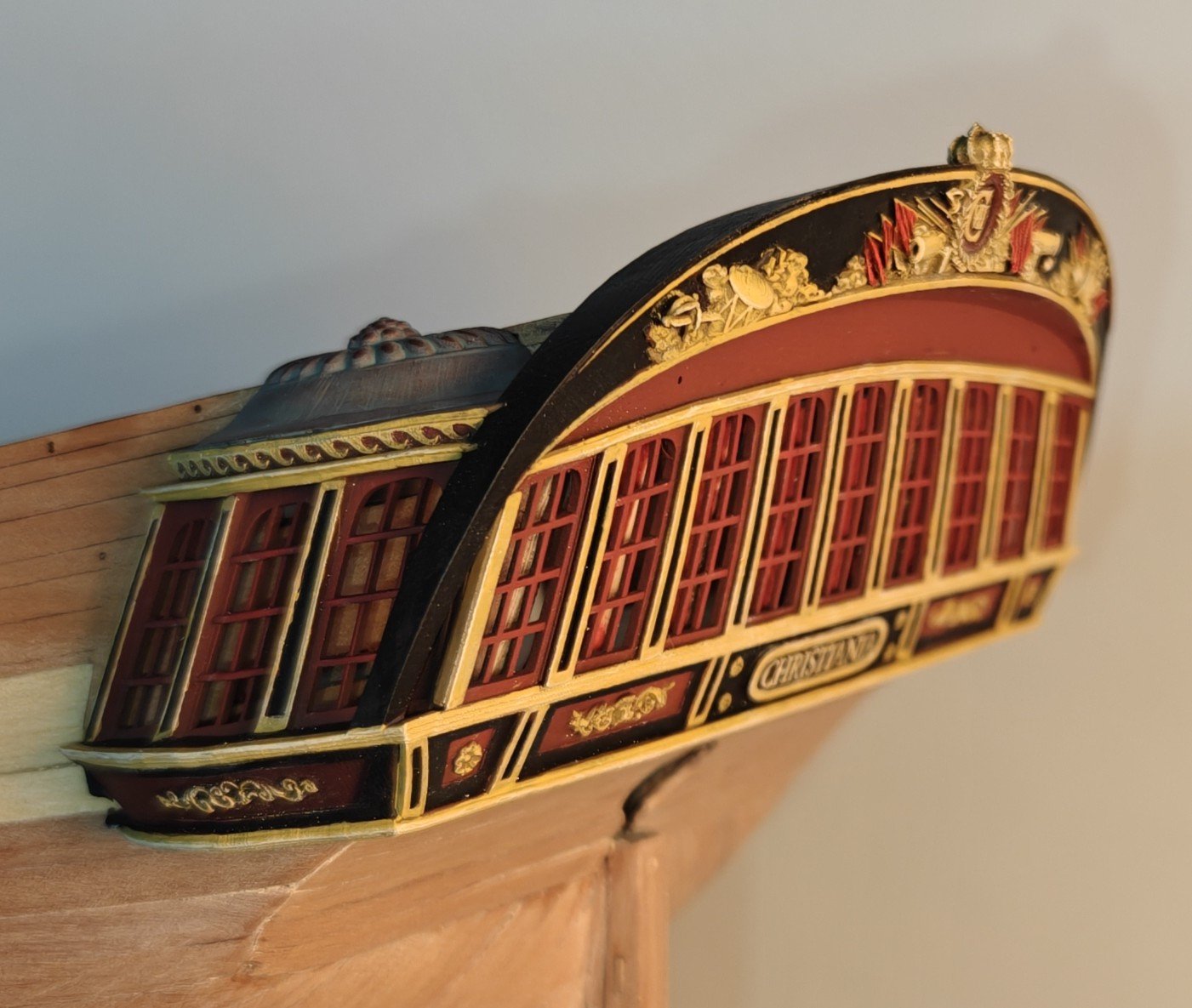
TJM
Members-
Posts
333 -
Joined
-
Last visited
Content Type
Profiles
Forums
Gallery
Events
Everything posted by TJM
-
I am looking forward to following this for sure!
- 332 replies
-
- Harpy
- Vanguard Models
-
(and 1 more)
Tagged with:
-
Log entry 20 - planking I started to draw a line parallel to the waterline and immediately realised that that was not going to work. Midships, the planks are vertical, but towards the ends, especially at the stern, the shape would require very broad planks to stay parallel with the waterline all the way. Instead, I took the time to map out even plank runs for the entire rest of the second planking. I measured at various places and printet out measuring templates to use to mark up the hull: This took a few evenings. I have started with the next planks, the first are the most difficult ast they require more shaping and it should then become easier as I get along. Including the first whole maple planks, I now have 3 on one side and 2 on the other. It takes close to an hour per plank right now so this is going to take a while. I have 25 total on either side. 😅 I can see that it wont be totally perfect, but sanding removes most of the imperfections that are there initially and the maple is very even i colour and texture. When the seams are good, they are virtually invisible, which gives a bit of tolerance for the planking job i need to achieve. I will do my best, but it is good to have a bit of wiggle room. BR TJM
- 111 replies
-
- Christiania
- Vanguard Models
-
(and 1 more)
Tagged with:
-
Log entry 19 - upper part of second planking done Hello everyone, and thanks for the likes. I have now planked down to the waterline on both sides, which is a kind of halfway milestone for the second planking. Here's both sides: So far, I am happy with by wood choices and am exited to see the final form of the hull taking shape. I have roughly sanded the starboard side and think it will turn out very nice after a good deal more sanding. Here's a few close-ups (showing all the little imperfections and scratches - many will disappear later with sanding): From the end on shots, it may appear as if the waterlines on either side are not at the same level - that is just a trick of the angles! They are at exactly the same level, I did not modify the height of the waterline marker at all when I drew them on! In real life, it looks fine. The seam between the pear and maple has turned out nice and sharp, which is a relief! After sanding it will look something like this: I will now continue below the waterline and have decided to use 12 cm segments as above. It will be a long frustrating task to use whole length planks with that much curvature on each, so to not run sour of the task, I will use the shorter sections. BR TJM
- 111 replies
-
- Christiania
- Vanguard Models
-
(and 1 more)
Tagged with:
-
This looks like a fantastic kit, as always from Chris, and beautiful presentation! The quality of Vanguard Models just keeps rising and rising 👏
- 76 replies
-
- Harpy
- Vanguard Models
-
(and 1 more)
Tagged with:
-
Log entry 18 - changing plans slightly Having tried a few times without achieving results I was happy with, I decided to change tactics. The waterline kept becoming too wobbly so I decided to lay a full length plank along the waterline. This was fairly easy to do. I used small nails along the waterline to register the plank and formed it in place with a hot iron, keeping it in place with pins: I did this on both sides and this looks much better in terms of straightness. I have then been adding a few more pear planks and this is how it looks now: Now, this changes things quite a bit in terms of planking strategy below the waterline. Obviously, the planks will not follow a realistic planking pattern as originally intended. I will instead view it as an artistic representation of the white painted hull below the waterline where you would not see how the planks run anyway. But since they will be visible in this case (if I make a good enough job and don't paint over it in the end...), I need the planks to have a aesthetically nice run. I think the best is to divide the hull in planks that run parallel to the waterline. I will just use the waterline marker to do this. That will result at quite thin planks at bow and stern, especially at the stern which will be a departure from a normal planked hull. I think it could work. But I have to decide whether to use full length planks or shorter sections like above the waterline. I feel it will now be better with full length planks for this aesthetic, but the planks have much more severe curves compared to a natural run and I am worried that I wont be able to get tight seams with full length planks! I will now plank down to the waterline with pear on both sides and the try to make a decision on the lower part then... If someone has any inputs or other ideas I'd be happy to hear them! BR TJM
- 111 replies
-
- Christiania
- Vanguard Models
-
(and 1 more)
Tagged with:
-
Log entry 17 - two steps forward, on step back... I have added another couple of plaks on both sides an am reaching the waterline. So i took the plunge and made a first attempt. It seemed to work fine, but sighting down along the hull, the waterline between the pear and the maple looked a little high in the middle. So i re-drew the waterline on top and sure enough: This looks to be 1 or 2 mm to high 😕. I only looked at this for a few minutes before deciding to rip it off and try again. I marked the planks to remove and went ahead: It came off easily enough with no damage to surroundings. I re drew the waterline: It still looks like I will have to add maple to the middle plank, but that was what turned out wrong the first time. Hmm. Time to think and then try again. I don't want to abandon the idea and paint the hull, as the wooden hull is one of the main appeals to me. I could also run a plank along the waterline and have a simple, non authentic run below the waterline, also using full plank lengths instead of the 12 cm lengths. I think that could look fine and be an aesthetic choice, but it would feel a bit like cheating with the planking! It would be much easier though. I will at least try again with the realistic run of the planks before giving up and trying the other option. BR TJM
- 111 replies
-
- Christiania
- Vanguard Models
-
(and 1 more)
Tagged with:
-
You are very welcome! And you are right, I completely forgot to mention that ships of the same construction is also shown - that sometimes adds a lot of relevant drawings to a subject! I just dont understand why, when they went to all of the trouble scanning thousands of drawings and the old analog indexes, they did not make a simple database with a tiny bit of metadata. It would have taken so little effort compared to the work already done to make a searchable database. Instead we have a digital copy of the analog archive, including the analog indexes. And then the system is just not very friendly for browsing! It takes alot of mouse clicks to go through the files! But the index does make all the difference when looking for specific ships. Another 'tool' is this site: https://trap.lex.dk/.taxonomy/4677 It lists many of the ships by class and includes a few low res images of drawings and models of interest. It is a bit inconsistent in the quality of the data, but it is a good way to find interesting ships and then go to the actual archive linked above to find the information 'first hand'.
-
Hi Matthias, I have been following your Tre Kroner build from the start with great interest. It is really fantastic work you are doing! It was partly your work on that that got me inspired to try these adaptions of plans myself - I even started with a stern section like your build! (I have just not allowed myself to progress beyond the design and test cut stage for fear of having too many active projects). I am more than happy to discuss how to best use the Danish National Archive (Rigsarkivet), though I am not sure I have the best way! It took me a while to figure out how things are organized. It can seem like a jumbled mess! There is an index by ship name accessible here: https://arkivalieronline.rigsarkivet.dk/da/billedviser?epid=17172954#190667,31951582 The entry for Tre Kroner, as an example, looks like this: The interesting part here is the section 'Tegninger hørende til skibet' (drawings belonging to the ship), as it lists the know drawings of the ship from the differen portfolios, A, B, C, D and G. The digital archives for A especially is incomplete and some of the references are not available online. This is also to some extend true for B, C and D. However, I think the missing ones are then available in one of the other portfolios, most likely G, but there are no traceability between these! For instance, A666 is not available. It likely contained either the ornamental drawing or the profile and bulkhead drawing (because it is underlined as the main file). However, these both appear in other files. The actual drawings are available here: https://arkivalieronline.rigsarkivet.dk/da/billedviser?epid=17149179#189566,31913766 And for Tre Kroner, I find these: These are A768, A1200 a-e and G2853. The others are not available online, but this is where I suspect the they may refer to one of the other files that are available! But I can't be sure of it. Note that there are two distinct copies of the ornaments - that is actually often the case! Usually, one will carry the handwritten approval by the sitting monarch, in this case the first one, A768. This is how I navigate the archive! If you have any need for help translating something from Danish, I am more than happy to help! Just send me a PM. I am just limited by my lack of knowledge of marine terminology in both Danish and English, so I run into words that I don't know the meaning of in Danish either, even though i am a native! But I'll do my best! 😁
-
Log entry 16 - an few more planks and the garboards A few more planks have been added. The pear below the yellow cedar now shows where the wales will run. I now soon have to measure up the hull to plan the tapering of the planks at the bow and have therefore added the garboard planks: This went well enough and I should be able to measure up the hull now or after one or two more planks. BR TJM
- 111 replies
-
- Christiania
- Vanguard Models
-
(and 1 more)
Tagged with:
-
Falster, 1810 - a gun brig with 18 pounders I have been eyeing one of the latest releases from Vanguard Models, the gun brig Adder, and the upcoming Harpy with interest. I like the older ships for their graceful curves, but I am impressed with the huge firepower these later brigs and sloops were carrying! When the British ran off with the entire Danish fleet in 1807, they got also 6 smaller gun brigs carrying 18 pound carronades. These were replaced by a new generation of gun brigs which carried 8 x 8 pounder long guns and 8 x 8 pounder short guns, not quite carronades, but of similar size for their poundage. This is something in between the aforementioned Adder and Harpy in terms of firepower, but with more long guns in the mix. Here's a few of the very many available original drawings: And here's one showing both the long and the short 18 pounders (actually almost 20 british pounds, as 1 Danish pound was around 1.09 British pounds): And then something a bit unique, at least I have not found other drawings like this one yet in the archive: This is basically a perspective drawing showing the rigging and deck fittings in great detail. From the PoV of adapting the plans to a PoF model, this is quite simple compared to some of the previous exercises. The plans from this late period are very easy to read and there are plenty of drawings to go with. I have only done the very basics for now, keel, bulkheads, braces and a little at the stern. And the the upper bulwark patterns: I was very surprised at the size! I should have used 4 mm mdf, not 3 mm! I of course knew how large it was by it's numbers, but it is something else to see it in real life. This is why I think these exercises are so fun! (it is a very good way of procrastinating....). It is also not very pretty, in my opinion! With it's very flat front and generally boxy shape and the slightly disordered gun port sizes due to the mixed gun types. But it does have some character! As mentioned, it is very large for a brig, I think. Here is a few comparison shots with my current Sphinx build (with modifications): It is close to as long and the deck is a good deal wider. Quite 'chunky'. Continuing with this, I would have to redo the prow parts, as the fit is not great, and modify the run of the bulwark patterns at the bow as well. I also made a mistake on the deck level on bulwark 15 and I would need the stern piece to be of ply to be able to bend it without cracking it. All of these were very good learnings and I feel that I am beginning to know what works and what doesn't, at least in these very early critical stages of the construction. Thanks for following along on this journey! BR TJM
-
Log entry 15 - catching up on planking and prow modification It has been a little while since my last update due to many things, but mainly I have been waiting to receive a waterline marker (I caved in and bought the Amati one - it is not as stable as I would have liked, but it can be made to work...) and then I have been putting off making the modification to the top of the prow - the cut-away around the bowsprit (does that have a proper name?). It was a bit scary to start taking a Dremmel to the prow! But I thought that if anythings went wrong, it would likely be salvageable - at least more so than later! So here goes: Here is the starboard side planked to the same degree as the port: I'm liking the look! Will be good to get a few more planks on to really show how it will be. Notice the prow cut-away and the waterline marked. And here's a few closeups of the prow: It looks a little rough and it will for a long time. I probably wont cover it up until I add the forecastle deck. I will just hut out suitable planks of pear and decking (likely maple) and cover the frame here. Then I can add sone details like a ladder to the forecastle and a railing on the top that fits with the forecastle bulwark. Now the planking starts in earnest and there are only 3-4 pear planks until the big challenge that will be to get a nice, even waterline between pear and maple! BR TJM
- 111 replies
-
- Christiania
- Vanguard Models
-
(and 1 more)
Tagged with:
-
Thank you for the very nice comment! Indeed, many fun features, I had also noticed the dropping deck. Indeed, it does not take too long to do this, at least not the small ships like this one and only the base structure. I think this one took around 10 hours to do in CAD, another couple to lay it out for cutting and one to cut it on the laser. I am sure it would have taken ne forever by hand and scroll saw!
-
Ørnen, Royal Yacht of Christian VII I have been away from home and with no workshop, and have therefore been adapting some more historical plans. This time I am looking at a small Royal Yacht called 'Ørnen' (the Eagle). It is a curious little vessel entirely geared towards ensuring the comfort of the monarch. It is basically a large suite with two bedrooms (labelled king's and queen's, respectively) and a living room. Midships there is a finely decorated dining hall and at the bow a kitchen with two stoves. Armament consists og 26 4 pound 'houbitzers' that seems to be essentially small swivel mounted carronades. Good for defence! Here are a few of the many original drawings: The dining hall is an interesting feature to model, and in general it would be fun to model the interior of the ship to a reasonably high level. Here are the lase cut sheets I made: Mostly 3 mm MDF and then a little 2 mm and 1 mm ply. Most of these thinner pieces I would do in pear if I was to continue with this model (I would like to, but that will be in the distant future, if ever...), but the ply is fine for checking if it works. And here are a some photos of the puzzle fitted together (very little glue for now, just at the stern and bow): And a few with the test cardboard bulwark patterns: It is a small ship, 45 cm at 1:64. Here it is on top of Bornholm from the last post: I am a bit torn on whether I like the ship due to it's curiosities or if I think it is a little ugly with that dining room protruding in the middle. But it has nice enough hull lines, and is a bit of an unicum. But now that I am back home, having spent an evening cutting this, I will get back to planking of Christiania 😁. BR TJM
-
Thanks @Knocklouder! I think my third hand may not work as it is clamped to the table. But I will see if I can make it work somehow.
- 111 replies
-
- Christiania
- Vanguard Models
-
(and 1 more)
Tagged with:
-
Log entry 14 - second layer planking start I spent a few days fitting the upper outer bulwark patterns, clamping the pre-soaked parts, allowing to dry and then going over them with a hot iron. It is really not easy to get a reasonable fit on the modified prow shape. I don't know of it would habe bee better to cut them off at the sharp bend, but in the end, I think it became good enough. I may have to sand it a little to get it all good, but as it gets painted, that should be fine. I also got the port side slightly lower that the starboard side, but only right at the sharp bend. I will just have to adjust the placement of the decorations slightly up on that side compared to the lase etched markings. I think it will be fine in the end. I then proceeded to add the first 4 planks on the port side. I had more or less decided to go with boxwood for the yellow stripe, but when I made the comparison on the model, I had a clear preference for the alaskan yellow ceder. I'm not quite sure why. There is less difference between the AYC and the maple, but it just felt right, so I went with it. Here's how it looks now: The 4th plank (pear) is also the location of the first of the two thin wales. It lines up nicely with the future elements at the prow, which is good! I will now do this on the other side as well ( pre-cut upper bulwark is in place) and then it is time to draw a waterline - I dont have a tool for this, so I must figure out how to do this. Anyone have a good way or an easy DIY tool? And then it is probably time to adress the small elephant that is the cut-away at the prow (in the bulwark around the bowsprit after the catheads). I have been putting off doing this until I had a way to be sure where the catheads went. I have that now and can use a paper cut out of the paneling patterns to get an exact template for the cut. It will only be more difficult to do it as I progress, so better do it now I guess.... BR TJM
- 111 replies
-
- Christiania
- Vanguard Models
-
(and 1 more)
Tagged with:
-
Log entry 13 I Have now proceeded with my plans to mix up the wood and hve made replacement parts for the outer keel patterns from 1 mm maple. As the inner keel would show at the bow, I filed away around 0.7 mm and added a 3 mm maple strip (lying on the desk in the bottom right if this image) I then added all the elements of both maple and pear: I think the contrast between the woods look very good and if I can manage to get a straight waterline, I think this will be good in the end. If I can manage a helf decent planking job at least. The maple is, ad expected, very hard, but that means it sands very well! I think I will take @Thukydides's suggestion and use it for the upper decks as well. The bottle in the background in some of the above images are being used to form the stern piece - also slightly modified as my stern is a bit wider, so I had to cut out a new piece. I think I may plank the outer layer. I do have 0.5 mm pear sheet, but maybe it will be more consistent to plank it as all other non painted parts will be planked. Thanks for following along! BR TJM
- 111 replies
-
- Christiania
- Vanguard Models
-
(and 1 more)
Tagged with:
-
Thanks! I tend to agree, that the one line is a bit to thin, which is also why I was considering extending the yellow to in between the wales as well. I don't think it should be extended upwards - it seems pretty consistent that the upper part of the yellow is more or less aligned with the upper edge of the gunports or a bit below this. There seem to be a clear 'division' in the plans that match those on the Sphinx very well. When looking at the painitng of Søerideren, it seems the broad yellow line is actually because the two wales were also yellow on that ship: I don't know how comon this was, but if following this, the mockup would look like this: The trouble is just that I don't really care for this look! And I know for a fact that the two thin wales for each gundeck that was common on the Danish ships of all sizes were often painted black or very dark brown. So I think I will stick to that. But the dilemma is then to decide whether to keep the line think - I agree with Ronald that it looks more harmonious - or if I extend it down between the wales, as that is maybe more realistic as Thukydides points out! Here is a few more images to compare with: On the first and third image, the battery lines does not look that thick. But all of these may depict slightly later periods than my ship. I don't know how much it changed in the 20-30 years in question. After 1807, white lines became common, so it can't be much more than 30 years after Christiania was built. Regarding using maple for the deck, I had actually not considered that! That may be a good option, thanks for that input! True! It never looks quite right in the digital images. I have all the wood in stock so I can wait a litltle with the final desicion, but I will need to make it soon-ish. Thanks a lot for your inputs, lots to consider and more comments are most welcome if you have any thoughts on my considerations 🙂. BR TJM
- 111 replies
-
- Christiania
- Vanguard Models
-
(and 1 more)
Tagged with:
-
Thanks Ronald, much appreciated! It is a good point about not using too many different colours, to have some consistency. My though was that one will simulate a raw wood deck, the other a painted colour, so perhaps they should be different? But perhaps that does not really matter, and perhaps the two are too close in colour to register as different if both were on the model... Hmmm..
- 111 replies
-
- Christiania
- Vanguard Models
-
(and 1 more)
Tagged with:
-
Log entry 12 - thinking about colours and the second planking While I am sanding the first planking layer, I am thinking about how to proceed with the second layer. I have to plan ahead as I have some ideas I want to try: I prefer to keep as much as possible unpainted to show the wood itself. But I also want as much of the colour sheme as possible to show on the final model! With flirt, I elected to not paint below the waterline, and I am very happy with that deisicion. But it does mean that the overall look is not as 'accurate'. My solution to this for this build is going to be use of different woods for different parts of the planking. Below the waterline, I intend to plank with maple - it is quite light in colour (I have only come across american holly that is whiter) and I can get thin sheets of it for laser cutting parts as well. And this is needed, as I need to make the keel and rudder parts below the waterline out of this as well! This will be a small mini project in itself. I am confident that i can do this, though it will take a bit of time, I am more worried about achieving a nice waterline between the pear and the maple. I will also use 12 cm strips to simulate planks as I did with Flirt and as @Ronald-V has done so successfully on his Sphinx. This will make it much easier to handle I hope. I intend to do the following: when a pear plank crosses the waterline, that I will mark on the inner planking, I will cut it off along the line, make a maple piece that is identical to the cutoff and the attatch both. Hopefully I can keep the waterline straight enough like this, but I do fret about this. If I manage, I think the end result could look great. Perhaps I should make a test on a small section of another model first... Apart from this, I also want to emulate the yellow band around the gunports with a yellow wood, either boxwood or alaskan yellow cedar. I will make the swivel gun supports out of the same material (eventually...). Here are a a comparison between the woods: The order is: Boxwood, Alaskan Yellow Cedar, Maple and Pear I am leaning towards AYC for the yellow band but perhaps it is too light and not actually yellow enough? I will probably end up using boxwood for the quarterdeck and forecastle planking - I would be happy enough with the laser cut deck, but my forecasle deck shape is probably too changed to use that, and then I would like everything to be consistent. But I could use boxwood for both the deck and the bulwark stripe. Any opinions of what would be best to use here? I am also considering how far down to plank with Boxwood/AYC, and have tried to make a colour mockup of two options: I am leaning towards the last one, so that there will only be yellow between upper wale and the decorated part, but I am not sure. Again, any opinions? BR TJM
- 111 replies
-
- Christiania
- Vanguard Models
-
(and 1 more)
Tagged with:
About us
Modelshipworld - Advancing Ship Modeling through Research
SSL Secured
Your security is important for us so this Website is SSL-Secured
NRG Mailing Address
Nautical Research Guild
237 South Lincoln Street
Westmont IL, 60559-1917
Model Ship World ® and the MSW logo are Registered Trademarks, and belong to the Nautical Research Guild (United States Patent and Trademark Office: No. 6,929,264 & No. 6,929,274, registered Dec. 20, 2022)
Helpful Links
About the NRG
If you enjoy building ship models that are historically accurate as well as beautiful, then The Nautical Research Guild (NRG) is just right for you.
The Guild is a non-profit educational organization whose mission is to “Advance Ship Modeling Through Research”. We provide support to our members in their efforts to raise the quality of their model ships.
The Nautical Research Guild has published our world-renowned quarterly magazine, The Nautical Research Journal, since 1955. The pages of the Journal are full of articles by accomplished ship modelers who show you how they create those exquisite details on their models, and by maritime historians who show you the correct details to build. The Journal is available in both print and digital editions. Go to the NRG web site (www.thenrg.org) to download a complimentary digital copy of the Journal. The NRG also publishes plan sets, books and compilations of back issues of the Journal and the former Ships in Scale and Model Ship Builder magazines.


